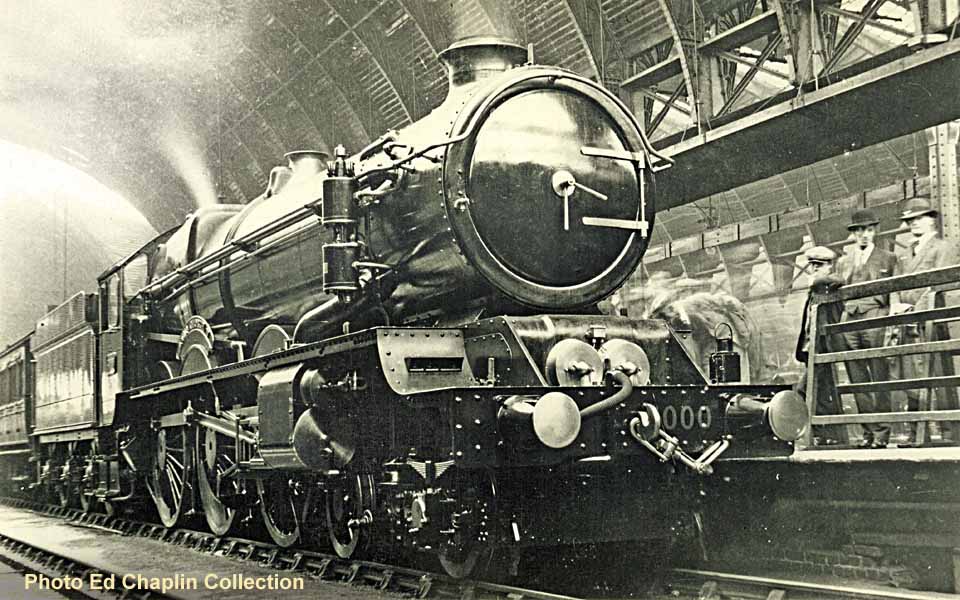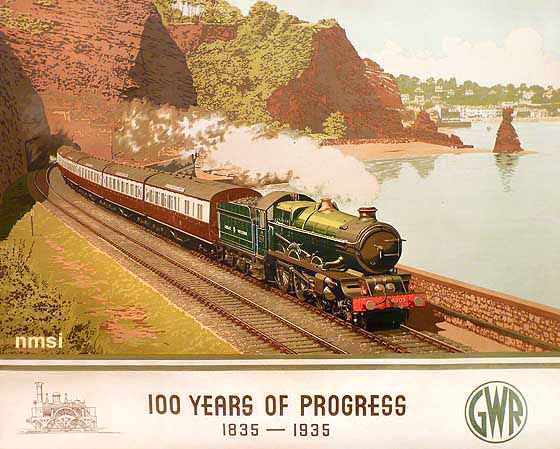
GWR KING CLASS
by
Derek Dean
Maybe it now sounds simplistic, but the natural progression in steam locomotive lineage terms, following  the most excellent 'Castle' class was a longer, larger beefed-up engine that was capable of hauling heavier trains at faster speeds. That one single ideal was the main driving force for the CME of the GWR, Charles Benjamin Collett, who was naturally intent on pursuing the beliefs of his former governor, George Jackson Churchward, the brilliant engineer who initiated the succession of GWR 4-6-0 locomotives by designing the prototype No '40' named as 'North Star' and built as an Atlantic...in other words the wheel configuration was 4-4-2. The reason he decided on this wheel arrangement was for comparison purposes, having persuaded the GWR Board members that the French De Glehn 4-cylinder locomotives were far superior to our machines
the most excellent 'Castle' class was a longer, larger beefed-up engine that was capable of hauling heavier trains at faster speeds. That one single ideal was the main driving force for the CME of the GWR, Charles Benjamin Collett, who was naturally intent on pursuing the beliefs of his former governor, George Jackson Churchward, the brilliant engineer who initiated the succession of GWR 4-6-0 locomotives by designing the prototype No '40' named as 'North Star' and built as an Atlantic...in other words the wheel configuration was 4-4-2. The reason he decided on this wheel arrangement was for comparison purposes, having persuaded the GWR Board members that the French De Glehn 4-cylinder locomotives were far superior to our machines 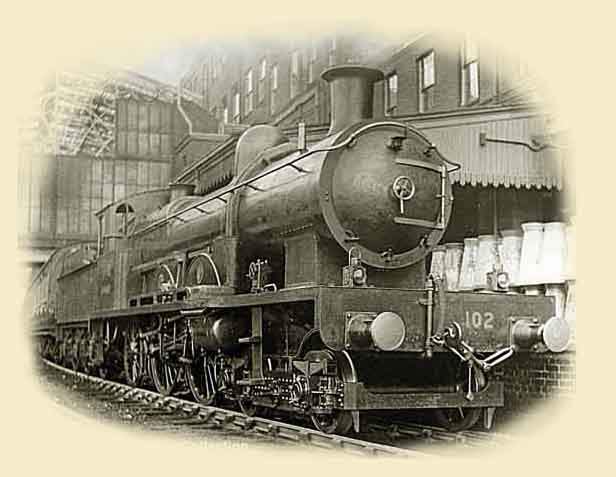 and furthermore made the case for purchasing 3 of those engines, including No 102 'La France' (left) which was used to haul the inaugural 'Cornish Riviera Express' in 1904 and continued to work the train for many years.
and furthermore made the case for purchasing 3 of those engines, including No 102 'La France' (left) which was used to haul the inaugural 'Cornish Riviera Express' in 1904 and continued to work the train for many years.
The Alfred De Glehn design was of a compound engine; high pressured inside cylinders driving the second axle, with low pressure outer assemblies motioning the first drive axle, a system recognised as 'Divided Drive' which Churchward adopted for 'North Star' and also copied the taper boiler design and replicated the Belpaire firebox, with the styling of the leading bogie also taken from the De Glehn 'Locomotive Manual'. Thus 'North Star' was the starting point for the famous 'Star' class, paving the way for the superb 'Castles', which were soon found to be both economical and powerful locomotives; capable of handling the passenger expresses of the day.
The GWR General Manager, Sir Felix Pole, had been horrified to learn that the recently constructed 'Lord Nelson' engine for the Southern Region had laid claim to be the 'most powerful locomotive in the land' taking that prestigious title from the GWR 'Castle' class. At much the same time (1926) the GWR's running department was requesting longer passenger trains to cope with increased loadings; the coal strike had highlighted the lack of reserve of the 'Castle' engines when forced to work with inferior fuel supplies; also 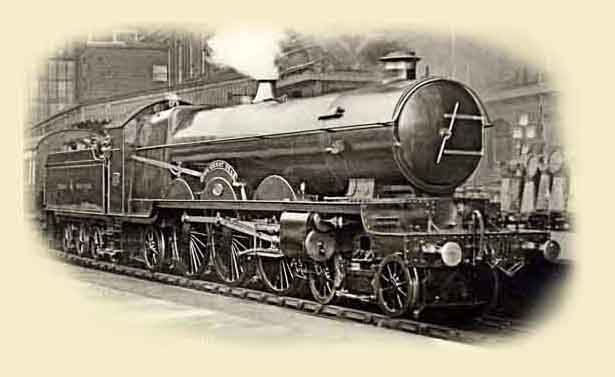 Sir Felix learned of the demise of the 'Great Bear' (right), the GWR's only 4-6-2 Pacific ever, said to have been dismantled by order of CB Collett because of the many bridge restrictions in the West Country, which effectively reduced the engine's work to the Bristol to Paddington route only. Thus the Locomotive Committee of the directors appealed to the Civil Engineer to relax the limitation on axle loading, but found that any new structures were allowed 22 tons of loading for 4-cylinder engines; furthermore there were just 4 bridges that were in need of strengthening and the Bridge Stress Committee were requested to put the work in hand as soon as possible, as well as asking for an extra half a ton leeway; this was subsequently granted.
Sir Felix learned of the demise of the 'Great Bear' (right), the GWR's only 4-6-2 Pacific ever, said to have been dismantled by order of CB Collett because of the many bridge restrictions in the West Country, which effectively reduced the engine's work to the Bristol to Paddington route only. Thus the Locomotive Committee of the directors appealed to the Civil Engineer to relax the limitation on axle loading, but found that any new structures were allowed 22 tons of loading for 4-cylinder engines; furthermore there were just 4 bridges that were in need of strengthening and the Bridge Stress Committee were requested to put the work in hand as soon as possible, as well as asking for an extra half a ton leeway; this was subsequently granted.
CB Collett was then instructed to design a larger locomotive capable of hauling 500 ton loads as far as Taunton and 360 tons unassisted over the Devon banks, with an axle load of a maximum 22.5 tons. The three ways that Collett could increase the Tractive Effort, was by increasing the boiler operating pressure; raising the swept volume of the cylinders via a longer stroke or a larger diameter (compared to the 'Castle' class) or decreasing the size of the drive wheels.
The net result was a larger boiler, very well designed by F W Hawksworth, operating at 250lb., an increased cylinder stroke to 28 inches, a longer wheelbase and a different leading bogie, producing the ultimate GWR 4-6-0 which was calculated at 39,100lb of nominal tractive effort. But Sir Felix Pole was adamant that the 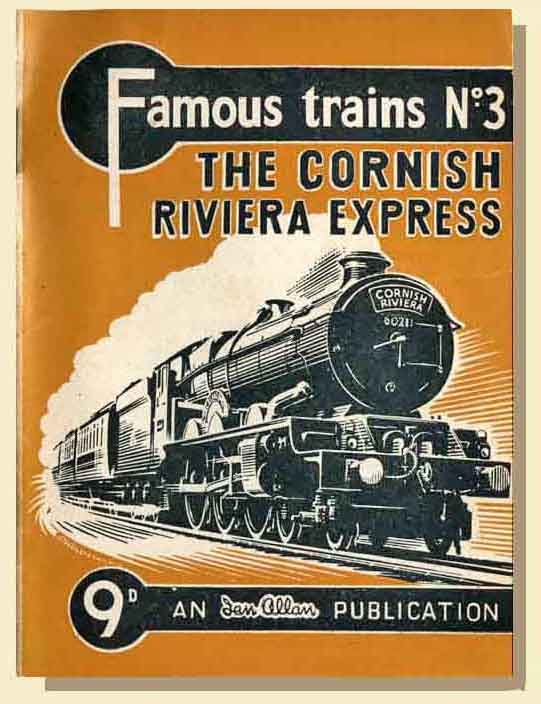 40,000 marker should be reached and obviously relished the prestige that would accompany that goal and also the reception of such an engine in America, having earlier agreed to send a locomotive to attend the Baltimore & Ohio Railroad centenary celebrations by August 1927. Charles Collett was left with no choice, but to decrease the drive wheel sizes from 6 ft 8.5 in, down to 6 ft 6 in, knowing that the decision meant new wheels had to be made, also new crankshafts and their relevant tools developed. The naming of the class was not decided and early thoughts leaned towards 'Cathedrals', but fortunately they were dropped in preference to 'Kings' starting out with the current ruler and working backwards in time.
40,000 marker should be reached and obviously relished the prestige that would accompany that goal and also the reception of such an engine in America, having earlier agreed to send a locomotive to attend the Baltimore & Ohio Railroad centenary celebrations by August 1927. Charles Collett was left with no choice, but to decrease the drive wheel sizes from 6 ft 8.5 in, down to 6 ft 6 in, knowing that the decision meant new wheels had to be made, also new crankshafts and their relevant tools developed. The naming of the class was not decided and early thoughts leaned towards 'Cathedrals', but fortunately they were dropped in preference to 'Kings' starting out with the current ruler and working backwards in time.
(Top of Page) Prior to nationalisation in 1948, the 'Big Four' railway companies commissioned a number of artists, including members of the Royal Academy, to produce artwork for railway travel posters. The companies were keen to promote the most beautiful parts of the country through which their lines served; in particular the GWR wasted no time in publicizing the holiday destinations in the West Country. Indeed during the inter-war years the popularity of many Devon and Cornish resorts was largely due to the  enterprise of the GWR's publicity machine. For example, the 'Cornish Riviera' was promoted intensively not only in the UK but also in the USA, including this fine study by Murray Seccretan of a 'King' class heading a westbound express in 1935. Click HERE to visit the NMSI Collections Online - a superb website displaying more than 230,000 objects including a range of railway travel posters.
enterprise of the GWR's publicity machine. For example, the 'Cornish Riviera' was promoted intensively not only in the UK but also in the USA, including this fine study by Murray Seccretan of a 'King' class heading a westbound express in 1935. Click HERE to visit the NMSI Collections Online - a superb website displaying more than 230,000 objects including a range of railway travel posters.
(Insert) Published by the Railway Executive (Western Region) and printed in Great Britain by Jordison & Co Ltd London and Middlesbrough, this British Railways Western Region poster, measuring 25 inch x 40 inch - 'Acceleration of Train Service - Paddington and Birmingham in 2 Hours' by AN Wolstenholme, went under the hammer for £300 at a Great Western Railwayana Auction in July 2015. The artist is best known for his superb B/W line drawings that graced the covers of many Ian Allan publications, including the famous 'abc Locospotter books', signing his work with the initials ANW, however in this colour illustration of a 'King' class locomotive 6028 King George VI at speed, he has signed his name in full.
As for my own recollections of the 'Kings' from the 1950s? The outstanding memory has to be my visits to Birmingham Snow Hill station, with that wonderful overall roof; anticipation grows for the arrival of a London express sweeping into platforms 5/6 at full tilt hauled by a magnificent 'King' class locomotive, all brass and green paintwork sparkling in the late evening sun. I can almost hear the high-pitched squeals from the carriage brakes as the whole ensemble draws to a halt and the name and number of the 'King' come into our view and the immense size of the locomotive becomes readily apparent. Maybe it was the 'Cambrian Coast Express' or the 'Inter-City', with those clean-cut cream-backed headboards only enhancing those wonderful images that still linger vividly in the memory. The 'Kings' were exceedingly photogenic, having those clearly defined lines, the immense boiler topped off with a neat, not over-sized chimney and the bulbous smokebox door creating an impressive, striking look that distinguished the class from the 'Castles'. That unique leading bogie with its all-powerful looking front stretcher frame and outside bearings; coupled with the diagonal lines of the main frames enclosing the inside valve chests enforcing a look of pure solidity that had no equal on the Western Region.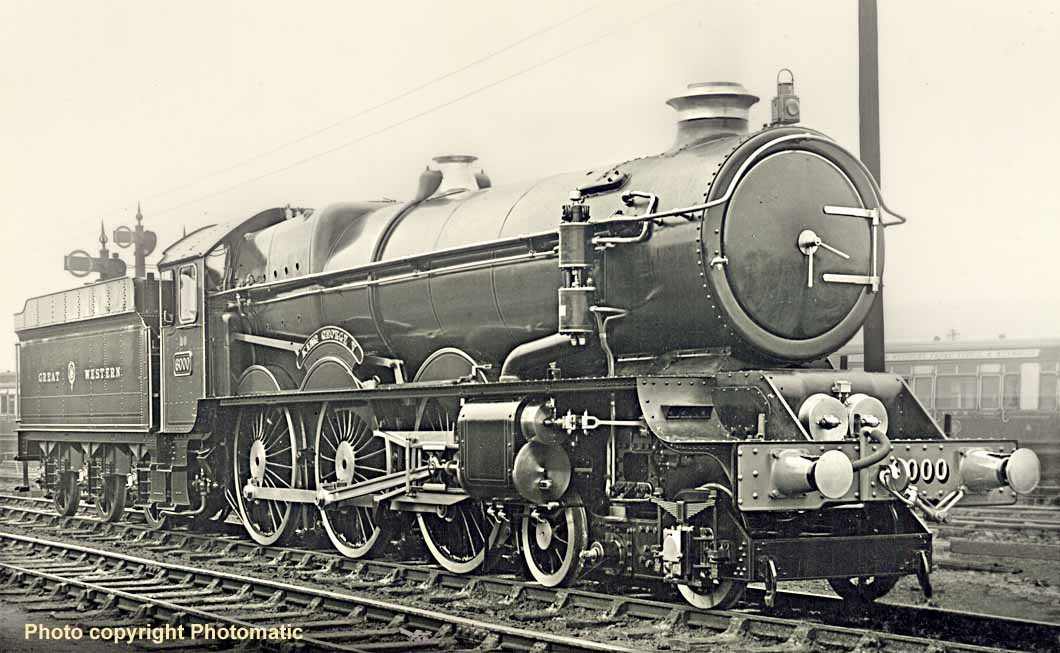
(Above-Below) My thanks to Ed Chaplin for two photographs of 6000 King George V in July 1927, with the Westinghouse brake pump fitted before going to Cardiff Roath Docks for shipment to the USA on 3 August. Ed writes - 'The first shot was taken at Swindon and the second at Paddington. Bill Peto's definitive 'Great Western Railway Locomotives Vol 1 King 4-6-0s' tells us that upon arrival at Roath Docks, the loco had to be separated at the quayside into two sections - boiler and chassis - before being loaded on to the SS Chicago City, which took it across the Atlantic to Baltimore Docks. Only a few days later, on 10 August in England, due to the partial derailment of 6003 King George IV at Midgham, Berks, new coil springs had to be quickly made at Swindon and transported by sea to the USA. Charles Collett's deputy, William Stanier, had earlier travelled with the loco, and was there to supervise their fitting at the Baltimore & Ohio workshops. That company's centenary exhibition lasted from 24 September to 15 October, and 6000 was judged to be the star of the show...'
(Above) Ex-GWR 'King' class 4-6-0 No 6000 'King George V' in pristine condition at Swindon Works, in 1955, standing in front of the Reception Shed and adjacent to the main line. The Brunswick Green livery lined with orange and black had first appeared in March 1952 following the BR experimentation with two shades of blue. Cracks in the plate frames of the leading bogie had been discovered and rectified at this time, before a flood of such defects caused the wholesale withdrawal of 27 class members in the early days of 1956. All across the Western Region, the locomotives waited their turn for repairs to modify the plate frames with additional fillets of metal welded to the upper and lower edges of the bogie side frames that were seen to be suffering stress cracking in service, with two locomotives totally failing. Before the end of 1955 any fissures found during maintenance checks were duly dealt with, but following the demise of 2 leading bogie assemblies, a major consternation developed within the Western Region committee members and the  inevitable decision was taken to withdraw all 'Kings' from service with immediate effect. Thus from January 1956 No 6000 was one of only three to remain in service because extensive repairs had been carried out three months prior. It is also worth noting that the hard work put in by the early engines (from July 1927) was really starting to bite around this date and November 1955 saw 15 (50%) of the Kings out of service for a variety of reasons. It is also worth noting that the engine now has a sleeveless chimney fitted and the middle lamp iron has always been of different variety to the rest of the class since the brass bell was fitted, although the centre iron was rarely used in service.
inevitable decision was taken to withdraw all 'Kings' from service with immediate effect. Thus from January 1956 No 6000 was one of only three to remain in service because extensive repairs had been carried out three months prior. It is also worth noting that the hard work put in by the early engines (from July 1927) was really starting to bite around this date and November 1955 saw 15 (50%) of the Kings out of service for a variety of reasons. It is also worth noting that the engine now has a sleeveless chimney fitted and the middle lamp iron has always been of different variety to the rest of the class since the brass bell was fitted, although the centre iron was rarely used in service.
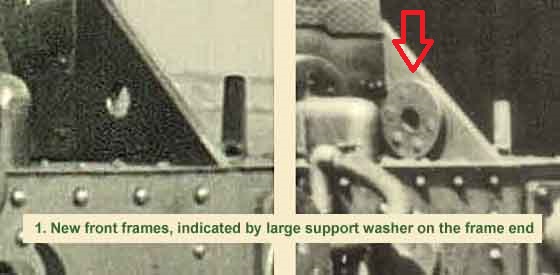
BR MODIFICATIONS
1. New front frames, indicated by the large support washer on the frame end, not yet seen.
2. Extended covers for inside valves added later [1958].
3. Modified steam pipes [1953].
4. WB boiler [04/52].
5. Cast-iron double chimney added later [12/56].
6. Mechanical lubrication unit [now in first position].
7. Leading bogie has welded repairs done [09/55].
8. Cab roof vents inserted [1954].
9. BR new emblem added in June 1958.
10. Raised step over the inside cylinders, below smokebox, not yet fitted, but the first stage has been completed by the addition of the diamond treadplate there.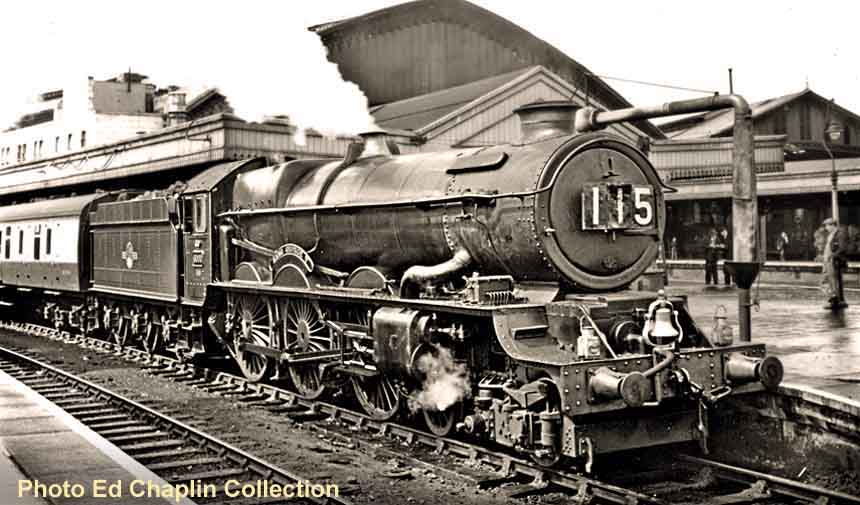
(Above) Ex-GWR 'King' class 4-6-0 No 6000 'King George V' ready to leave Bristol Temple Meads Station in the latter part of 1958 [date estimated but reflects a new emblem added to the tender although facing forward ie to the right which was incorrect] and is also allowing for the taper buffers still extant. All of the British Railways modifications (ie from 1948) have now been completed including the elliptically shaped cast-iron double chimney, a feature which, coupled with the revised draughting arrangements, was seen to give the class a new lease of life and effectively helped the engines to give their best performances to date. The picture angle highlights the varying alignment of the 3 wheel splashers, which was different again on the nearside of the engine. This would seem to be platform 9, which was designated as the north eastern end of the station and combined with platform 8 it formed a total length of 1,340 feet. The 'one with the bell' the youngsters cried when King '6000' came into view, the only class member to be easily recognised by virtue of the famous brass bell. On rather a damp day the doyen of the class was ready to depart for London displaying a rather 'tatty' reporting number, which seemed to indicate a Weston-super-Mare working.
BR MODIFICATIONS:
1. New front frames, indicated by the large support washer on the frame end, now seen.
2. Extended covers for inside valves now added [03/58].
3. Modified steam pipes [1953].
4. WB boiler [04/52].
5. Cast-iron double chimney [12/56].
6. Mechanical lubrication unit [in final position].
7. Leading bogie has welded repairs done [11/55].
8. Cab roof vents inserted [1954].
9. BR new emblem added [facing wrong way] in June 1958.
10. Raised step over the inside cylinders, below smokebox, was fitted 1956.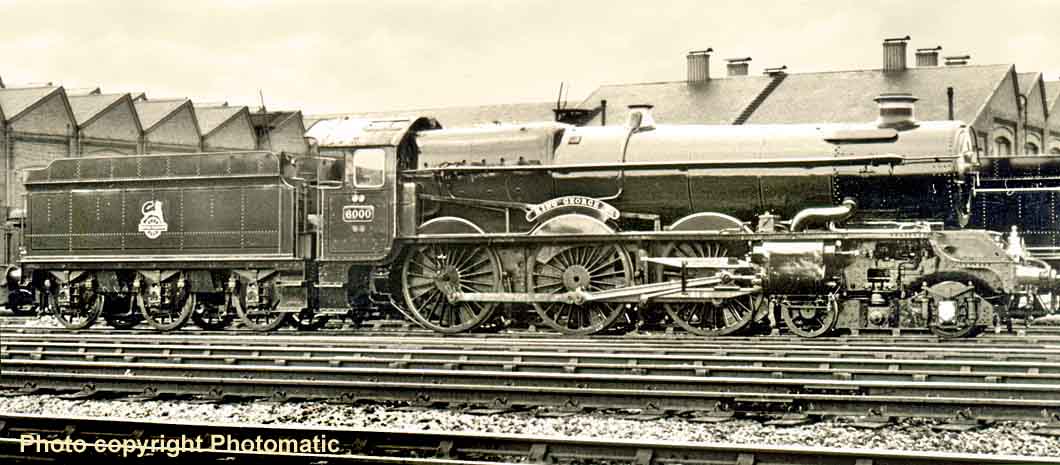
(Above) Ex-GWR 'King' class 4-6-0 No 6000 'King George V' almost ready for a return to service at Swindon Works yard in September 1955. The side-on view allows us a different aspect and the 'rods down' pose shows up the web in-fill on the drive wheels best picked out on the rear driver at the 5 o'clock position, an extension of the journal for the coupling rod, adding strength to that section. The central area of the leading bogie assembly has seen welding repairs carried out to strengthen the sectors which succumbed to the stresses of main line running with the heaviest of expresses for so many years, although such problems only surfaced in the early 1950's. It is interesting to note that the third axle has a 'deeper' road spring, which is just visible through the wheel spokes and replaced the original 19-leaf type to give a much 'softer' ride after crews made complaints of the engines 'bucking' along. That change followed on from the even earlier switch from the original 'balance beams' set-up, fitted to the first 20 engines, to three independently hung road springs on each side, giving a more stable and much softer ride. The mechanical lubrication unit was added to work in conjunction with the WB boiler so that oil feed to valves and cylinders was incremented and constant to cope with the extra heat generated by the larger superheater.
BR MODIFICATIONS
1. New front frames, indicated by the large support washer on the frame end, not yet seen.
2. Extended covers for inside valves added later [1958].
3. Modified steam pipes [1953].
4. WB boiler [04/52].
5. Double chimney added later [12/56].
6 Mechanical lubrication unit is still in first position [from 04/52].
7. Leading bogie has welded repairs done [09/55].
8. Cab roof vents inserted [1954].
9. BR new emblem added [facing wrong way] in June 1958.
10. Raised step over the inside cylinders, below smokebox, not yet fitted.
(Above) Ex-GWR 'King' class 4-6-0 No 6000 'King George V' at Wolverhampton Stafford Road coaling stage in the latter part of 1957 and showing an old BR emblem, WB type boiler, a double chimney, modified steam pipes, mechanical lubrication unit (in forward and final position), (SC) plate on with raised step over inside cylinders. Weld repair is visible on the upper edge of the leading bogie, while taper buffers are still in use [affixed with 4 stud-bolts] not yet upgraded to the straight type which were held by 8 stud-bolts and the front end was still in original condition with short inside valve covers and no frame lifting support washers as yet. It was the very distinctive leading bogie that enabled knowledgeable 'spotters' to differentiate between a 'Castle' or a 'King' as an express approached at speed; the front axle was carried in bearings that were outside of the frames to allow room for the inside cylinders, while that large central protuberance was the adjuster for the coil spring to hold the locking plates in, but allowed lateral movement when the locomotive negotiated tight curves. A solitary slotted bogie was constructed by Swindon Works following the derailment of '6003' in 1927, and the unit was to be well utilised throughout the class, with 'King George V' paired with the unit on two occasions; firstly in the summer of 1931 and once again in December 1956. The Old Oak Common (81A) engine has been turned and has reversed upto the coaling stage for a refill (while still in reverse gear).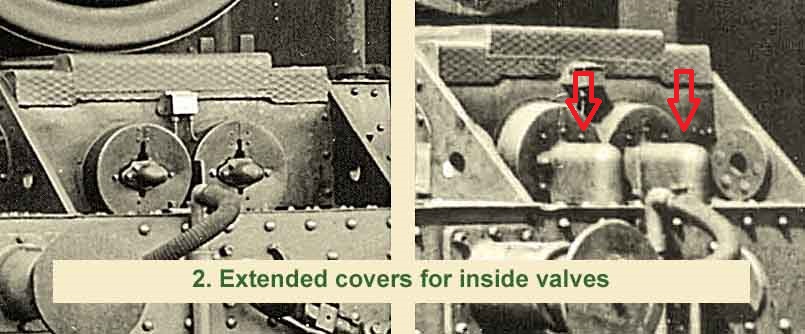
BR MODIFICATIONS
1. New front frames, indicated by the large support washer on the frame end, not yet seen.
2. Extended covers for inside valves added later [1958].
3. Modified steam pipes [1953]
4. WB boiler [04/52].
5. Double chimney now added [12/56].
6. Mechanical lubrication unit [now in final position].
7. Leading bogie has welded repairs done [09/55].
8. Cab roof vents inserted [1954].
9. BR original emblem added [new emblem on 24/06/58].
10. Raised step over the inside cylinders, below smokebox, now fitted.
6001 King Edward VII
(Above) Ex-GWR 'King' class 4-6-0 No 6001 'King Edward VII' viewed at Birmingham Snow Hill Station and is poised to leave platform 7, which was always the selected one for the Paddington express services and possibly the magnificent 'Kings' did not have clearance room on the outer platforms (1 & 12). This view from early in 1956 depicts the locomotive fitted with a fabricated sheet-steel double chimney, one of 15 class members so fitted, basically while waiting for the cast-iron version to be formulated and in turn each 'King' had the later type fitted by the middle of 1958. The engine was subjected to testing at Swindon during April and July 1953 to record the performance data following draughting alterations and those results persuaded WR that the whole class should be upgraded. Those changes basically entailed a longer and narrower chimney coupled with a smaller diameter blastpipe to the detriment of accelerated wear and tear if the engines were then to work harder. It could be argued that was indeed the case as the 'King Crisis' erupted early in 1956, but how much was attributed to the new draughting over and above the plain fact that the engines were approaching 28-29 years old. '6001' was now a resident of Wolverhampton Stafford Road depot after 27 years spent at Old Oak Common, so the locomotive was a regular visitor on the Birmingham Line.
BR MODIFICATIONS:
1. New front frames not ever fitted.
2. Extended covers for inside valves were not added.
3. Modified steam pipes [1953].
4. WB boiler [03/53].
5. Fabricated double chimney [02/56].
6. Mechanical lubrication unit [fitted in first position].
7. Leading bogie had welded repairs done [01/56].
8. Cab roof vents inserted [1954].
9. BR new emblem not yet added [3/12/57].
10. Raised step over the inside cylinders, below smokebox, still to be added.
(Above) Ex-GWR 'King' class 4-6-0 No 6001 'King Henry IV' strides elegantly along the edge of platform 10 at Paddington Station, Brunel's masterly achievement. Completed in 1854, the 3 curved aisles were most certainly 'Cathedral-like' and many locospotters over the years have paid homage to its construction, but mainly to its locomotives. This image from RW Hinton shows many young lads admiring the uncluttered lines of the second 'King' to be constructed in 1927. Following the poor performance of classmate '6018' in the Locomotive Exchanges of 1948, Swindon Works set about 'saving face' somewhat, although any criticism was tempered by the excellent showing of 'Castle' class No 5000 'Launceston Castle' at that time. Draughting of the 'Kings' was viewed as a priority and experiments began with '6017', continued with '6001' in 1953, culminated in a road test of hauling near 800 tons (25 coaches) from Reading to Stoke Gifford near Bristol. Recorded data from the run in July 1953 showed an increase of more than 30% in its steaming ability, achieved from utilising a longer, narrower chimney liner coupled with a sleeved blastpipe. The unqualified success of the improvements led to all class members receiving the same modifications in due course, along with the continued upgrade to WB boilers, the performance advances were seen as most satisfactory. The engine only worked from two depots; 27 years from Old Oak Common (PDN, then 81A) and the remaining 8 years were spent working the Birmingham Line, based at Wolverhampton Stafford Road (84A), as it was in the above image dated from August 1958.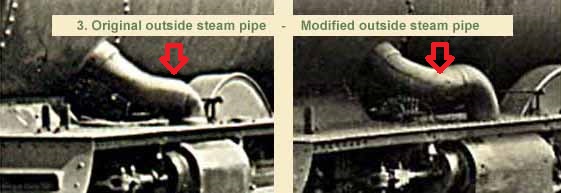
BR MODIFICATIONS
1. New front frames, indicated by the large support washer on the frame end, were not fitted.
2. Extended covers for inside valves were not changed from new [short].
3. Modified steam pipes [1953].
4. WB boiler [03/53].
5. Fabricated double chimney initially, now cast-iron type added [12/57].
6. Mechanical lubrication unit [now in first position].
7. Leading bogie has welded repairs done [02/56].
8. Cab roof vents inserted [1954].
9. BR new emblem added on 03/12/57.
10. Raised step over the inside cylinders, below smokebox, added 1956.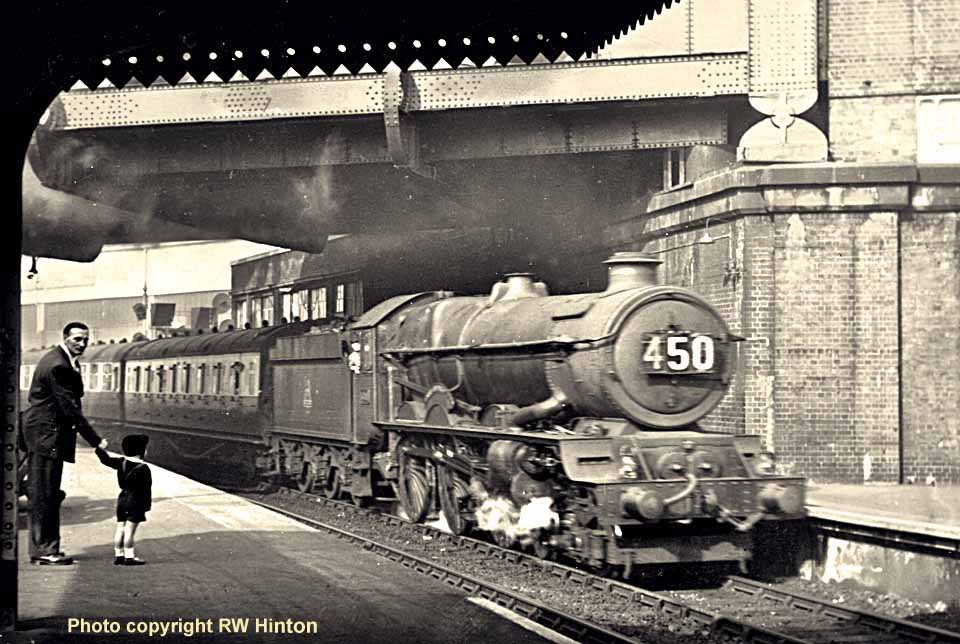
(Above) Ex-GWR 'King' class 4-6-0 No 6001 'King Edward VII' enters Paddington station as perceived by eminent photographer, RW Hinton, late in 1953, along with a very young enthusiast. Train reporting number '450' is designated as the 07.00 Weston-super-Mare to Paddington service (see Ed Chaplin's Page 23). The image reflects the engine's very scruffy condition following extensive testing at Swindon Works on the 'test plant' and on the 'open road', but it was because of the concerted efforts of the team at Swindon, in the revised draughting operations, that the outside steam pipes were not modified during 1953, but almost certainly altered in the early part of 1954, along with the fitting of cab roof vents. In November 1955, the leading bogie was replaced while undergoing a Heavy General repair at Swindon Works, seemingly because of failure, as the engine was recorded as 'waiting' at Banbury for one week before entry to Swindon. Soon afterwards the majority of the class were removed from service pending urgent repairs to their leading bogies, prompting the loan of LMS 'Coronation' Class Pacifics '46254' and '46257', followed by 2 'Princess Royal' Pacifics; '46207' and '46210' and also eight Class 5MT 4-6-0's (Stanier 'Black Fives') to help out with express services until order was restored. The frames of the bogie were subject to stress at all times, but that increased as the locomotive overall weight rose and then heightened as the engines were worked harder and driven faster.
BR MODIFICATIONS:
1. New front frames, indicated by the large support washer on the frame end, were not fitted.
2. Extended covers for inside valves never changed from original.
3. Modified steam pipes were fitted later [possibly 1954].
4. WB boiler [03/53].
5. Single chimney still extant [double version 12/56].
6. Mechanical lubrication unit [now in first position].
7. Leading bogie has no repairs done yet.
8. Cab roof vents not yet inserted.
9. BR original emblem added [new emblem on 03/12/57].
10. First stage step over the inside cylinders, below smokebox, now fitted. 
(Above) Ex-GWR 'King' class 4-6-0 No 6001 'King Edward VII' leaves Paddington station in the summer of 1956, after bringing in a 'Birmingham Line' express from Wolverhampton. This side-on image allows a more intrinsic view of all the components of a 'King' locomotive including the contour of the steam pipe casing (not the actual pipe) which seems to accentuate the unusual position of the cylinder assembly. The outer connecting rod needed to be the same length as the inboard equivalent, which motivated the first axle and this was the operating principle of a 'Divided Drive' giving better balanced running at speed, more even weight distribution and certainly reduced the 'hammer blow' on the rail track. The unique leading bogie can be well perceived from this side-on view, the additional strengthening strips can be seen between the centre-point of the bogie and the front axle; this engine is believed to be one of the first to break down with the complete failure of the side member of the bogie, a very serious issue. A very good model of the relevant position of the gear lever is afforded here; the long rod from the cab, operated capstan-style by the driver, sets the lever at the required setting and can be clearly seen between the first and second axle splashers. A minor difference of '6001' was that the offside cab window was narrower than those fitted the rest of the class; a relic of the early type speedometer equipment and can be clearly observed from this image as the engine moves carefully backwards towards Ranelagh Bridge yard for servicing.
BR MODIFICATIONS
1. New front frames not ever fitted.
2. Extended covers for inside valves were not added.
3. Modified steam pipes [1953].
4. WB boiler [03/53].
5. Fabricated double chimney [02/56].
6. Mechanical lubrication unit [fitted in first position].
7. Leading bogie had welded repairs done [01/56].
8. Cab roof vents inserted [1954].
9. BR new emblem not yet added [3/12/57].
10. Raised step over the inside cylinders, below smokebox, is now added[09/56].
6002 King William IV 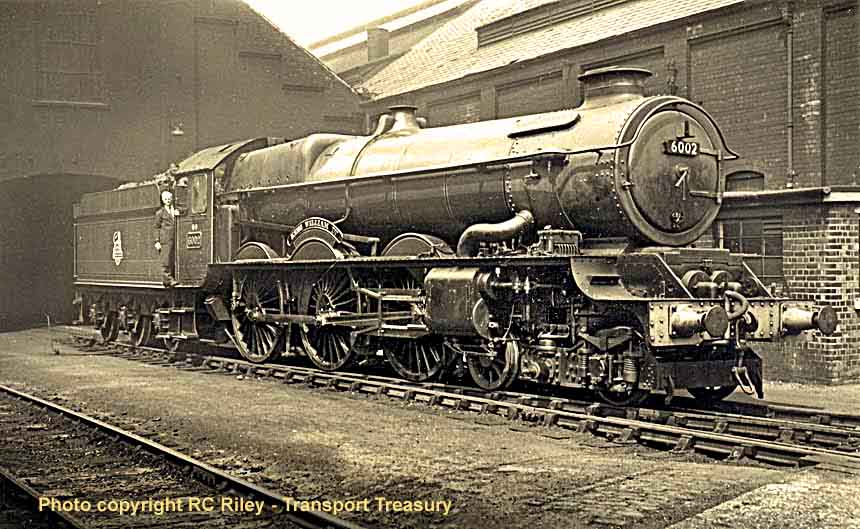
(Above) Ex-GWR 'King' class 4-6-0 No 6002 'King William IV' posed at Old Oak Common for the renowned photographer, RC Riley who was a gem for historians like myself, noting all relevant data along with his excellent images, which now rest with Transport Treasury. Early version of a double chimney is most prominent, displaying its straight sides and upright end sections, fitted just two months before this image was captured, in May 1956. Because the WB boiler was fitted rather late in the day in relative terms, the mechanical lubrication unit was added forward of the outside steam pipes in the first instance, Swindon Works having realised the advantages of that position in terms of access to the inside motion bearings. On close inspection, the welded repairs to the leading bogie can be picked out; fillets of steel added to either side of the centre section of the plate frames, on the top and lower edges. The somewhat strange position of the outside cylinder assembly can be well realised here, and to an inexperienced eye, as it was my own, the fitment could, perhaps should have been further forward, but the position was governed by the need to balance out the driving motions, so that the outer connecting rod matched the inboard equivalent, allowing fast and very smooth running, which was a top priority for express passenger engines. The engine was earmarked for performance tests at the end of May 1956 and I would suggest that this photo was a precursor to those events, and were recorded by the eminently renown Mr. Oswald Stevens Nock on three trials, one run between Birmingham Snow Hill and Paddington and a further two in the West Country. Results from the dynamometer car showed that the double chimney gave a marked improvement over a single chimneyed 'King' and in direct comparison to Coronation Pacific No 46237 'City of Bristol' recorded the previous year, the 'King' had better coal consumption.
BR MODIFICATIONS:
1. New front frames, indicated by the large support washer on the frame end, now seen.
2. Extended covers for inside valves now fitted [03/56].
3. Modified steam pipes [1953].
4. WB boiler [03/56].
5. Fabricated double chimney 03/56 [later form fitted 11/57].
6. Mechanical lubrication unit [first fitted in forward position].
7. Leading bogie had welded repairs done [03/56].
8. Cab roof vents inserted [May 1954].
9. Early emblem added [new crest 12/57].
10. Raised step over the inside cylinders, below smokebox added. 
(Above) Ex-GWR 'King' class 4-6-0 No 6002 'King William IV' is running into Reading General Station hauling the 'Mayflower' service to Paddington on Thursday, 26 March 1959. The train is entering the up relief platform at Reading to stop. This was one of the very few WR trains left which ran with a slip coach, however on this Thursday, and on several Fridays in the peak summer season, the slipping was not done, the train stopped at Reading instead. This was to attach a pilot loco that had come from Reading shed, so as to give Paddington a loco and a crew for an extra holiday down train later in the day. BR's inaugural train was motioned on 17th June 1957 and No 6000 'King George V' was the engine used for the run from Plymouth to Paddington, with additional coaches from Kingswear added at Newton Abbot, but the reign of the 'King' on this train was to be very short-lived as diesels took over its haulage the following year, in 1960. The engine moved around the sheds more than most, although only 7 depots could accommodate them, and was one of only three 'Kings' to be allocated to Exeter shed (EXE), having spent three short spells there during and just after WW2. Inevitably the engine became an Old Oak Common (81A) regular for more than 11 years, but mainly was allocated to Plymouth Laira (LA), starting from there and returning on no less than 5 occasions.
BR MODIFICATIONS:
1. New front frames, indicated by the large support washer on the frame end, now seen.
2. Extended covers for inside valves now fitted [03/56].
3. Modified steam pipes [1953].
4. WB boiler [03/56)
5. Fabricated double chimney 03/56 [later form fitted 11/57].
6. Mechanical lubrication unit [final position].
7. Leading bogie had welded repairs done [03/56].
8. Cab roof vents inserted [May 1954].
9. BR new emblem added [12/57].
10. Raised step over the inside cylinders, below smokebox added. 
(Above) Ex-GWR 'King' class 4-6-0 No 6002 'King William IV' poised at Exeter St. Davids station in 1961, as seen by Jim Oakley, who always possessed a good eye for a photograph. BR's new corporate logo can now be viewed on the tender, but this engine did sport the early 'garter' design which was frowned upon by the Royal College of Heraldry and was promptly removed from the first 6 engines to be replaced by a 'GWR' logo that was referred to as 'shirt button' because of its diminutive size. When British Railways took command a straight forward statement of ownership was applied to the tender until the newly designed 'lion and wheel' emblem could be produced in large numbers to satisfy all engines on all Regions. This latest emblem made its bow in June 1956 on a BR 'Britannia' class engine and began to appear on 'Kings' from March 1957, but the class was not in complete unison until June 1958. The number '6002' was previously carried by a 2-8-0 ROD engine, built as No 1841 in 1918 and purchased by GWR in September 1920; however the condition did not satisfy the running department and it was returned. It resurfaced on the LNER as No 6255, then 3756 and finally 63756, being allocated at Colwick, working the Nottinghamshire coalfields traffic. A slight difference of cylinder bore size was made when '6002' was first built, being a quarter of an inch smaller than the rest of the class and this fact only came to light because the engine was used to compare notes with '6005' after complaints were made concerning the latter's performance.
BR MODIFICATIONS:
1. New front frames, indicated by the large support washer on the frame end, now seen.
2. Extended covers for inside valves now fitted [03/56].
3. Modified steam pipes [1953].
4. WB boiler [03/56].
5. Cast-iron elliptically-shaped double chimney from 11/57.
6. Mechanical lubrication unit [in final position].
7. Leading bogie had welded repairs done [03/56].
8. Cab roof vents inserted [May 1954].
9. BR later emblem added [seen from 11/57].
10. Raised step over the inside cylinders, below smokebox added.
6003 King George IV 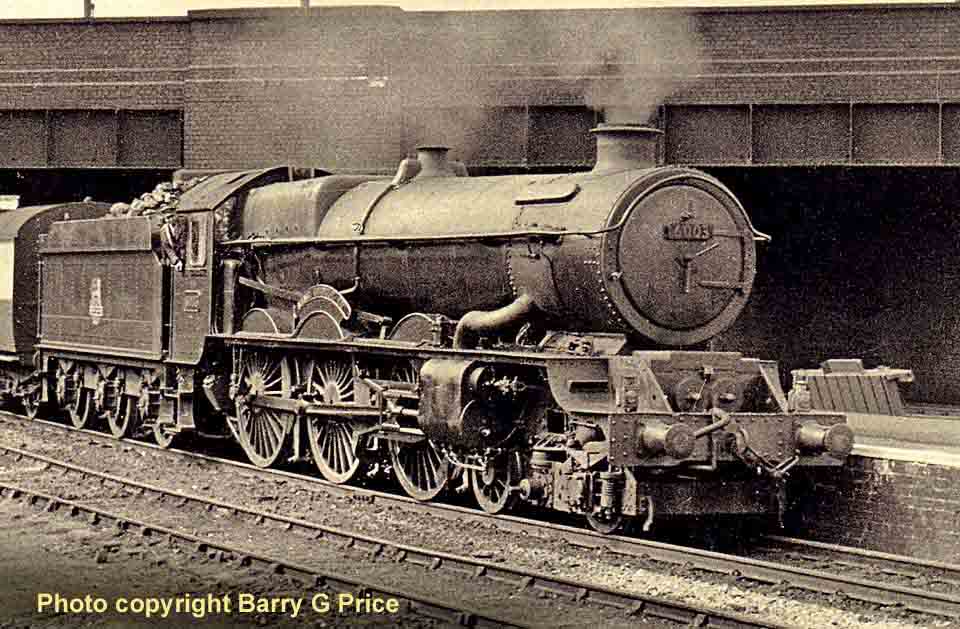
(Above) Ex-GWR 'King' class 4-6-0 No 6003 'King George IV' arrives at Wolverhampton (Low Level) in readiness for the dash towards Birmingham Snow Hill station and onto Paddington. Wolverhampton (Low Level) station was the regular starting point for the 'King' class and basically the furthest north the engines were allowed officially on the 'Birmingham Line' due to an elderly bridge at Shifnal 12 miles away. The line between Wolverhampton and Birmingham included Bilston, Wednesbury, West Bromwich and Hockley, is basically the same route now covered by the Midland Metro Light-Rail System. This very fortunate locomotive survived an early scare when just one month into its long allocation at Old Oak Common it derailed whilst hauling the 'Cornish Riviera' at around 60mph at Midgham between Newbury and Reading, but luckily the locomotive remained wholly on the track and caused no injury to crew or passengers. However an investigation into the accident created much consternation when it was discovered that the 'soft' springing of the leading bogie was the root cause, therefore new heavy duty helical coil springs were added to the ends of the four multi-leaf springs to stiffen the whole assembly. This 1956 image was captured by Barry G Price, the well known Railway Artist, showing an engine in need of a repaint and some modifications; since it had not been to Swindon Works for major work for some time. In April 1954 the engine was subjected to a dynamometer car test to check and verify the proposed accelerated times for the 'Bristolian'. No 6003 was chosen because it was the first 'King' available with improved draughting; this was created by a long sleeve fitment to the (single) chimney and a narrower diameter blastpipe. The work was carried out under the direction of Mr Samuel Ell at Swindon. Cardiff Canton (88A) depot was the only other allocation for '6003' which moved there in September 1960 for 18 months before withdrawal in late June 1962, then becoming one of ten 'Kings' cut up at Swindon Works. No 6003's accrued service mileage of 1,920,479 was the fourth highest of the class which equates to an average of 55,000 miles for each of its 35 years in existence, but if we total up its out of service period of 290 weeks, the average then becomes a very creditable 64,000 miles per annum.
BR MODIFICATIONS:
1. New front frames, indicated by the large support washer on the frame end, not ever fitted
2. Original covers for inside valves, remained that way
3. Modified steam pipes [1953]
4. WB boiler [10/52]
5. Single chimney still prominent [until 04/57].
6. Mechanical lubrication unit [now in first position].
7. Leading bogie had welded repairs done [02/56].
8. Cab roof vents inserted [1954].
9. BR early emblem extant [new version from 04/57].
10. Now raised step over the inside cylinders, below smokebox. 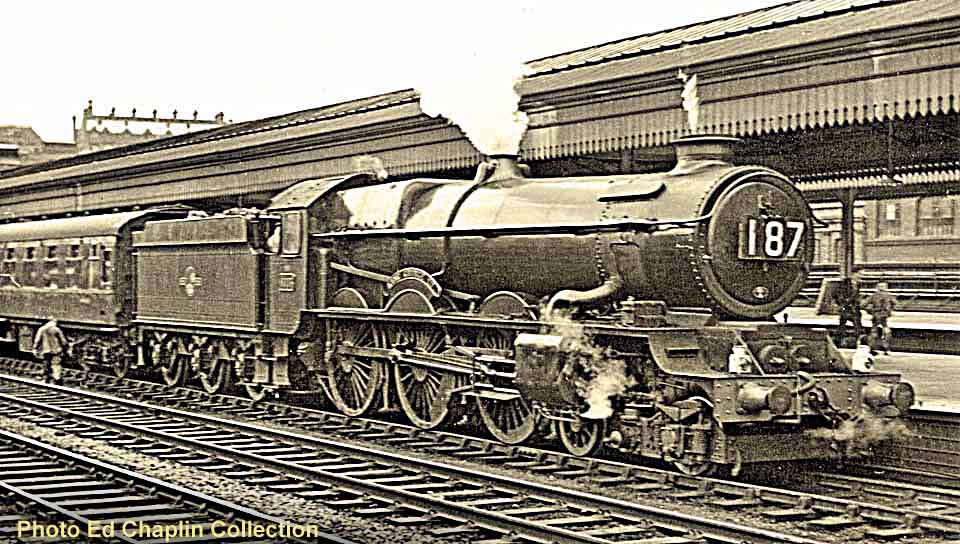
(Above) Ex-GWR 'King' class 4-6-0 No 6003 'King George IV' is ready for the dash from Birmingham Snow Hill station to Wolverhampton (Low Level) in the early months of 1958. Train reporting 187 is nominated as the 09.10 Weekdays, Paddington to Birkenhead, which would have a loco change at Wolverhampton, then Chester before reaching its destination. The engine never was allocated to (84A) Wolverhampton Stafford Road, but as an Old Oak Common resident for over 33 years, it would have seen the inside of Snow Hill Tunnel on many occasions. Apart from the latest BR Corporate emblem which had yet to be inverted to show the correct position (facing left), the engine was now in its final condition and survived an early scare just one month into its service at Old Oak Common, when it was derailed at Midgham whilst hauling the 'Cornish Riviera' at 60 mph. Fortunately 6003 remained on the track and the incident caused no injury. In 1954 the engine undertook a measured speed trial over the 'Bristolian' route with the purpose of trimming the running schedule and attained a recorded 98 mph, albeit with a lightly loaded train. The engine's sleeveless type chimney was replaced with a cast-iron elliptically shaped double chimney, as sported by only two other class members. Cardiff Canton (88A) depot was the only different allocation for '6003' moving there in September 1960 for a period of 18 months before withdrawal in late June 1962.
BR MODIFICATIONS:
1. New front frames, indicated by the large support washer on the frame end, not ever fitted
2. Original covers for inside valves, remained that way.
3. Modified steam pipes [1953].
4. WB boiler [10/52].
5. Cast-iron double chimney [from 04/57].
6. Mechanical lubrication unit [now in final position].
7. Leading bogie had welded repairs done [02/56).
8. Cab roof vents inserted [1954].
9. BR new emblem added [facing wrong way] 04/57.
10. Raised step over the inside cylinders, below smokebox.
6004 King George III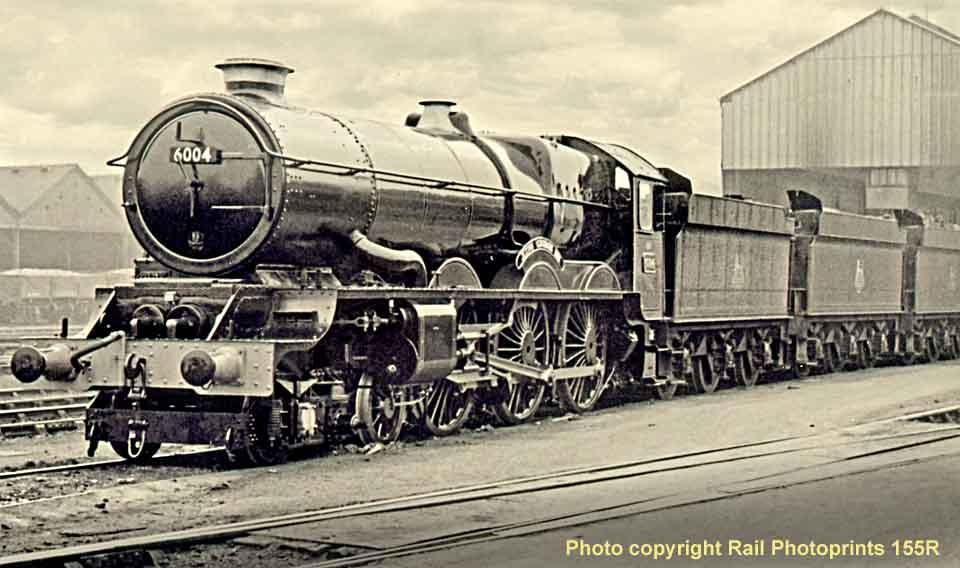
(Above) In November 1956, ex-GWR 'King' class 4-6-0 No 6004 'King George III' was photographed at Swindon Works following its Heavy Intermediate repairs which included the fitment of the first of the latest type of chimney; a cast iron elliptically shaped double blast piped version, slightly tapered at the top. This proved to be the definitive design and was applied to all of the 'Kings' by the end of March 1958, when No 6018 'King Henry VI' emerged from the Works on the 21st of that month. The outside steam pipes are not actually visible, but are hidden by the thin sheet-steel casing, which also serve to protect the crews from their excessive heat. Many times the original shape of pipe did cause cracking just above the cylinder joint, not allowing enough flexibility as the slight distortion of the engine frames meant that the outside cylinder moved slightly in relation to the boiler assembly. With the mechanical lubrication unit now moved to the forward position, the engine is in its ultimate condition and visually will change very little in the remaining 6 years of service, only the latest BR emblem applied to the tender will alter the overall appearance of the locomotive. The tenders shown are not necessarily from the 'King' class, but all appear to be Collett designed units, most likely awaiting refurbishments and may well be attached to 'Hall', 'Castle' or 'Grange'.
BR MODIFICATIONS:
1. New front frames, indicated by the large support washer on the frame end, now seen.
2. Extended covers for inside valves [May 1955].
3. Modified steam pipes [1953].
4. WB boiler [09/53].
5. Double chimney [first to be fitted cast-iron variety in 11/56]
6. Mechanical lubrication unit [now in final position].
7. Leading bogie has welded repairs done [02/56].
8. Cab roof vents inserted [1954].
9. BR old emblem still [new 24/04/58].
10. Raised step over the inside cylinders, below smokebox.
(Above) Ex-GWR 'King' class 4-6-0 No 6004 'King George III' backs out of Paddington Station in 1956 having brought in an express from Plymouth. Many changes from new are self-evident; extended covers to the inside valves, with support washers to the frames (indicating that the front half of the frames had been replaced), mechanical lubrication unit is now forward of the modified steam pipes, a WB boiler with 24-element four-row superheater, but with single chimney and old BR emblem still. The new boiler with its larger superheater was a development by the then relatively new Chief Mechanical Engineer, FW Hawksworth in response to the running department's request to increase the amount of coaches per train to facilitate the increase in passengers after the austerity of the war years. An increase of 56% in the superheated surface was gained when compared to the WA boilers tested on '6022' from March 1948; once all the new boilers were available they were then applied to the whole class by 1956. Within a month of being built, the leading bogie was found to be inadequate because of the soft springing (this had caused the derailment of '6003' at Midgham) thus a slotted front cross member bogie was formulated at Swindon and fitted to '6004', but it is very difficult to surmise the full extent of the thinking behind this move. If we postulate that the slot was intended to create a downward force, with the engine in motion and therefore increase the adhesion weight onto the rails, then why not add an angled fin to the top edge to push down the front end. It occurs to me more likely that the move was designed to lose some weight, having added extra ballast with the heavy-duty coil springs. The engine spent 25 good years at Plymouth Laira (LA and 83D) before completed its service at Cardiff Canton (88A) depot, being one of eight 'Kings' allocated there from September 1960.
BR MODIFICATIONS:
1. New front frames, indicated by the large support washer on the frame end, now seen.
2. Extended covers for inside valves.
3. Modified steam pipes [1953].
4. WB boiler [09/53]
5. Double chimney added later [first cast iron variety to be fitted, 11/56).
6. Mechanical lubrication unit [now in final position].
7. Leading bogie has welded repairs done [01/56].
8. Cab roof vents inserted [1954].
9. BR old emblem still [new 24/04/58]
10. Raised step over the inside cylinders, below smokebox.
6005 King George II 
(Above) Ex-GWR 'King' class 4-6-0 No 6005 'King George II' checks into platform 10 at Paddington Station, with Tn '255' from Shrewsbury, the engine having taken over the express at Wolverhampton. The long-term resident at Wolverhampton Stafford Road (84A) is seen in the summer of 1953: WB boiler is now fitted, though the steam pipes are original, no cab roof vents are to be seen, but the mechanical lubrication unit is in the first position and a single chimney remains in place, although it is a sleeved version which was added in conjunction with improved draughting. It should be noted that the lubrication unit was always added with the new superheated boiler to take away the responsibility of 'oiling round' from the driver thus increasing the reliability of these fine engines. 1953 was the first year that the engine was seen in the new BR Brunswick Green livery and all class members were treated likewise by February 1954, with the first repaint from light blue being seen in March 1952. '6005' was one of nine class members to run with a 'slotted bogie' which was purely a one-off that made its appearance immediately after the derailment at Midgham and generally viewed as an attempt to help to cool the bogie's running gear. The slot was made in the front cross-member of the bogie assembly and appeared on '6005' in September 1958, remaining so for a couple of years. Another feature of this 'King' was its selection for performance trials to compare with French De Glehn Locomotives, in 1931.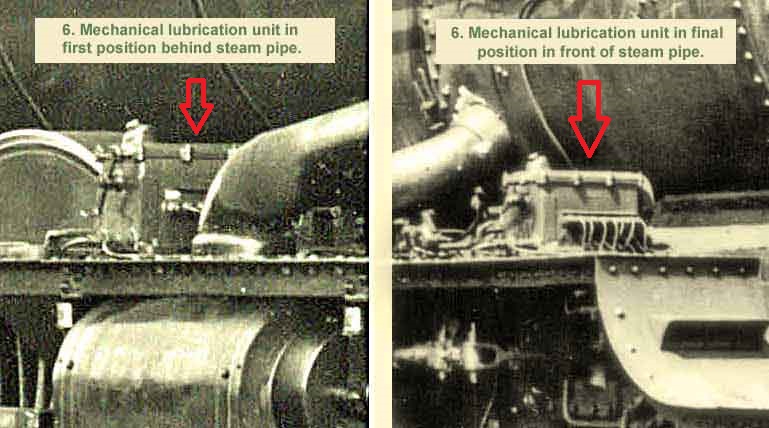
BR MODIFICATIONS:
1. New front frames, indicated by the large support washer on the frame end, not seen.
2. Extended covers for inside valves appeared later in 1954.
3. Original steam pipes [changed late 1953].
4. WB boiler [01/53].
5. Fabricated double chimney added later [07/56].
6. Mechanical lubrication unit added [now in first position].
7. Leading bogie welded repairs not yet required.
8. Cab roof vents inserted later [1954].
9. BR old emblem added to tender.
10. First stage of raised step over the inside cylinders, below smokebox. 
(Above) Ex-GWR 'King' class 4-6-0 No 6005 'King George II' speeds along towards Harbury Station, between Leamington Spa and Banbury, with an up express from Birkenhead to London in October 1956. The initial cost of one such engine was calculated at £6,383, with the boiler itself estimated at £1,699, however these figures do not make any allowance for the overall cost outlay, which would have included new tools; new cranks to be made from scratch, requiring 14 inch webs (centre to centre) instead of the 13 inch ('Castle') and 15 inch ('Hall' and 'Grange' etc) patterns already at hand; also new patterns for the change of drive wheel dimensions, being reduced to 6ft 6in. Additional costs were the tender, priced at just over £1,000 and the Automatic Train Control equipment which added a further £44 to the bill. 'King George II' was a long term resident of Stafford Road depot, one of 19 'Kings' to be allocated to the Wolverhampton shed (SRD and 84A) for an average of slightly less than 10 years each. No 6005 was one of the mainstay locomotives used on the London-Birmingham express passenger services, the others being Nos 6006, 6008, 6011 and 6020, but many more arrived in 1959 after the new diesels commandeered the London to Plymouth services. This excellent image from Gordon Coltas, gives a very good sighting of the fabricated sheet steel double chimney, the straight sides and upright ends show up very well.
BR MODIFICATIONS:
1. New front frames, indicated by the large support washer on the frame end, now seen.
2. Extended covers for inside valve covers have been fitted.
3. Modified steam pipes [1953].
4. WB boiler [01/53].
5. Fabricated double chimney newly fitted [cast-iron type fitted 04/58].
6. Mechanical lubrication unit [now in final position].
7. Leading bogie has welded repairs done [02/56].
8. Cab roof vents inserted [1954].
9. BR early emblem added [new version 21/04/58].
10. Raised step over the inside cylinders, below smokebox, now seen.
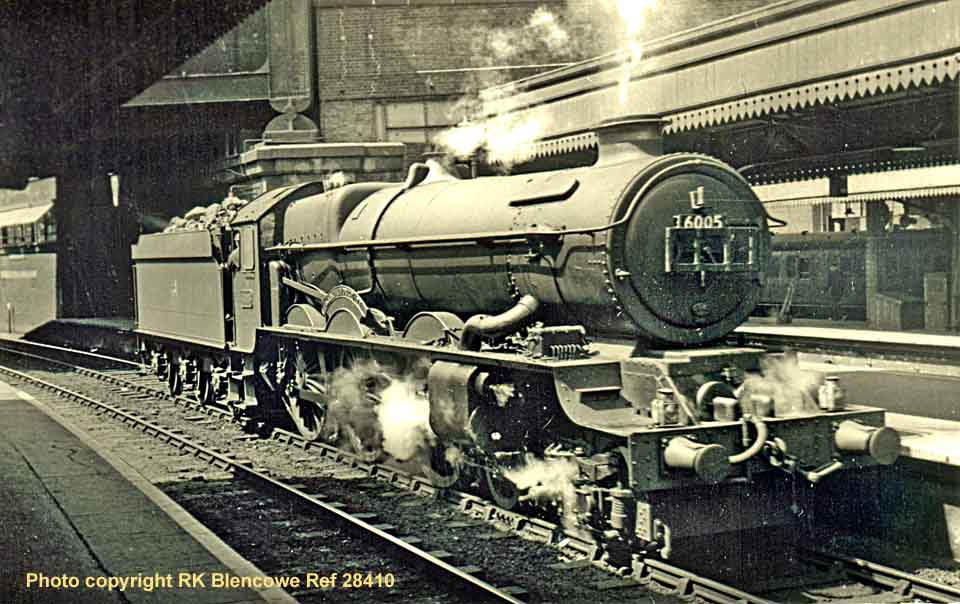
(Above) Ex-GWR 'King' class 4-6-0 No 6005 'King George II' is waiting at Paddington's platform 10 for a path to Ranelagh Bridge service yard during the late summer of 1957. A long-time resident at Wolverhampton Stafford Road depot (totalling 32 years) 6005 was among the most common of the Kings 'spotted' at Birmingham Snow Hill during my spotting days there. A modernised front end is clear to see with the exception of tapered buffers which lingered for some time on many class members. 6005 was severely tested on the main-line and at Swindon Test plant along with '6002 King William IV' to assess the difference of a quarter of an inch in the diameter of the cylinders. The author, OS Nock, stated that the Wolverhampton Stafford Road depot crews were able to work a better performance from their allocation of 'Kings', even though the shed was supplied with a lower quality Staffordshire coal compared to the higher standard 'soft Welsh' as used by other depots. He also complemented the crews on their 'pride of the job' attitude. The engine was used on Royal Train duties in May 1955, when the Queen was returning to London from a visit to Birmingham.
BR MODIFICATIONS
1. New front-half frames, indicated by the large support washer on the frame end, now seen [15/03/55].
2. Extended covers for inside valves fitted [15/03/55].
3. Modified steam pipes [1953].
4. WB boiler [01/53].
5. Fabricated double chimney [07/56].
6. Mechanical lubrication unit [now in final position].
7. Leading bogie has welded repairs done [18/02/56].
8. Cab roof vents inserted [1954].
9. BR old emblem still [new version seen 21/04/58].
10. Raised step over the inside cylinders, below smokebox is added.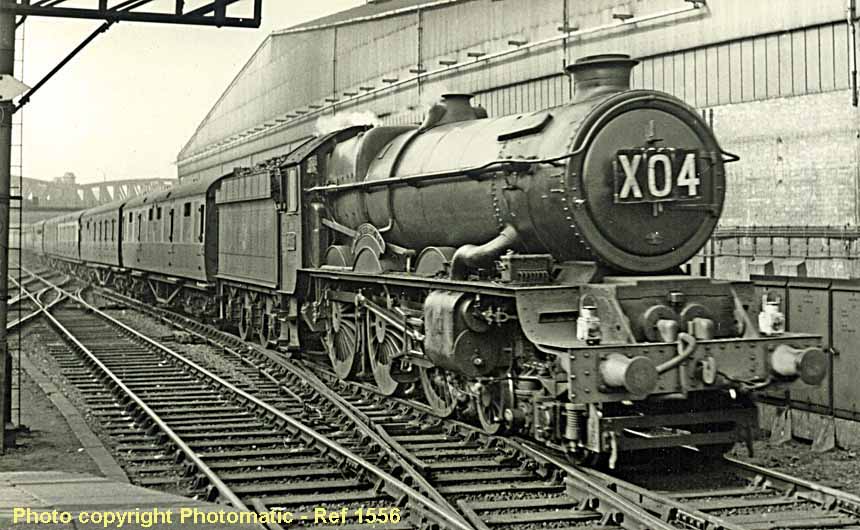
(Above) Ex-GWR 'King' class 4-6-0 No 6005 'King George II' draws into Paddington Station with a mixed bag of rolling stock from Wolverhampton during the early months of 1959. The slotted leading bogie is clearly seen in this view, a special one-off assembly that was constructed after the derailment of sister engine '6003' in 1927; this bogie was paired with eight other class members at various times, including 6000, 6004, 6014, 6018, 6021, 6023, 6024 and 6028 for relatively short periods. The recorded mileage for this engine fell some way below the other class members built in 1927, possibly because of some problems in 1929 which led to the locomotive entering Swindon Works on four occasions, plus two sessions of tests when comparisons were made with the French De Glehn locomotive in 1931. During 1954, the locomotive spent a total of 25 weeks out of service, either undergoing repairs at Old Oak Common or Swindon Workshops, which severely reduced its usage. Apart from the upgrade of the original taper buffers, all the usual BR modifications are seen to be done, including the frame-lifting eyelets; originally no such facility was fitted to these engines until around 1946 when these eyelets started to appear, thus aiding the process of lifting the locomotive for repairs, rather than hooking onto the buffer bar. As one of the first six 'Kings' constructed, '6005' was first seen with a Great Western garter emblem on the tender, but this was objected to by Royal Commission of Heralds and had to be swiftly removed, being replaced by the rather small GWR roundel, with some engines appearing with only that showing.
BR MODIFICATIONS
1. New front frames, indicated by the large support washer on the frame end, now fitted.
2. Extended covers for inside valves now added [03/55].
3. Modified steam pipes [1953].
4. WB boiler [01/53].
5. Cast-iron double chimney now added [04/58].
6. Mechanical lubrication unit [now in final position].
7. (Slotted) leading bogie has welded repairs done [02/56].
8. Cab roof vents inserted [1954].
9. BR new emblem added, facing wrong way [21/04/58].
10. Raised step over the inside cylinders, below smokebox, now fitted.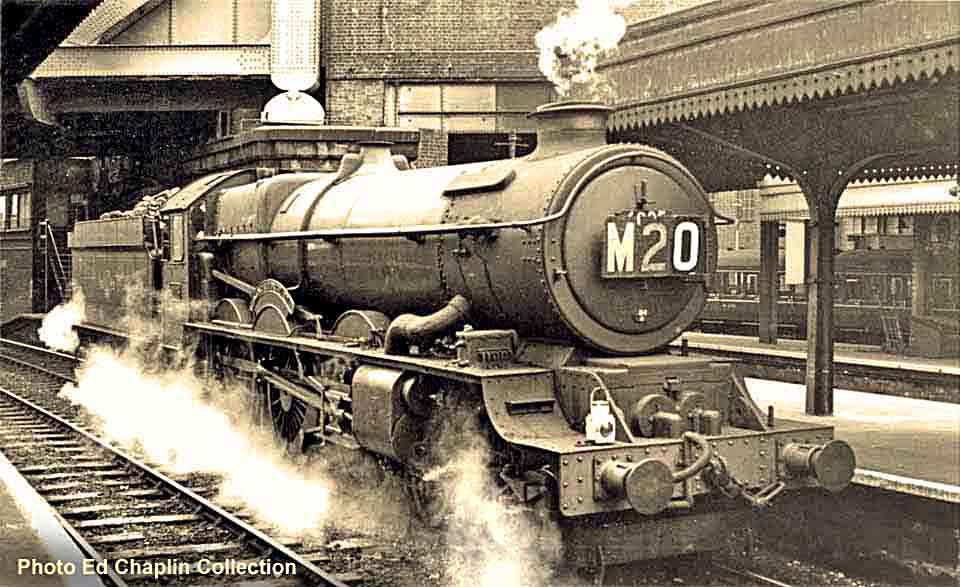
(Above) Wolverhampton Stafford Road's Ex-GWR 'King' class 4-6-0 No 6005 'King George II' reverses away from Paddington's platform 10 for service at Ranelagh Bridge depot or even to Old Oak Common Shops to repair a fractured steam pipe on the tender. Dated July 1962, the 'old fella' has little time left before its ultimate demise. All ten modifications are prominent in this picture, including the cast-iron double chimney which was elliptically shaped and became a feature of all the class members from the middle of 1958, with one notable exception. Also seen are the later heavier model buffers, which were retained by eight bolts instead of the previous four as used on the earlier tapered variety. This engine was paired with the slotted-frame leading bogie for a little over two years from 1958 into 1961, but this particular oddity has now been moved onto its classmate No 6021 'King Richard II' until its demise in September 1962. 'King George II' fared slightly better and lasted late into November 1962 after an almost full service history spent at Stafford Road in Wolverhampton. The train reporting number 'M20' indicated a Paddington-Birkenhead express with the 'King' possibly coming off at Wolverhampton (Low Level) or maybe carrying on through to Shrewsbury, as the bridge axle-loading restrictions at Shifnal had been lifted. The engine lasted out until November 1962 and was condemned and cut up by J Cashmore of Great Bridge, West Midlands, being one of six 'Kings' to end its days there.
BR MODIFICATIONS.
1. New front frames, indicated by the large support washer on the frame end, now seen.
2. Extended covers for inside valves, added [03/55].
3. Modified steam pipes [1953].
4. WB boiler [01/53].
5. Cast-iron double chimney [from 04/58].
6. Mechanical lubrication unit [seen in final position].
7. Leading bogie has had welded repairs done [02/56].
8. Cab roof vents inserted [1954].
9. BR new emblem added [now facing correct way].
10. Raised step over the inside cylinders, below smokebox [1954].
6006 King George I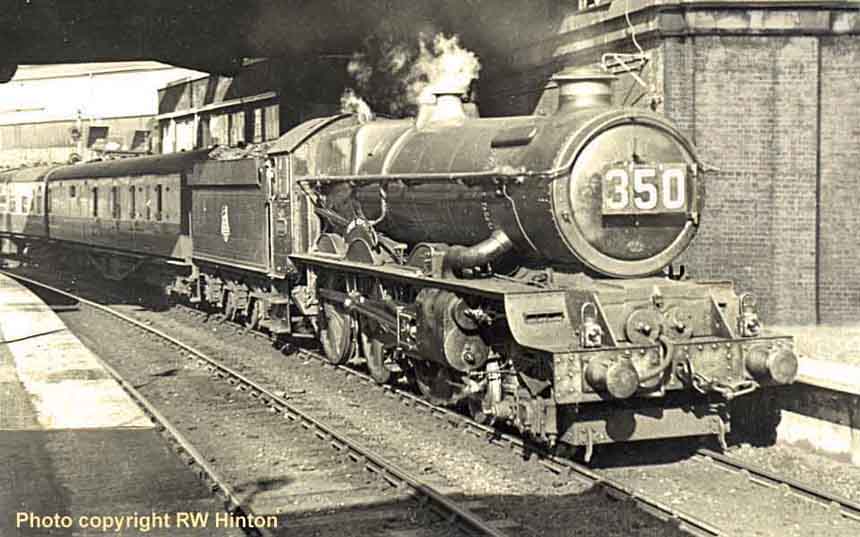
(Above) Ex-GWR 'King' class 4-6-0 No 6006 'King George I' moves gracefully along platform 10 at Paddington Station with the 07.45 ex-Wolverhampton, timed to arrive in the capital at 10.00am. This Ray Hinton image, dated 24 September 1955, reflects a well-cleaned engine which had not been to Swindon for some few months. No 6006 had a WB boiler and mechanical lubrication unit fitted in its early position back in April 1953; the two modifications were carried out in unison to help protect the inside cylinders and valves by supplying oil in increments while in service thus removing the responsibility from the driver; moreover with the increase in superheating it was important to ensure proper and adequate lubrication of the regulator. It would seem from this image that the engine still has a sleeved single chimney; this was replaced by a fabricated straight-sided double version from June 1956 and in late November 1957 a cast-iron elliptically shaped double chimney appeared, which belatedly produced a more powerful locomotive capable of handling any task asked of it. It was a shame that the palindrome-style numberplate was mostly covered by a reporting number, but the WR required these to be mounted on the smokebox door to assist signalmen in identifying trains. '6006' was a stalwart of Stafford Road depot for more than 30 years, during which time the 'King' class was not permitted north of Wolverhampton until the weight restriction of the bridge at Shifnal had been lifted. 
BR MODIFICATIONS
1. New front frames, indicated by the large support washer on the frame end, not ever seen.
2. Extended covers for inside valve covers were never added.
3. Modified steam pipes [1953].
4. WB boiler [04/53].
5. Fabricated double chimney fitted later [seen 06/56].
6. Mechanical lubrication unit [seen in first position].
7. Leading bogie had welded repairs done later [02/56].
8. Cab roof vents inserted [1954].
9. BR early emblem added [new type 24/02/1958].
10. Raised step over the inside cylinders, below smokebox.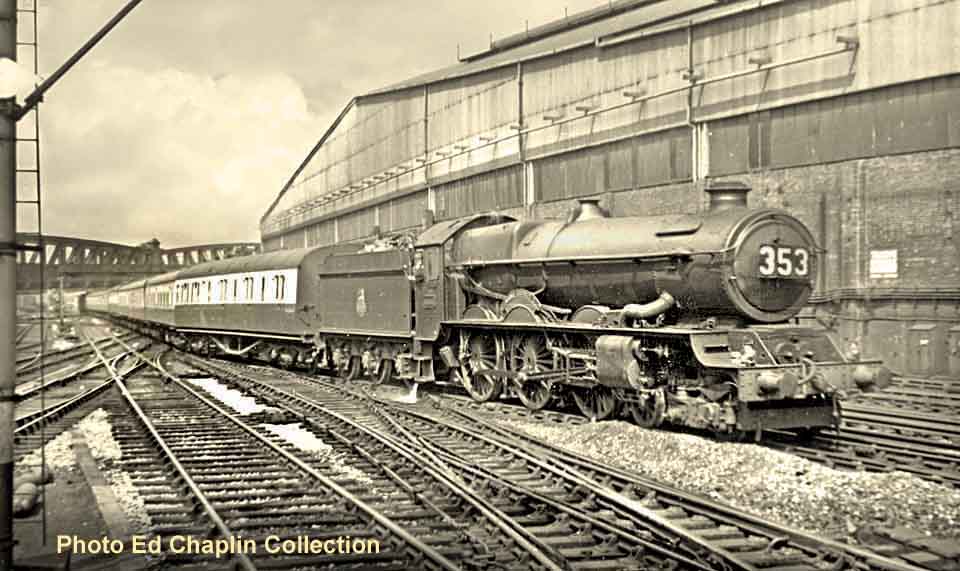
(Above) Ex-GWR 'King' class 4-6-0 No 6006 'King George I'
glides gently over pointwork into Paddington station with a train off the 'Birmingham Line' in 1955.
When first conceived by CB Collett the resulting engine was calculated at 39,100lbs of tractive effort but Sir Felix Pole (GWR General Manager 1921-1929) was adamant that the 40,000 barrier should be reached; the prestige and desire to claim that you have the most powerful engine in the country was just overwhelming. Thus Collett acquiesced and reduced the size of the driving wheels by 2 inches from 6ft 8½in to raise the bar to 40,285 and the so called 'Super Castle' was born; the name 'King' had not been brought forward at that point, it was only when their collective thoughts turned to naming the new locomotives did it develop from 'Cathedrals' to 'Kings' prompted by Sir Felix's strong desire to send a new locomotive to the Baltimore & Ohio Railroad's centenary celebrations in America. Naming of the class required Royal consent, which was duly granted and as Sir Felix wished to name the first available engine (6000) after the current Monarch, the subsequent engines bore the names of English Kings in reverse chronological order, thus copying names from ten 'Star' class locomotives, which were renamed. No 6006 had short spells allocated at Laira (LA) and Old Oak Common (PDN), but was a mainstay at Stafford Road (SRD and 84A) for more than 31 years before its demise in February 1962, thus becoming the very first withdrawn from service. This view displays a reasonably clean 'King George I' at the head of an express from Shrewsbury with the 'King' taking over at Wolverhampton Low Level station.
BR MODIFICATIONS
1. New front frames, indicated by the large support washer on the frame end, not ever seen.
2. Extended covers for inside valves were not changed.
3. Modified steam pipes [1953].
4. WB boiler [04/53).
5.
Single chimney still [fabricated double type fitted 06/56].
6. Mechanical lubrication unit [in first position].
7. Leading bogie had welded repairs done later [02/56]
8. Cab roof vents inserted [1954].
9. BR early emblem showing [later logo 24/02/1958].
10. Raised step over the inside cylinders, below smokebox.
6007 King William III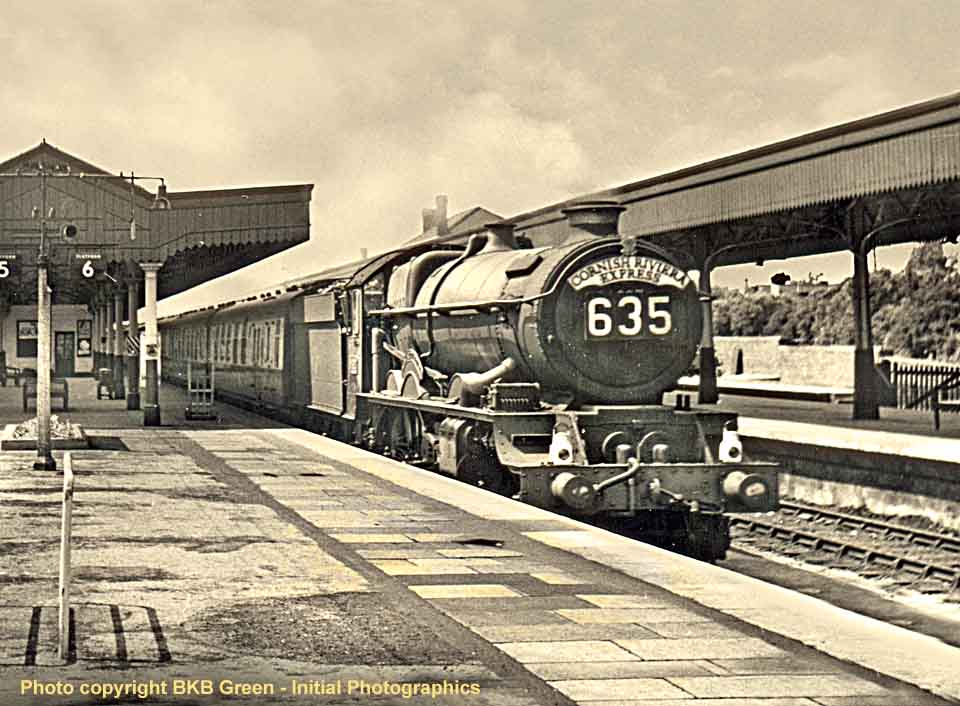
(Above) Ex-GWR 'King' class 4-6-0 No 6007 'King William III' moves swiftly through Taunton station with the Up 'Cornish Riviera Express' in June 1958 as captured by BKB Green for Initial Photographics. All relevant modifications are now in place and only the old style taper buffers have yet to be renewed to complete the picture, though the date suggests that the new version BR emblem will be facing to the front and not corrected until later in 1959. From the very first 'King' available, the haulage of the 'Limited' - the GWR's premier train for holidaymakers heading west from London to Penzance - was the main objective; the 'Kings' quickly took over from the 'Castle' class engines thereby enabling heavier loads to be scheduled. However, the extra weight of the 'Kings' prevented the class crossing of the Royal Albert Bridge at Devonport, so the engines started and finished their journey at Plymouth Road North station, allowing lighter engines to complete the journey to Cornwall.
BR MODIFICATIONS
1. New front frames, indicated by the large support washer on the frame end, seen from 09/56.
2. Extended covers for inside valves [09/56].
3. Modified steam pipes [1953].
4. WB boiler [06/55].
5. Fabricated double chimney [fitted 09/56].
6. Mechanical lubrication unit [now in final position].
7. Leading bogie has welded repairs done [01/56].
8. Cab roof vents inserted [1954].
9. BR new emblem added.
10. Raised step over the inside cylinders, below smokebox.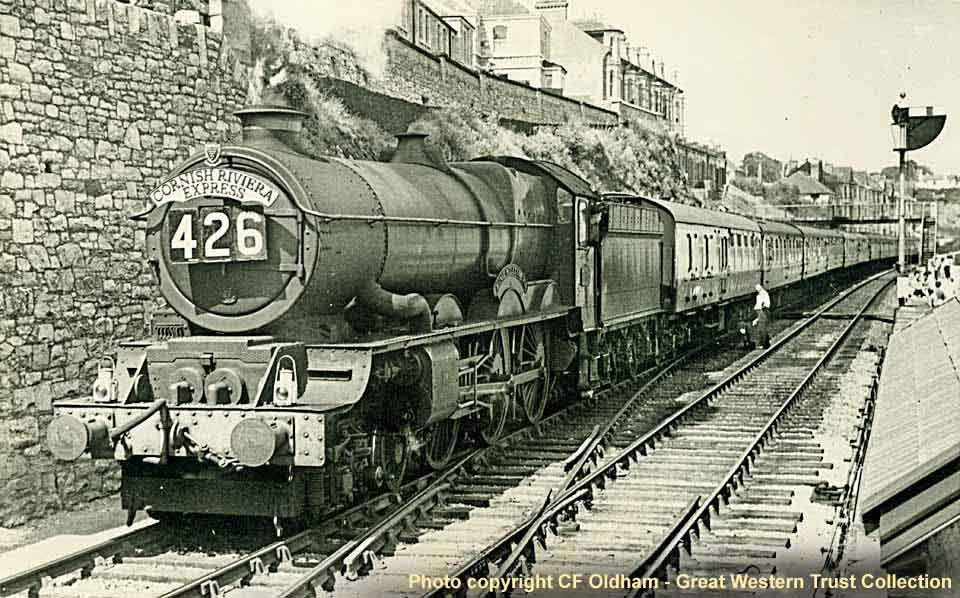
(Above) No 6007 was the class member to be substantially 'rebuilt following a fatal accident at Shrivenham in 1936; the incident was caused by the detachment of wagons from a goods train resulting in an express hauled by 6007 being derailed with awful consequences. Some quotes state that a completely new engine was constructed to replace No 6007 'King William III', thus 31 Kings were built, but in fact the locomotive was rebuilt using many original parts, and likewise the tender was repaired to good effect. The Engineer's report listed several parts requiring attention or renewing, including a bent front frame, but the cylinders and wheel-sets were all in good order; indeed once the boiler had been changed and the peripheral damage to inessential items reset or renewed, the overall repairs carried out affected mainly superficial parts and the questionable new build was mainly for accounting purposes. During the mid-1950s the overhaul of 6007 included new inside cylinders and valve assemblies in conjunction with the front half section of the frames and boiler replacement; the cost of this work amounted to more than the relative cost recorded when restoring '6007' in 1936. Our image stems from the Great Western Trust collection and shows 'King William III' at Dawlish with a down train (from Paddington) working wrong line due to engineering work in the summer of 1959. As we can see from the likes of this picture the identification of the engine is sometimes near impossible and we have to trust the photographer (as well as thank him for the result) to record the details for our benefit and it is understandable that such data may become lost or misread.
BR MODIFICATIONS
1. New front frames, indicated by the large support washer on the frame end, seen from 09/56.
2. Extended covers for inside valves [09/56].
3. Modified steam pipes [1953].
4. WB boiler [06/55].
5. Fabricated double chimney [fitted 09/56].
6. Mechanical lubrication unit [now in final position].
7. Leading bogie has welded repairs done [01/56].
8. Cab roof vents inserted [1954].
9. BR new emblem added.
10. Raised step over the inside cylinders, below smokebox.
6008 King James II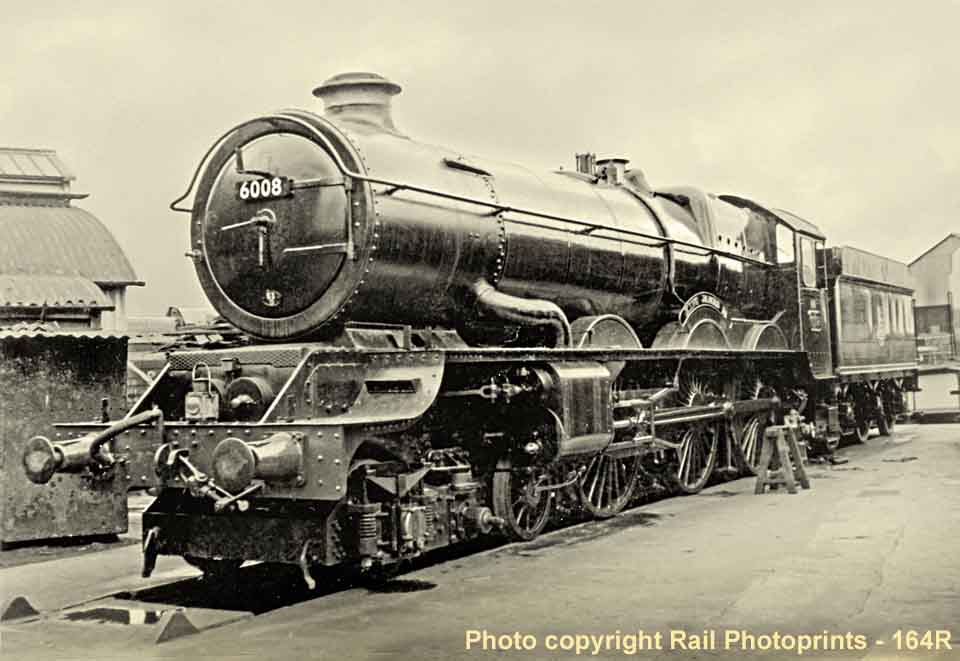
(Above) Fresh out of the workshops at Swindon, ex-GWR 'King' class 4-6-0 No 6008 King James II stands by the turntable awaiting last itemised checks to be carried out before final testing in June 1954. A reconditioned boiler was fitted during this visit, but not one of the new WB types as there were insufficient numbers constructed at this time; according to records the engine never did receive a new WB boiler, only reconditioned units as previously used by other class members. However as part of the new draughting techniques a different single chimney is now fitted; this had a sleeve added to narrow the aperture coupled with a narrower blastpipe. The level of finish achieved by the 'Factory' was legendary with attention to detail at a maximum thus any recourse to correct faults after an engine's release to its home depot rarely occurred. The front numberplate was made up of individual numerals, while the cabside brass numberplates would be worth a King's ransom in latter days. In all, fifteen 'King' class locomotives received the early fabricated double chimneys, while No 6008 had the cast-iron variety added as from July 1957 which would have given the 29 year-old engine a new lease of life at Plymouth Laira locomotive depot (83D). Withdrawn in June 1962, No 6008 was one of ten class members dismantled at Swindon Works, thus the locomotive was constructed, repaired and cut up at the same venue.
BR MODIFICATIONS
1. New front frames, indicated by the large support washer on the frame end not yet seen.
2. Original covers for inside valves still.
3. Modified steam pipes [January 1953].
4. WB boiler would be fitted later [12/55].
5. Double chimney would be added in July 1957.
6. Mechanical lubrication unit not yet fitted.
7. Leading bogie had welded repairs done later [01/56].
8. Cab roof vents now inserted [1954].
9. BR old emblem still.
10. Diamond treadplate step over the inside cylinders, below smokebox (first stage). 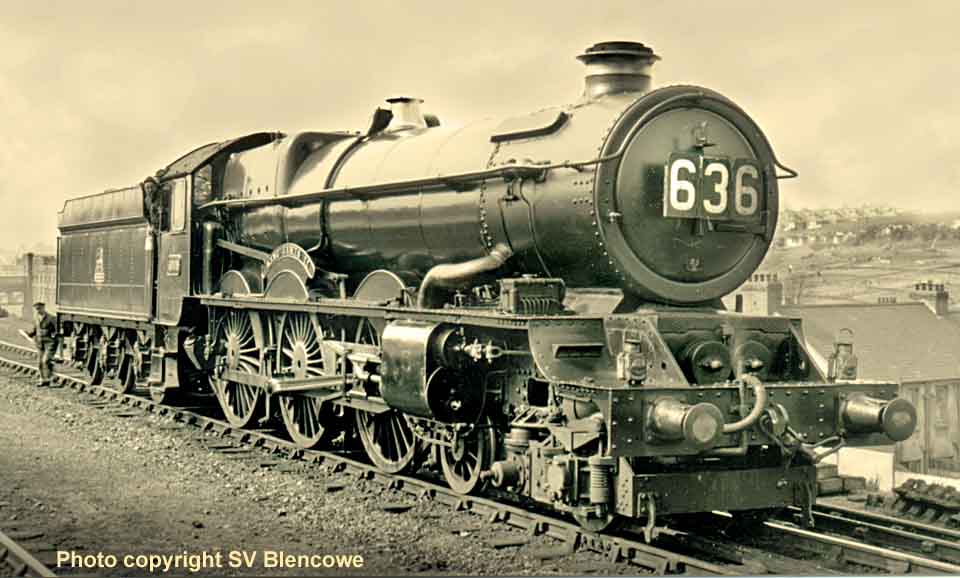
(Above) This magnificent study of Ex-GWR 'King' class 4-6-0 No 6008 'King James II' at Plymouth Laira (83D) depot in April 1956, allows us to scrutinise some of the changes that have evolved over its near 30 years of service, though mostly in the BR ownership era. The WB boiler has recently been fitted, giving additional superheating and a much better performance from the slightly inferior coal then predominant, apparently the better coal was being kept for the Merchant Navy shipping fleet. The additional mechanical lubrication unit was deemed necessary to ensure that a constant and adequate oil supply was available to the valves, cylinders and regulator. A sleeved single chimney appears to be fitted, although it is not entirely clear from this angle as a capuchon type could look much the same; the single chimney was replaced by a cast-iron elliptically shaped double chimney from July 1957. This particular locomotive entered Swindon Works on 31 October 1955 and was given a clean bill of health in respect of the front frames, although they were subsequently changed after 3 months of repairs at Swindon and seen from July 1957 along with the extended valve covers and double chimney. Looking at the leading bogie, one should be able to identify the added welded pieces (fillets) on the upper and lower extremes of the frame, a required modification due to the rather high numbers of fractures being found by shed staff during routine inspections. Train reporting number '636' indicated a 'Cornish Riviera' relief express that normally ran 10 minutes prior to the actual publicised express service.
BR MODIFICATIONS
1. New front frames, indicated by the large support washer have not been added yet.
2. Extended covers for inside valves were still as original.
3. Modified outside steam pipes [1953].
4. WB boiler fitted [12/55].
5. Cast-iron double chimney added later [07/57]
6. Mechanical lubrication unit [now in final position].
7. Leading bogie has had welded repairs done [12/55].
8. Cab roof vents inserted [1954].
9. BR new emblem not yet added [seen after 07/57].
10. Raised step over the inside cylinders, below smokebox not been fitted.
6009 King Charles II 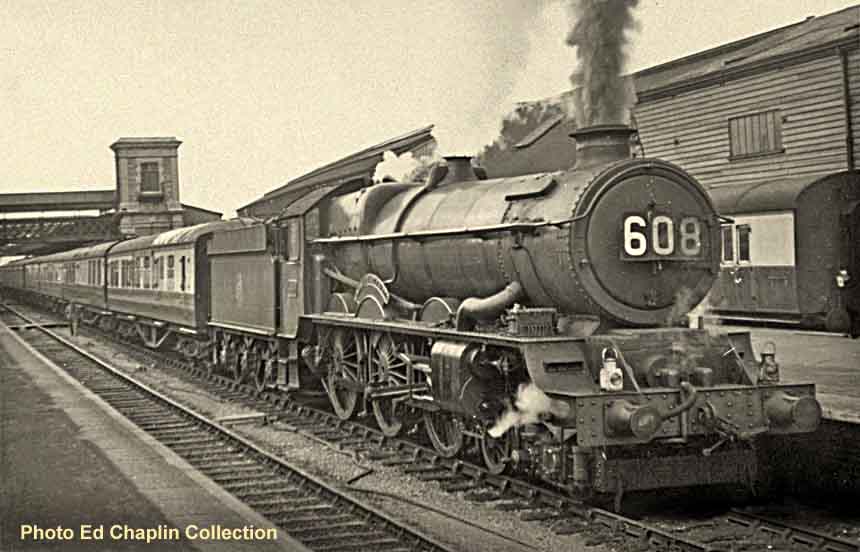
(Above) Ex-GWR 'King' class 4-6-0 No 6009 'King Charles II' is ready for the off at Exeter St David's with an express for London. Quite remarkably, the engine spent all of its 34 years in service working from Old Oak Common (PDN and 81A) thus passing this way on many occasions, but not often seen on the 'Birmingham Line' or the 'Northern Line' as it used to be called. It was a fact that the Birkenhead and Wolverhampton services were considered the poor relations to the 'Limited' or the 'Mayflower'. Following the Western Region's dieselisation of the 'Way West' in 1959 along with the London Midland Region's electrification of the West Coast Main Line, many more 'Kings' were utilised on the Paddington to Wolverhampton expresses, including '6009' which made some belated appearances on these services, even as far north as Shrewsbury. From their original build weights, the 'Kings' put on many extra tons; No 6009 was fitted with a larger superheater, a lubrication unit; larger-heavier drive wheel centres and additional springs added to the leading bogie, not to mention the final type of cast-iron double chimney, all of which contributed towards a much heavier engine by around 7 tons. Also the engine was the first to show off the new 'Lion and Wheel' motif which was applied in November 1949, but supplies soon ran out and a few engines were noted without any adornment on the tender.
BR MODIFICATIONS
1. New front frames, indicated by the large support washer on the frame end, now seen.
2. Extended covers for inside valves, now added [05/56].
3. Modified steam pipes [1953].
4. WB boiler [07/54].
5. Fabricated double chimney [fitted 05/56]. Later type added 27/09/57.
6. Mechanical lubrication unit [now in final position].
7. Leading bogie has welded repairs done [02/56].
8. Cab roof vents inserted [1954].
9. BR early emblem added [new version 09/57].
10. Raised step over the inside cylinders, below smokebox. 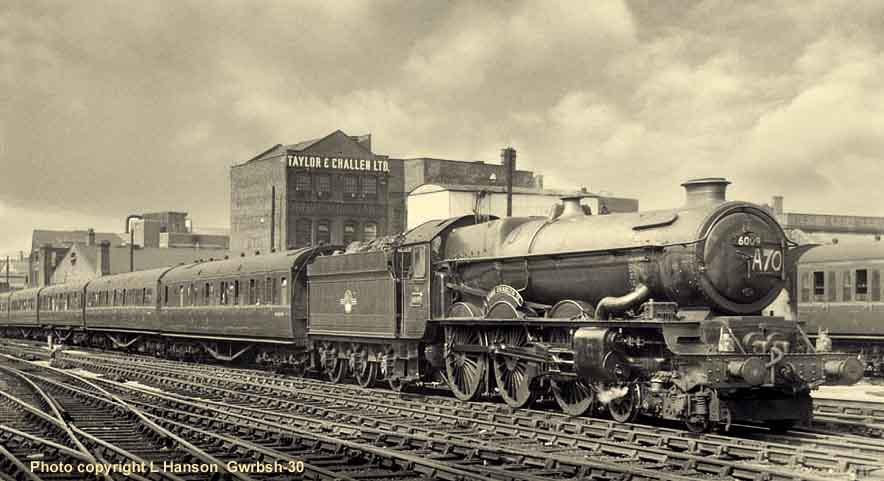
(Above) Ex-GWR 'King' class 4-6-0 No 6009 'King Charles II' easily defeats the stiff 1 in 47 incline away from the tunnels under Great Hampton Station and draws smoothly into Birmingham Snow Hill with a Birkenhead to Paddington express in August 1961. All of the BR modifications are now plain to see, as well as the new style straight-barrelled buffers, easily recognisable by the 8 stud bolts used to secure them. The cast-iron elliptically shaped new version double chimney was fitted in September 1957, replacing the earlier straight sided model that was fabricated from sheet steel and saw service on 50% of the class. 'King Charles II' was one of only four engines to be painted in experimental Ultramarine Blue livery which British Railways introduced soon after taking over in 1948; the other three 'Kings' involved were '6001', '6025' and '6026', but the exercise was extremely limited as the colour did not wear well and a more favoured hue of Caledonian Blue was adopted for all 'Kings' which lasted three years before giving way to the preferred Brunswick Green from early in 1952. However '6009' had to wait until March 1953 for its new livery, and 16 months later the engine received one of the improved WB boilers developed by FW Hawksworth. The Old Oak Common engine was withdrawn in September 1962, having recorded 1,932,102 miles in service; the loco became one of four members of the class to be dismantled at J Cashmore of Newport.
BR MODIFICATIONS
1. New front frames, indicated by the large support washer on the frame end, now seen.
2. Extended covers for inside valves, now added [05/56].
3. Modified steam pipes [1953].
4. WB boiler [07/54].
5. Cast-iron double chimney [fitted 27/09/57].
6. Mechanical lubrication unit [now in final position].
7. Leading bogie has welded repairs done [02/56].
8. Cab roof vents inserted [1954].
9. BR later emblem added [09/57].
10. Raised step over the inside cylinders, below smokebox.
6010 King Charles I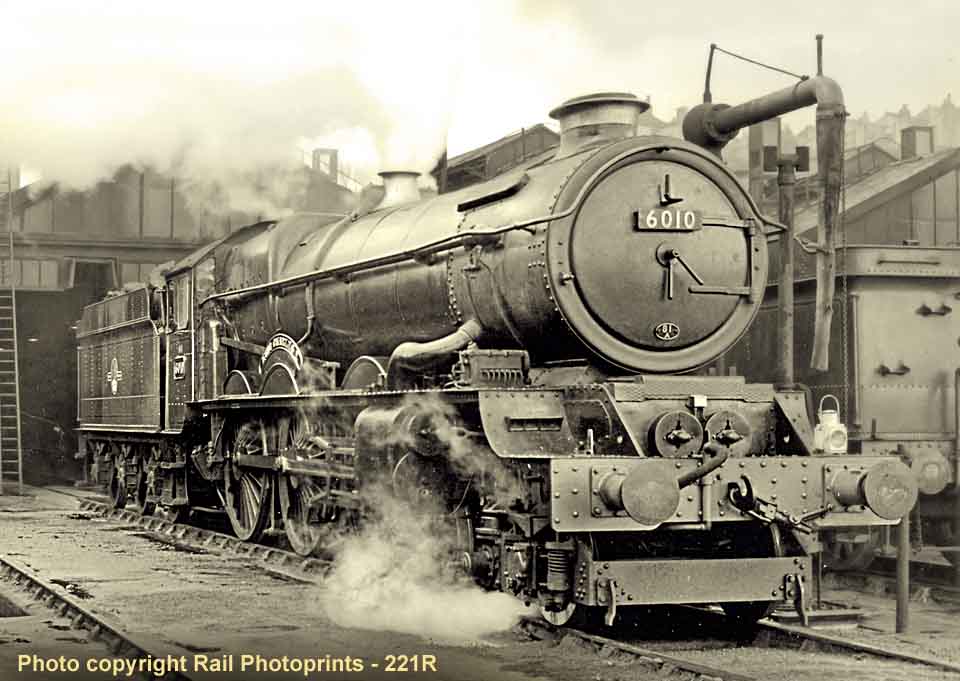
(Above) After thirty years of slogging up and down the 'Great Way West' hauling heavy expresses between London and Plymouth, ex-GWR 'King' class 4-6-0 No 6010 'King Charles I' was photographed at Bristol Bath Road depot soon after its transfer from Plymouth Laira (83D) to Old Oak Common (81A) in April 1959. Most of the BR modifications are now apparent, including a new WB boiler, which was fitted while the locomotive's livery was still 'light blue'; this was the case with four other engines Nos 6013, 6022, 6025 and 6028. The front frames were not renewed on this engine (fourteen were) but almost certainly some form of weld repair would have been actioned around the early 1950s, as by then the strenuous workload was beginning to take its toll on the fleet. During WWII many sites were bombed and hit with gunfire in an attempt to disrupt the country's transport system; in August 1940 a raid on Newton Abbot Station was responsible for fourteen deaths and fifteen people injured. In the yard at that time was '6010' which was extremely fortunate not to have been destroyed by a bomb, as the device failed to detonate. However the engine was then struck by a number of bullets which injured the crew and damaged the tender, yet the locomotive was lucky to escape relatively unscathed again. The 'King' completed its service hauling many expresses from Cardiff General Station, being one of eight 'Kings' allocated to Canton (88A) depot from September 1961 until its demise during June 1962.
BR MODIFICATIONS
1. New front frames, indicated by the large support washer on the frame end, not ever seen.
2. Extended covers for inside valves never seen [remained short].
3. Modified outside steam pipes [1953].
4. WB boiler [10/51].
5. Cast-iron double chimney [fitted 09/57].
6. Mechanical lubrication unit [now in final position].
7. Leading bogie has welded repairs done [03/56].
8. Cab roof vents inserted [1954].
9. BR new emblem added [facing wrong way] from 09/57.
10. Raised step over the inside cylinders, below smokebox..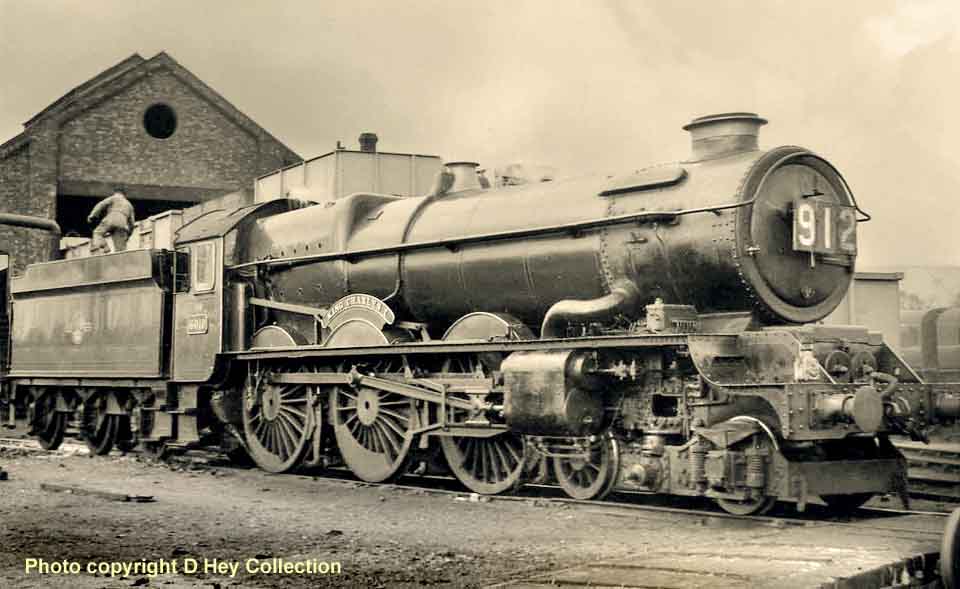
(Above) Having turned in readiness for its return to London, ex-GWR 'King' class 4-6-0 No 6010 'King Charles I' is waiting to be refuelled at Stafford Road coaling facility. The fireman does a rough version of the hokey-cokey as he tries to negotiate his way across the tender to top-up the water level, hoping there will be sufficient capacity to enable the engine to reach Paddington without cause to use the water troughs at West Ruislip. This photo affords an excellent view of the leading bogie, which, to the casual onlooker, must appear a strange concept, but much thought and anguish went into the design and construction of this most important part of the engine. Author OS Nock states that CB Collett gave the task of producing the bogie to a young designer called AWJ Dymond, who drew up plans for an alternative layout to a conventional bogie in order to accommodate the inside cylinders. But the resulting set-up was soon found to be inadequate; the overslung multi-leaf springs were too soft, allowing a ride soon described as 'very lively' in practice. Modifications were put in place and additional coil springs were affixed to the extremes of the leaf springs which stiffened the assembly and stabilised the front of the locomotive. '6010' completed more than 30 years of excellent service at Plymouth Laira depot, but was one of the 'Kings' to work from Cardiff Canton (88A), mainly to operate the 'Red Dragon' restaurant-car express for most of its last year of service.
BR MODIFICATIONS
1. New front frames, indicated by the large support washer on the frame end, not ever seen.
2. Extended covers for inside valves never seen.
3. Modified outside steam pipes [1953].
4. WB boiler [10/51].
5. Elliptically-shaped cast-iron double chimney from 09/57.
6. Mechanical lubrication unit [now in final position].
7. Leading bogie has welded repairs done [03/56].
8. Cab roof vents inserted [1954].
9. BR new emblem added [facing wrong way] from 09/57.
10. Raised step over the inside cylinders, below smokebox.
6011 King James I
(Above) Ex-GWR 'King' class 4-6-0 No 6011 'King James I' heads a Wolverhampton to London express through Hatton Station in Warwickshire. The early type of double chimney can clearly be seen from this angle; it was fitted from March 1956 and the early style of emblem was applied to the tender, though it is barely visible under many layers of grime in this picture. However we have a good view of the vacant framework for holding the train headcode plates, which very often (and annoyingly for spotters) obscured the number plate on many Western Region trains making identification of the engine impossible. BR catalogued these engines as '8P' which made sense when compared to the considerably lower 33,150lbs tractive effort of a Class '7P' LMS 'Royal Scot'. The GWR designated the class as 'double red' hence they could only employed on routes from London to Plymouth, Wolverhampton and Bristol, until BR allowed the 'Kings' to use the North to West route between Bristol and Shrewsbury and later still, the route into Cardiff, mainly for hauling the 'Red Dragon'. The 'SC' (self-cleaning) plate can be seen situated below the shedcode and of note is the security of the front coupling link onto one of the buffer fixing points. In 1954, '6011' was one of the engines to be tried with the 'Alfloc' water treatment, developed by ICI to combat the notorious Wolverhampton hard water supply which caused limescale deposits to form in the boiler tubes that required regular washouts, whereas the water treatment allowed the engine to run for 30 days before the boiler needed attention.
BR MODIFICATIONS
1. New front frames, indicated by the large support washer on the frame end, not ever seen.
2. Original covers for inside valves remained.
3. Modified outside steam pipes [1953].
4. WB boiler [12/52].
5. Fabricated double chimney [fitted 03/56].
6. Mechanical lubrication unit [now in final position].
7. Leading bogie has welded repairs done [03/56].
8. Cab roof vents inserted [1954].
9. BR first emblem still extant, new emblem added later [06/57].
10. Raised step over the inside cylinders, below smokebox.
(Above) Ex-GWR 'King' class 4-6-0 No 6011 'King James I' waits at 81A Old Oak Common - known locally as 'the Cathedral' due to its vast, cavernous roof and the 'Kings' and 'Queens' to be found therein. This excellent shot of '6011' in 1956 affords a clear view of the leading bogie, with its external bearings on the first axle creating clearance for the inner cylinder block, which aligns with the front buffer beam. Also clearly perceived is the added welded section visible just behind the front wheel, giving strength to an over-stressed area of the side-member, mostly applied in the early months of 1956, a period dubbed the 'King Crisis' as no fewer than twenty seven members of the class were removed from service due to extreme safety concerns. The engine had very recently received a Heavy General overhaul at Swindon Works, during which the fabricated sheet-steel, straight-sided double chimney was fitted, adding more performance and power by relieving some of the back pressure in the smokebox; this improvement was discovered in tests on '6015' the previous September. A cast-iron version was subsequently fitted in June the following year, creating a more profound look for the 'Kings' and eventually added to all members, with '6018' being noted as the last in that particular line. The scribed legend on the top of the smokebox door by some 'wag' predicts an easy 5-0 win for Manchester City in their FA Cup Final tussle with Birmingham City; a match memorable for the heroic display of the Manchester goalkeeper, Bert Trautmann, who, despite breaking a bone in his neck, played the full ninety minutes and Manchester City won 3-1.
BR MODIFICATIONS
1. New front frames, indicated by the large support washer on the frame end, not ever seen.
2. Original covers for inside valves remained unchanged.
3. Modified outside steam pipes [1953].
4. WB boiler [12/52].
5. Fabricated double chimney [fitted 03/56].
6. Mechanical lubrication unit [now in final position].
7. Leading bogie has welded repairs done [03/56].
8. Cab roof vents inserted [1954].
9. BR first emblem still extant, new emblem added later [06/57].
10. Raised step over the inside cylinders, below smokebox.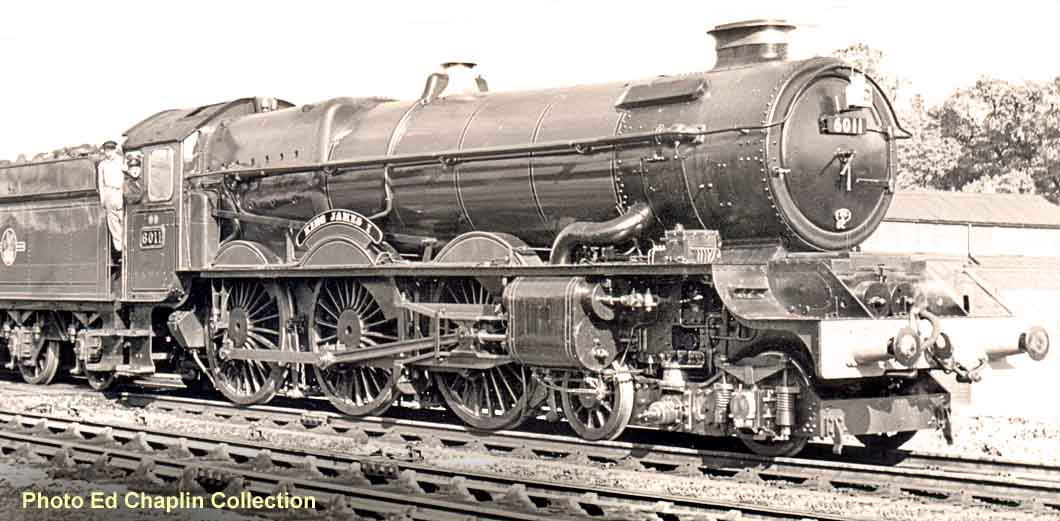
(Above) Ex-GWR 'King' class 4-6-0 No 6011 'King James I' waits at Chippenham Station after a studious overhaul at Swindon Works 'Factory'; this included a change of tender to a 4,000 gallon capacity Collett type and thus it received the new version of BR's Corporate emblem dated from June 1957. The tender was further changed in early August and also in the middle of September, suggesting that Wolverhampton Stafford Road shed were experiencing difficulties with their fleet and swapping units with others heading off to Swindon Works (quite normal practice). Official records show that No 6019 'King Henry V' had received a Heavy General in April 1957 and was coupled to a different tender - No 2815, but this was given up in August that year and in return gained tender No 2922 from '6011', an example of how unexpected problems were overcome in order to keep the trains running. The crew seem keen to record their part in the proceedings; only the most experienced pair from Swindon depot would be entrusted with checking all was in good order prior to 6011 being released back to its home depot at Stafford Road. A late entry to Swindon Works in October 1961 for a Heavy Intermediate repair, the engine returned to Wolverhampton with a fresh tender on 23rd February 1962, but it had only 10 more months to go before withdrawal; it was transferred to Old Oak Common 81A before the end and, being in good order, from the 10th of September it was used on regular local trips from Paddington to Didcot in tandem with '6005' also of 81A.
BR MODIFICATIONS
1. New front frames, indicated by the large support washer on the frame end, not ever seen.
2. Extended covers for inside valves, not ever seen [remained short].
3. Modified outside steam pipes [1953].
4. WB boiler [12/52].
5. Fabricated double chimney [first seen 03/56].
6. Mechanical lubrication unit [now in final position].
7. Leading bogie has welded repairs done [01/56].
8. Cab roof vents inserted [1954].
9. BR new emblem added June 1957 [facing wrong way].
10. Raised step over the inside cylinders, below smokebox, now added.
6012 King Edward VI 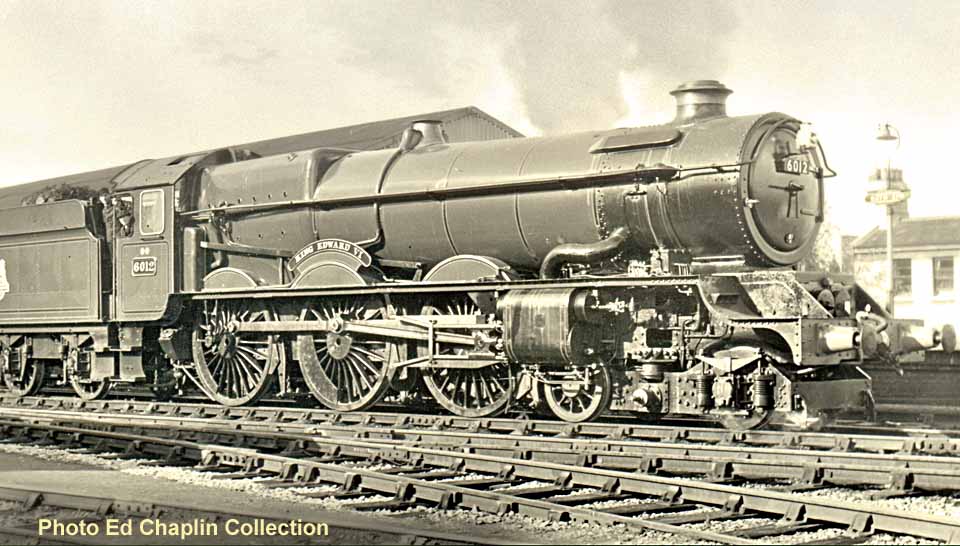
(Above) Sparkling ex-works 'King' class 4-6-0 No 6012 'King Edward VI' appears on a local train at Bath Spa on a sunny October day in 1954. A trip from Swindon to Bath was the standard jaunt for a newly repaired engine; a gentle running-in turn under the guidance of an experienced crew to ensure that all was well and the steaming of the boiler was top-notch. The boiler has just been upgraded from the original WA type to a WB version; this had a 24-element, 4-row superheater which considerably improved the performance of these ageing locomotives by increasing their steaming capabilities. It appears that the crosshead guide bars have been renewed; they ensure that the piston rod stays rigidly on a level plain, thus eliminating any excessive wear of the components, which in turn will cause steam to leak from the cylinder gland and some power will be lost. The position of the sun accentuates every nut and rivet of the leading bogie and we can see that no obvious repairs have been carried out, also the overslung 13 plate multi-leaf road spring accompanied by two heavy duty compression springs are very well presented here. No 6012 was a long time resident at Plymouth Laira (83D), but the engine moved to Old Oak Common (81A) depot following this Works visit and basically completed its service from there, although it did 'retire' to Stafford Road for its final few months. It is possible to see on this image that the front lining band continues up and over the cover for the superheater lubricating pipes, just behind the smokebox, thus the majority of the cover is painted black, but the rearmost part is Brunswick Green. 
BR MODIFICATIONS
1. New front frames, indicated by the large support washer on the frame end, not yet seen.
2. Extended covers for inside valves added later [02/58].
3. Modified outside steam pipes [1953].
4. WB boiler [10/54].
5. New pattern single chimney now added [double chimney fitted 02/58].
6. Mechanical lubrication unit [now in final position].
7. Leading bogie has welded repairs done [02/56].
8. Cab roof vents inserted [1954].
9 BR first emblem still extant, new emblem added later [02/58).
10. Raised step over the inside cylinders, below smokebox, added 09/56. 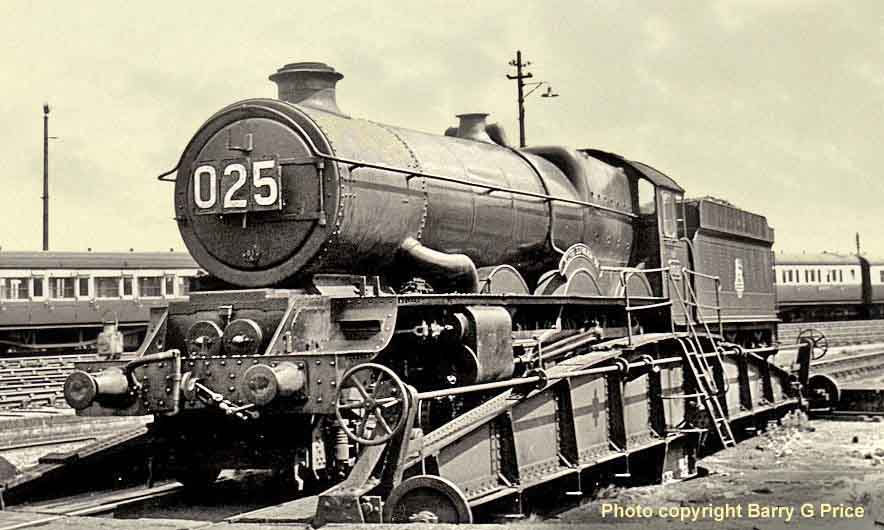
(Above) Waiting to back up to the coaling point to refuel, ex-GWR 'King' class 4-6-0 No 6012 'King Edward VI' poses on the turntable in the yard adjacent to the large coaling stage at Wolverhampton Stafford Road (84A) depot in 1956. This Old Oak Common (81A) engine still has a sleeved single chimney at a time when a high number of classmates were displaying a double chimney. Also the engine was the belated recipient of a new front half-frame in conjunction with extended valve covers; the later-built 'Kings' (6020-6029) were constructed with the extended covers already in place. By 1958 a further thirteen engines had theirs added, leaving just seven to complete their service without any change to their original short covers. The turntable was a typical Great Western affair, with a shallow pit (less dangerous) an overslung frame, but entirely manual, meaning hard work for the crews. Notable on this type were the locking wheels at either end; these were used to lock-in the table before the locomotive moved off; also the short central ladder which was necessary on these early types due to the lack of clearance alongside the engine for the safe passage of the driver. The turntables were designed and constructed by Ransomes and Rapier of Ipswich; the GWR's Engineering Department stipulated that the open pit did not require to be boarded over as long as adequate lighting was provided, but the Stafford Road site seemed to have precious little illumination in place. The backdrop to this picture is Cannock Road sidings which is occupied by some rather elderly coaching stock awaiting their next call of duty. 
(Above) A classic nameplate, tastefully repainted, from the 'King' Class 4-6-0 No 6012 King Edward V1, went under the hammer for £25,000 at a Great Central Railwayana Auction on 3 September 2016. Built at Swindon in April 1928, No 6012 spent almost all its BR days alternating between Laira and Old Oak Common before moving in March 1962 to Stafford Road from where it was withdrawn on 7 September 1962 and sold for scrap to Cox & Danks of Langley Green on 9 October 1963.
BR MODIFICATIONS
1. New front frames, indicated by the large support washer on the frame end, not yet seen.
2. Extended covers for inside valves not yet added [02/58].
3. Modified outside steam pipes [1953].
4. WB boiler [10/54].
5. Single chimney yet [double chimney fitted 02/58].
6. Mechanical lubrication unit [now in final position].
7. Leading bogie had welded repairs done [02/56].
8. Cab roof vents inserted [1954].
9. BR first emblem still extant, new emblem added later [02/58].
10. Raised step over the inside cylinders, below smokebox, added 09/56
.
6013 King Henry VIII 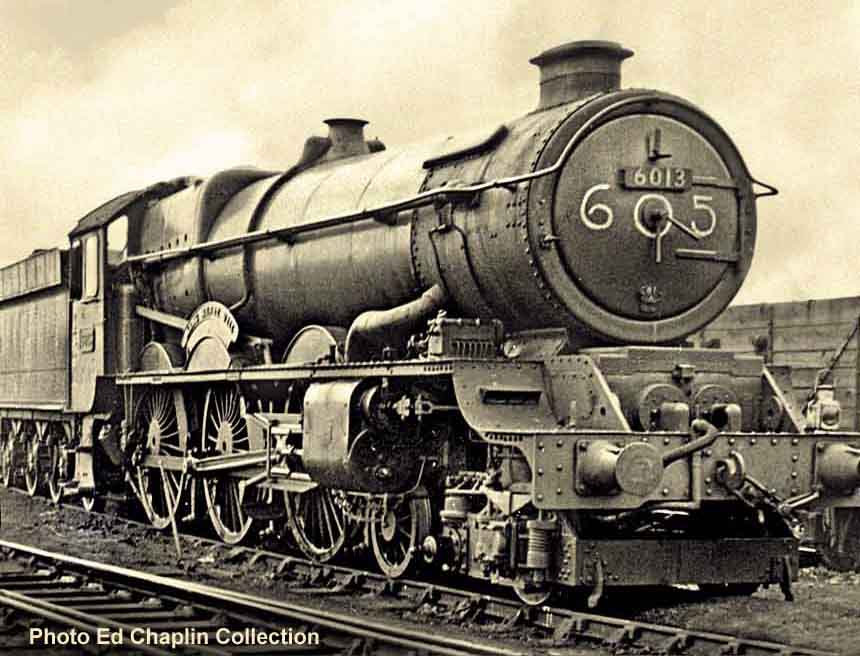
(Above) With a little over two months since ex-GWR 'King' class 4-6-0 No 6013 'King Henry VIII' left Swindon in pristine condition following a Heavy Intermediate repair, the clean, fresh livery is now hidden beneath a coating of soot and grime as the engine waits at Old Oak Common (81A) on September 10th 1956. No 6013 recorded the highest mileage return of all the 'Kings' with a creditable 1,950,462, representing an annual average of 57,000 miles for each of its 34 years in service, the majority being from Old Oak. The engine succumbed early to the problem of frame cracking; this was caused by the driving stresses between the first and second axles as the engine coped with hauling heavy passenger stock over the steeply-graded Devon banks such as Dainton and Hemerdon. A clear view of the front end shows the absence of ATC equipment; however the position of the ATC was hindered by the inside cylinders, and so the fitment was set below the cab floor on all the class members. The scribing of reporting numbers on the smokebox, as seen in this image, was frowned upon by many, simply because it was mostly left in position and became irrelevant and confusing to all and sundry. A fabricated straight-sided sheet steel double chimney was fitted at its recent visit to Swindon Works, along with self-cleaning equipment; this basically caused the ash deposits to be emitted out of the chimney.
BR MODIFICATIONS
1. New front frames, indicated by the large support washer on the frame end, fitted 09/54.
2. Extended covers for inside valves now in view [09/54].
3. Modified outside steam pipes [09/53].
4. WB boiler [10/51].
5. Fabricated double chimney [fitted 06/56].
6. Mechanical lubrication unit [now in final position].
7. Leading bogie has welded repairs done [02/56].
8. Cab roof vents inserted [1954].
9. BR early emblem added [new version 17/10/57].
10. Raised step over the inside cylinders, below smokebox.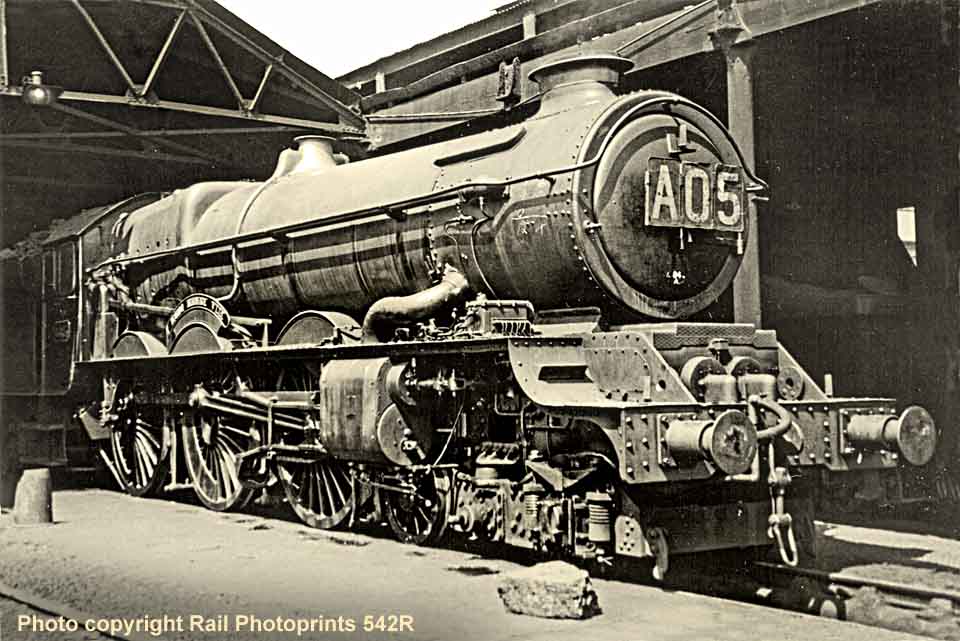
(Above) Ex-GWR 'King' class 4-6-0 No 6013 'King Henry VIII' waits at the decrepit old shed at Wolverhampton Stafford Road, which was about as far north as a 'King' usually ventured until April 1959 when the weight restrictions on the bridge at Shifnal had been lifted on the route north to Shrewsbury, although reports have surfaced suggesting that there were one or two occasional sightings at Ruabon well before that date. Having previously studied the aspects of Wolverhampton Stafford Road loco shed, I am convinced that the building behind the engine was the ash shelter in a previous life, constructed at the tail-end of WW2 to help hide the spent ashes which could be seen from the air. Also I suspect the sizeable lump of coal in the foreground has been deliberately placed there as a 'marker' by crewmen to aid positioning the engine. This 1961 photo clearly shows the later type of buffers that were used on most passenger types; these being somewhat heavier and requiring 8 bolts to secure them to the buffer beam. Also the strong sunshine helps to highlight the extended valve covers for the inside cylinders and the support washers for the engine lifting eyelets on the frame ends. Brought into service in May 1928, the engine worked from Old Oak Common (PDN and 81A) for a total of 32 years, then after a short break in Devon for 11 months, it arrived at Stafford Road (84A) in June 1961 after a Light Casual repair at the local Wolverhampton Works, and having just 12 months of service left. Apart from the inevitable layer of soot and general grime, the engine appears in good condition and was more than two years since its last Heavy General at Swindon Works.
BR MODIFICATIONS
1. New front frames, indicated by the large support washer on the frame end, fitted 09/54.
2. Extended covers for inside valves now in view [09/54].
3. Modified outside steam pipes [09/53].
4. WB boiler [10/51].
5. Fabricated double chimney [fitted 06/56].
6. Mechanical lubrication unit [now in final position].
7. Leading bogie has welded repairs done [02/56].
8. Cab roof vents inserted [1954].
9. BR new emblem added [17/10/57].
10. Raised step over the inside cylinders, below smokebox.
6014 King Henry V11
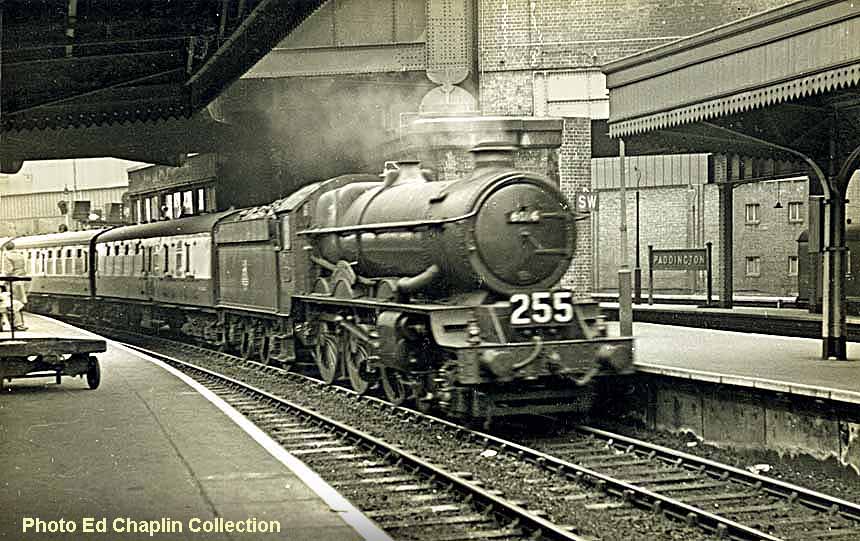
(Above-Inset) Ex-GWR 'King' class 4-6-0 No 6014 'King Henry VII' enters Paddington Station in April 1954 with a train from Shrewsbury. In 1939 No 6014 and 'Castle' class No 5005 Manorbier Castle were selected for the GWR's bizarre semi-streamlining scheme (inset) but as the additional coverings led to 6014's  routine maintenance becoming time consuming and troublesome, the scheme lasted but 5 months and piece by piece the loco was rendered a fully recognisable 'King' again. A remnant of streamlining is the front of the cab which consisted of a wedge-shaped extension measuring two foot deep at its highest point that covered the whistle assembly, therefore requiring steam escape hatches on either side. Also the different position of the train reporting numeral frame was a result of the bullet-shaped cover over the smokebox door being unable to accept a fitment of any sort, however the deferred position above the buffer beam was a bonus and maybe should have been more widely used. With regard to the livery changes, '6014' was the last to be turned out in BR Brunswick Green in February 1954, and equal last of the class to benefit from a WB boiler, albeit a reconditioned one. The rather small cover adjacent to the chimney helps to identify the original WA boiler, the largest possible that CB Collett could design within the constraints of the loading gauge. Also of note in this photograph is the slotted leading bogie which was fitted to eight different members of the class at one time or another.
routine maintenance becoming time consuming and troublesome, the scheme lasted but 5 months and piece by piece the loco was rendered a fully recognisable 'King' again. A remnant of streamlining is the front of the cab which consisted of a wedge-shaped extension measuring two foot deep at its highest point that covered the whistle assembly, therefore requiring steam escape hatches on either side. Also the different position of the train reporting numeral frame was a result of the bullet-shaped cover over the smokebox door being unable to accept a fitment of any sort, however the deferred position above the buffer beam was a bonus and maybe should have been more widely used. With regard to the livery changes, '6014' was the last to be turned out in BR Brunswick Green in February 1954, and equal last of the class to benefit from a WB boiler, albeit a reconditioned one. The rather small cover adjacent to the chimney helps to identify the original WA boiler, the largest possible that CB Collett could design within the constraints of the loading gauge. Also of note in this photograph is the slotted leading bogie which was fitted to eight different members of the class at one time or another.
BR MODIFICATIONS
1. New front frames not ever seen.
2. Covers for inside valves remained original [short].
3. Modified outside steam pipes [1953].
4. WA boiler still in position [WB type 10/56].
5. Single chimney still in place [double version 09/57].
6. Mechanical lubrication unit not yet added [10/56].
7. Leading bogie had welded repairs done later [02/56].
8. Cab roof vents no yet inserted [1954].
9. BR original emblem added [new emblem on 20/09/57].
10. Raised step over the inside cylinders, below smokebox, not yet fitted. 
(Above) Heading a London to Birmingham and Wolverhampton express in the summer of 1956, ex-GWR 'King' class 4-6-0 No 6014 'King Henry VII' appears to have plenty of steam for the five mile climb of Hatton Bank from Warwick to the Midlands Plateau. This high vantage point shows the extended cab roof covering the whistle assembly, a remnant of the 1935 semi-streamlining; a vision completely at odds with CB Collett himself. Also of note is the small cover at the front of the boiler above the handrail line, indicating that an original WA boiler is still fitted; this was replaced by a WB boiler October 1956, more than 8½ years after the pilot unit was fitted to classmate '6022'. The front frames were not seen to be altered on this engine, but they were fitted to 14 engines and involved a complete strip down of all components to be able to cut through the frames on both sides at a point halfway between the first and second drive axles. The new half-frames, as they were termed, had to be optically aligned with the remaining rear sections before marrying the two divisions by welding. Some of these jobs took the best part of four months to complete, involving the removal of the boiler along with the drive wheel axles and cylinder assemblies, not to mention all the ancillaries concerned. The photos above and below are reproduced courtesy of the excellent Warwickshire railways.com website HERE.
BR MODIFICATIONS
1. New front frames not ever seen.
2. Covers for inside valves remained original [short].
3. Modified outside steam pipes fitted [1953].
4. WA boiler still in position [WB type 10/56].
5. Single chimney still in place [double version 09/57].
6. Mechanical lubrication unit not yet added [10/56].
7. Leading bogie has had welded repairs done [02/56].
8. Cab roof vents now inserted [1954].
9. BR original emblem added [new emblem on 20/09/57].
10. Raised step over the inside cylinders, below smokebox, is now fitted. 
(Above) Ex-GWR 'King' class 4-6-0 No 6014 'King Henry VII' awaits departure from Birmingham Snow Hill Station with the 08.55 from Birkenhead to Paddington, a journey involving three locomotive changes at Chester, Shrewsbury and Wolverhampton Low Level. In February 1954, '6014' was fitted with a device developed by ICI to monitor the hard water deposits in the boiler while the engine was in service; the engine was then transferred to Stafford Road shed to aid technicians in the development of the 'Alfloc' water treatment which subsequently increased the duration of time between boiler washouts to thirty days. Eventually all of Stafford Road's engines were likewise treated, including many 'Castle' class locomotives and seventeen 'Kings'. Following the removal of the locomotive's semi-streamlining in 1935, the position of the train identification frame above the buffer beam remained unaltered until the engine was withdrawn in September 1962. Later type buffers are now in position, normally added from around 1960, hence they were not utilised for long and on some engines they were replaced with the old tapered type buffers again. When the 'Kings' bogie crisis was at its zenith in early 1956, '6014' was seen at Stafford Road depot without its leading bogie and in a similar condition were Nos 6015 and 6016 of Old Oak Common - all awaiting refurbished units prior to their return to service. It is not out of order to say that
from its conception - and on the many occasions throughout its service history -
the bogie assembly was the weak-link of the 'King' class.
BR MODIFICATIONS
1. New front frames, indicated by the large support washer on the frame end, were not fitted.
2. Original covers for inside valves, remained the same.
3. Modified outside steam pipes [1953].
4. WB boiler [10/56].
5. Cast-iron double chimney now added [09/57].
6. Mechanical lubrication unit [now in final position].
7. Leading bogie had welded repairs done [02/56].
8. Cab roof vents inserted [1954].
9. BR new emblem added on 20/09/57.
10. Raised step over the inside cylinders, below smokebox, now fitted.
6015 King Richard III 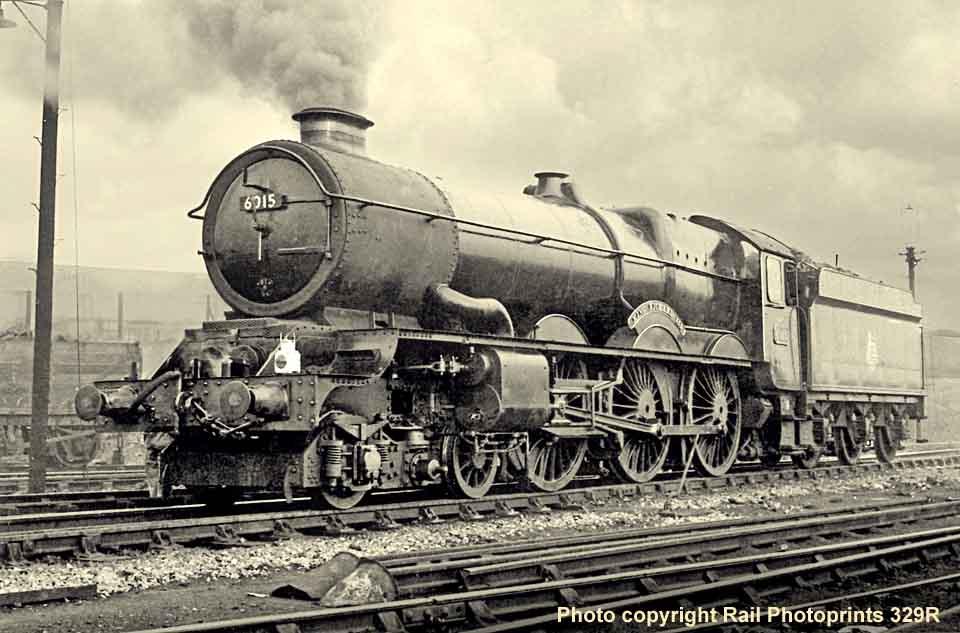
(Above) In this view of ex-GWR 'King' class 4-6-0 No 6015 'King Richard III' at Old Oak Common depot in March 1956, there is no lubrication unit to be seen, only a small relay unit awkwardly placed under the now-modified outside steam pipe; however there is a good view of the external bearings and increased tension on the leaf springs of the leading bogie assembly. The photo was taken following a period dubbed the 'King Crisis' when all but three members of the class were taken out of service due to failure of the leading bogie assemblies. During November 1955, 50% of the engines were out of action and in the early months of 1956 more locomotives entered Swindon Works; indeed these were desperate times for the whole class. However the precursor to this mayhem was the introduction of the first double chimney as fitted to '6015' in September 1955. The following month the engine was nominated for speed trials on the 'Bristolian' which revealed a marked reduction in the back pressure in the smokebox and produced a more powerful engine, even when using the poorer quality coal that was prevalent after World War II. Unfortunately 6015 was yet another 'King' to succumb to a hot axle, resulting in it being left stranded at Bristol Bath Road workshops requiring a new front crankshaft axle in 1958 (ref Kenneth H Leech).
BR MODIFICATIONS
1. New front frames, indicated by the large support washer on the frame end, now seen.
2. Extended covers for inside valves added [09/55].
3. Modified outside steam pipes [1953].
4. WB boiler [10/52].
5. Fabricated double chimney [fitted 09/55].
6. Mechanical lubrication unit [now in final position].
7. Leading bogie has welded repairs done [02/56].
8. Cab roof vents inserted [1954].
9. BR first emblem still extant, new emblem added later [05/58].
10. Raised step over the inside cylinders, below smokebox, now added[1955]. 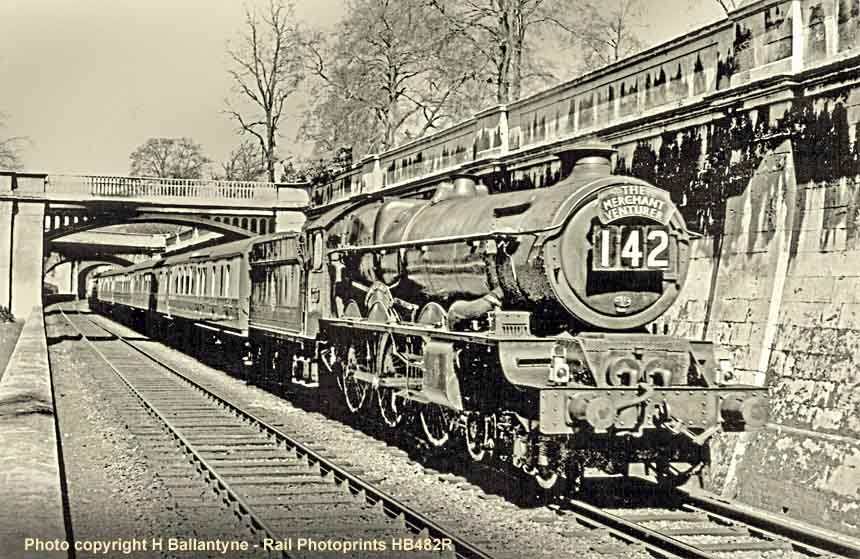
(Above) In April 1956, Hugh Ballantyne took this photograph of Ex-GWR 'King' class 4-6-0 No 6015 'King Richard III' heading the down 'Merchant Venturer' through Bath's Sydney Gardens, an area of parkland originally laid down in the 1790s, long before the Great Western Railway intruded upon its grounds. The 'Merchant Venturer' service between Paddington and Weston-Super-Mare via Bristol was named in 1951 after a private entrepreneurial and charitable organisation dating back to the 13th century. The Society of Merchant Venturers helped to fund both the building of Brunel's Clifton Suspension Bridge and the Great Western Railway. The alloy titled train headboard had a brown background, but this was replaced by a cast headboard painted yellow and topped by the relevant coat of arms. In 1955, '6015' was the first 'King' to be fitted with an experimental double chimney made from sheet steel which eradicated back pressure in the smokebox and created a better steaming engine. During tests on the 'Cornish Riviera' express, the engine logged 103mph in the first week and 107mph was recorded the following week. 6015 was withdrawn from traffic in September 1962 and dismantled at the West Midland scrap merchants Cox & Danks of Oldbury, one of eleven 'Kings' to follow the same trail.
BR MODIFICATIONS
1. New front frames, indicated by the large support washer on the frame end, now seen.
2. Extended covers for inside valves added [09/55].
3. Modified outside steam pipes [1953].
4. WB boiler [10/52].
5. Fabricated double chimney [fitted 09/55].
6. Mechanical lubrication unit [now in final position].
7. Leading bogie has welded repairs done [02/56].
8. Cab roof vents inserted [1954].
9. BR first emblem still extant, new emblem added later [05/58].
10. Raised step over the inside cylinders, below smokebox, now added [1955].
6016 'King Edward V 
(Above) Having arrived at Bristol Temple Meads with the 'Merchant Venturer' express from Paddington in 1957, ex-GWR 'King' class 4-6-0 No 6016 'King Edward V' will be disposed of at Bath Road shed whilst a lighter engine will take over the train for the remainder of the journey to Weston-super-Mare. The rather grubby paintwork was not the norm for any 'King', but this particular engine was, according to records, overdue for its next Heavy General repair at Swindon Works and a minimal amount of cleaning of locomotives was carried out during the very busy summer holiday period. An early type of chimney (3 steps) should be noted, plus the front half frames have been replaced (from July 1954) with the date indicating a rather premature failure of the main frame. Four different chimneys were to be seen fitted to many class members as Swindon Works strove to improve the steaming of engines having to use coal of dubious quality during the post-war years; the standard early version with a capuchon (lip) gave way to a sleeved variant, seen from 1952, followed by the fabricated double chimney that was to be found on 50% of 'Kings' before all class members were adorned with the elliptically shaped cast-iron double chimney used from November 1956. This particular 'King' ran into the rear of a stationary train at Bristol Temple Meads station, causing injury to 3 passengers and was under repairs for a period of 6 weeks at Bristol Bath Road, 'The Merchant Venturer' express service was introduced in 1951 stopping only at Bath Spa on its way down from London Paddington, whereas the up train called at Swindon, Chippenham and Reading General on its return to London.
BR MODIFICATIONS
1. New front frames, indicated by the large support washer on the frame end, seen from 12/54.
2. Extended covers for inside valves [12/54].
3. Modified outside steam pipes [1953].
4. WB boiler [02/53].
5. Single chimney extant, cast-iron double chimney fitted 01/58.
6. Mechanical lubrication unit [now in final position].
7. Leading bogie has welded repairs done [01/56].
8. Cab roof vents inserted [1954].
9. BR early emblem added.
10. Raised step over the inside cylinders, below smokebox. 
(Above) Ex-GWR 'King' class 4-6-0 No 6016 'King Edward V' awaits departure with the 11.15am 'Merchant Venturer' at Paddington Station in 1958. A regular duty for an 81A 'King',
this titled train was so named in April 1951 to celebrate the Festival of Britain; indeed the Western Region
nominated a host of expresses for naming around this period and designed some excellent and colourful headboards, which also included the relevant coat of arms, in this case the Merchant Venturers of Bristol coat of arms - along with the Latin quotation 'Indocilis Pauperium Pati' (A poor man to suffer ignorance) - all of which added prestige to an already smart service. The less than pristine 'King' has all the modifications in place although the engine received no repairs during 1958, but following a Heavy General repair at Swindon, it started the year with its cast-iron chimney fitted and a second change of the WB boiler, providing more steaming capabilities. In fact the locomotives were far superior performers than at any time previously in their careers and although much extra weight had been added, the class were at their zenith at this late stage. Maintenance records strongly suggest that the leading bogie failed late in 1955 and what was thought to be a rare occurrence or a mere trickle was, in fact, the start of a torrent of trouble as one engine after another were diagnosed as needing urgent attention to rectify cracks within the plate frames of the leading bogie, resulting in the withdrawal of 27 'Kings' in January 1956. Shed allocations were about average for the class; more than 25 years resident at one particular depot (Plymouth) No 6016 then moved around between Stafford Road, Old Oak and Laira again before a final ignominious ending at Wolverhampton for the last 3 months from June 1962, leading to disposal at Cox & Danks of Oldbury, a scrap merchant responsible for dismantling ten other class members.
BR MODIFICATIONS.
1. New front frames, indicated by the large support washer on the frame end, now seen [12/54].
2. Extended covers for inside valves [added 12/54].
3. Modified outside steam pipes [1953].
4. WB boiler [02/53].
5. Cast-iron double chimney [fitted 01/58].
6. Mechanical lubrication unit [now in final position].
7. Leading bogie has welded repairs done [01/56].
8. Cab roof vents inserted [1954].
9. BR later emblem added [01/58].
10. Raised step over the inside cylinders, below smokebox.
6017 King Edward IV 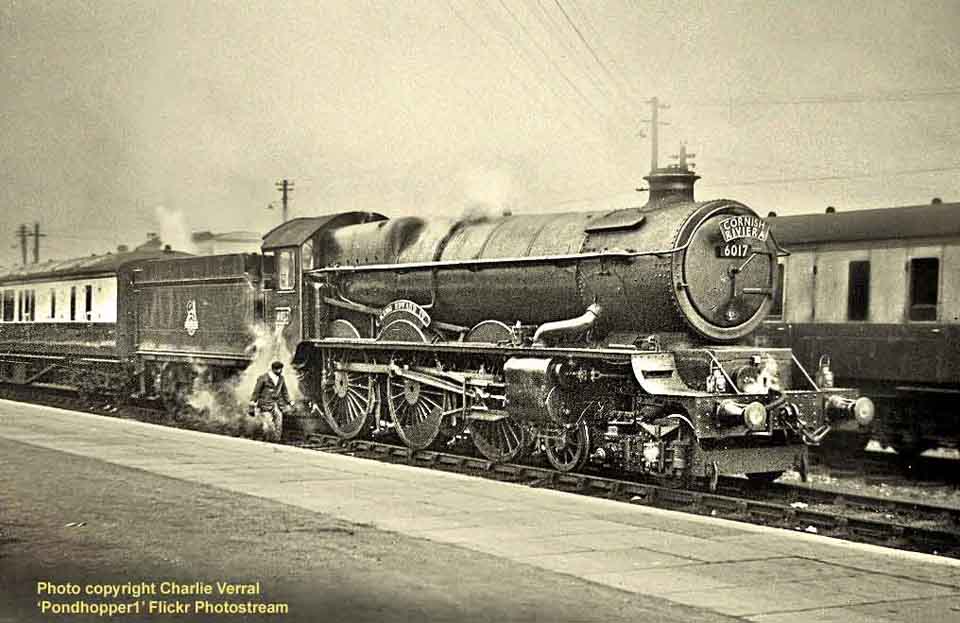
(Above) Ex-GWR 'King' class 4-6-0 No 6017 'King Edward IV' awaits the assistance of a pilot engine at Newton Abbot before tackling the south Devon banks to Plymouth with down 'Cornish Riveria' on 7 September 1952. No 6017's front half-frames were changed at Swindon Works between September to December 1955, one of four engines to be treated that year. The work involved a complete strip down of all components prior to cutting through the frames on both sides at a point midway between the first and second drive axles; the new half-frames were then optically aligned with the remaining rear sections before the two divisions were reset by welding. The stripping down also involved the removal of cylinders and axles, whilst all components were checked for serviceability and a reconditioned boiler fitted. Following completion of the work, the prominent visual changes to the front of the locomotives included the fitting of two large support washers to reinforce the lifting eyelets on the frame end, and in almost all cases (except for '6019') the originally short covers for the inside valves were extended in unison. The leading bogie of a 'King' class locomotive does not have simple movement about a horizontal point and must be free to slip sideways to enable the engine to follow curves accurately, however this required a springing mechanism to ensure the bogie returned to its natural centre. Control of this lateral movement was achieved by the use of helical coiled springs working against a journal to a limit of 3.22 inches. The sliding bogie of this type was patented by William Adams in 1865. Withdrawal of '6017' came in July 1962 with a recorded mileage of 1,853,262.
BR MODIFICATIONS
1. New front frames were fitted 12/55.
2. Original covers for inside valves [changed 12/55].
3. Original outside steam pipes [modified 1953].
4. WB boiler [08/52].
5. Single chimney still [fabricated type fitted 12/55].
6. Mechanical lubrication unit in place [in first position].
7. Leading bogie had welded repairs done later [02/56].
8. Cab roof vents not yet inserted [1954].
9. BR old emblem added.
10. Diamond treadplate added over the inside cylinders, below smokebox. 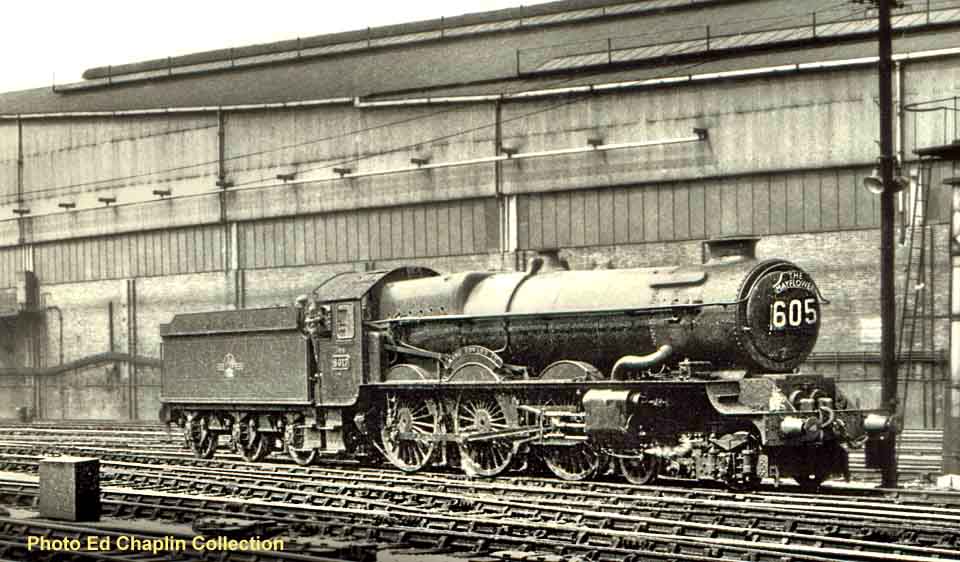
(Above) Still displaying the 'Mayflower' headboard from its journey to the capital, ex-GWR 'King' class 4-6-0 No 6017 'King Edward IV' backs out of Paddington for servicing at Ranelagh Bridge depot before its return working to Plymouth. Built in June 1928 and retired in July 1962, this 1957 view reflects the ten main changes to the class. An early recipient of a new WB boiler in August 1952, No 6017 was used for draughting experiments following tests carried out with ex-LNER Class V2 No 60845, which reportedly returned to Doncaster from its long stint at Swindon with its 'King' chimney still extant. In December 1955, No 6017 was one of fifteen class members to be seen with the early version of the fabricated double chimney; the others perceived were: 6001-2, 6005-7, 6009-11, 6013, 6015, 6020, 6022, 6027 and 6029. 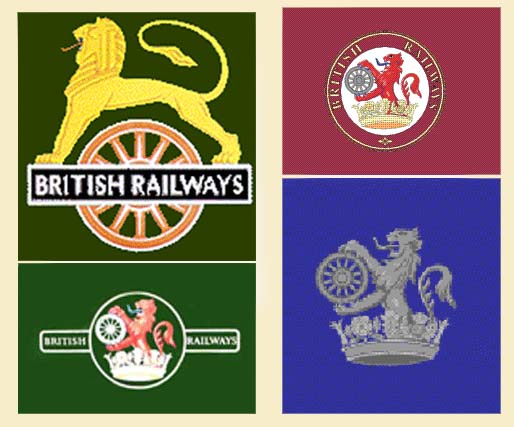 Unusually, the engine was seen on the wheel-drop at Bristol Barrow Road depot in August 1950, as Bath Road did not have the equipment to cope with the operation. The rather grubby engine is displaying the new British Railways crest on the tender, albeit the lion is facing to the front of the locomotive which, unbeknown to BR, fell foul of the British Transport Commission's agreement with the College of Heraldry for the use of their registered left-facing lion (right) and as a consequence BR was instructed to replace all the offending heraldic devices with the correct ones as issued by the college. 6017 had spells at all of the sheds that housed the 'Kings' (except for Cardiff Canton) and accumulated a total of 14 years of service during two spells at Stafford Road depot. Withdrawn from Wolverhampton and cut up locally by Cox & Danks of Langley Green.
Unusually, the engine was seen on the wheel-drop at Bristol Barrow Road depot in August 1950, as Bath Road did not have the equipment to cope with the operation. The rather grubby engine is displaying the new British Railways crest on the tender, albeit the lion is facing to the front of the locomotive which, unbeknown to BR, fell foul of the British Transport Commission's agreement with the College of Heraldry for the use of their registered left-facing lion (right) and as a consequence BR was instructed to replace all the offending heraldic devices with the correct ones as issued by the college. 6017 had spells at all of the sheds that housed the 'Kings' (except for Cardiff Canton) and accumulated a total of 14 years of service during two spells at Stafford Road depot. Withdrawn from Wolverhampton and cut up locally by Cox & Danks of Langley Green.
BR MODIFICATIONS
1. New front frames, indicated by the large support washer on the frame end, fitted 12/55.
2. Extended covers for inside valves [12/55].
3. Modified outside steam pipes [1953].
4. WB boiler [08/52].
5. Fabricated double chimney fitted 12/55 [cast-iron version from June 1957].
6. Mechanical lubrication unit [now in final position].
7. Leading bogie has welded repairs done [01/56].
8. Cab roof vents inserted [1954].
9. BR new emblem added 06/57 [facing wrong way].
10. Raised step over the inside cylinders, below smokebox. 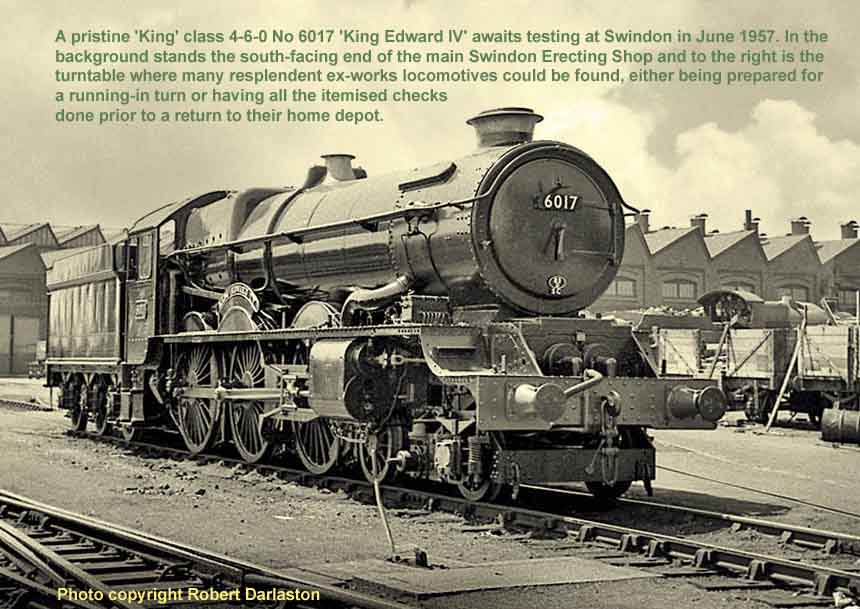
(Above) A pristine 'King' class 4-6-0 No 6017 'King Edward IV' awaits testing at Swindon in June 1957. The Swindon Factory was always capable of turning out a quality product, be it an 0-6-0 pannier tank or a top notch express engine such as this. The locomotive is in its final form, with the notable exception of the original tapered buffers, which were replaced in 1958. The modifications carried out at this time included the new elliptically shaped cast-iron double chimney which replaced the straight-sided, fabricated version that saw service on fourteen other 'King' engines. The Laira (83D) based engine is also displaying the (SC) plate indicating that it is fitted with 'self cleaning equipment', so designed to ease the task of cleaning out the smokebox on a daily basis by emitting ash deposits out through the chimney. Designed by CB Collett, the ultimate 4-6-0 4-cylinder engine had a tractive effort of 40,285 lbs and was dubbed the 'most powerful engine in the land', but the power/weight ratio was not in its favour…in other words, the locomotive had to expend much effort simply to move its own weight. It is certainly doubtful that the additional expenditure of constructing new wheels and different sized crank-axles, not to mention the No 12 boiler, was a worthwhile cost to pay for the prestige and 'bragging rights' associated with the higher tractive effort figure. In 1952, the engine gained a WB boiler (as well as green livery) and Swindon Workshops fitted an experimental sleeved chimney and a smaller blastpipe to improve its steaming capability which was suffering due to general usage of inferior coal following WW2.
BR MODIFICATIONS
1. New front frames, indicated by the large support washer on the frame end, now seen.
2. Extended covers for inside valves now added[12/55].
3. Modified outside steam pipes [1953].
4. WB boiler [08/52].
5. Cast-iron double chimney now fitted [first type 12/55].
6. Mechanical lubrication unit [now in final position].
7. Leading bogie has welded repairs done [01/56].
8. Cab roof vents inserted [1954].
9. BR new emblem added [facing wrong way].
10. Raised step over the inside cylinders, below smokebox.
6018 King Henry VI 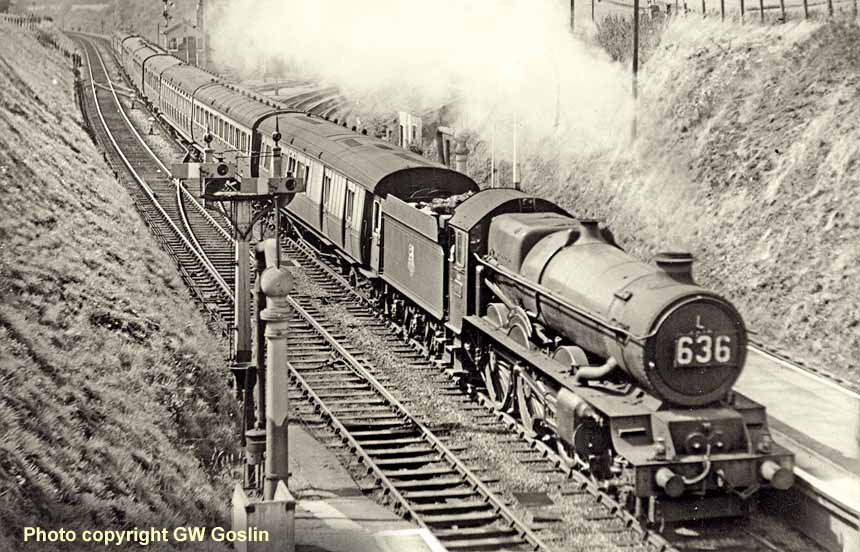
(Above) Ex-GWR 'King' class 4-6-0 No 6018 'King Henry VI' eases through Savernake Junction Low Level station with train '636', a relief to the up 'Cornish Riviera' which ran some 10 minutes before the main express; note the elderly coaching stock, including a 'Dreadnought'. Savernake is in the County of Wiltshire, where the branch for Marlborough can be seen diverging right towards Swindon. '6018' was finished in a light blue livery, similar to the old Caledonian Railway Blue in Scotland until it was turned out in the preferred Brunswick Green in April 1952, and so I am fairly confident that this image dates from the summer of 1952, as only one of the ten BR modifications (as listed below) has been done, this being the addition of the early emblem (item 9). The high viewpoint clearly shows the absence of a cab roof vent and this aids to identify the present chimney as being an early type with a capuchon (lip) fitted to prevent a downdraught, which would be in unison with a 'jumper' ring on the blastpipe giving a wider opening when the engine was working hard. '6018' was the engine selected in the 1948 British Railways Locomotive Exchanges for tests between Kings Cross and Leeds over the East Coast main line route, but its performance was marred by heavier coal consumption hence overall it did not compare favourably. No 6018 was a long-term resident of Newton Abbot shed from early 1929 to the final days of 1948 and from about that time the locomotive was in possession of the unique slotted bogie.
BR MODIFICATIONS
1. New front frames, indicated by the large support washer on the frame end, not ever seen.
2. Extended covers for inside valves stayed original [short].
3. Modified outside steam pipes [1953].
4. WA boiler is still fitted [WB type 12/53].
5. Cast-iron double chimney added later [fitted 03/58].
6. Mechanical lubrication unit [now in first position].
7. Leading bogie has welded repairs done [02/56].
8. Cab roof vents inserted [1954).
9. BR early emblem added [new type 03/58].
10. Raised step over the inside cylinders, below smokebox, not completed. 
(Above) Derived from Churchward lineage, CB Collett's 'King' class was considered to be his best design, even more so than his wonderful 'Castle' class locomotives. Here No 6018 'King Henry VI' certainly looks a picture at Old Oak Common (81A) depot in 1956; although 6018 received fewer modifications than most of its classmates it managed to last longer in service despite surviving a broken crank; a signalman at Waltham near Maidenhead, noticed the centre wheel of the 'King' was wobbling as it passed his box at the head of an express and promptly relayed a message to the next man to halt the train, thus averting a certain crash. The fracture was caused by the build-up of heat within the bearing assembly due to a lack of lubrication or else water ingress was the cause of failure; it was fairly common for rain water to find its way into the 'wheel box' and this would mix with the grease causing a thinning of the lubricant. The actual point of the break, or rupture was always relevant and simply down to luck, determining whether the wheel would stay in position or be set free, resulting in a derailment of some kind. It was surprising that the crew noticed nothing untoward at the time, despite travelling at around 60 mph, but they must have felt very relieved that the signalman was alert to the problem. In this view the engine has a single chimney (detectable by the 3 'steps') with a sleeve; it was never fitted with an early type fabricated double chimney (50% of 'Kings' did) but had to wait until March 1958 before benefiting from cast-iron version. Also of note is the recessed first axle wheel splasher due to the position of the steam-sander filling cap and its relevant operating lever on the boiler walkway.
BR MODIFICATIONS
1. New front frames, indicated by the large support washer on the frame end, not ever seen.
2. Extended covers for inside valves stayed original [short].
3. Modified outside steam pipes [1953].
4. WB boiler [12/53].
5. Cast-iron double chimney added later [fitted 03/58].
6. Mechanical lubrication unit [now in first position].
7. Leading bogie has welded repairs done [02/56].
8. Cab roof vents inserted [1954].
9. BR early emblem added.
10. Raised step over the inside cylinders below smokebox. 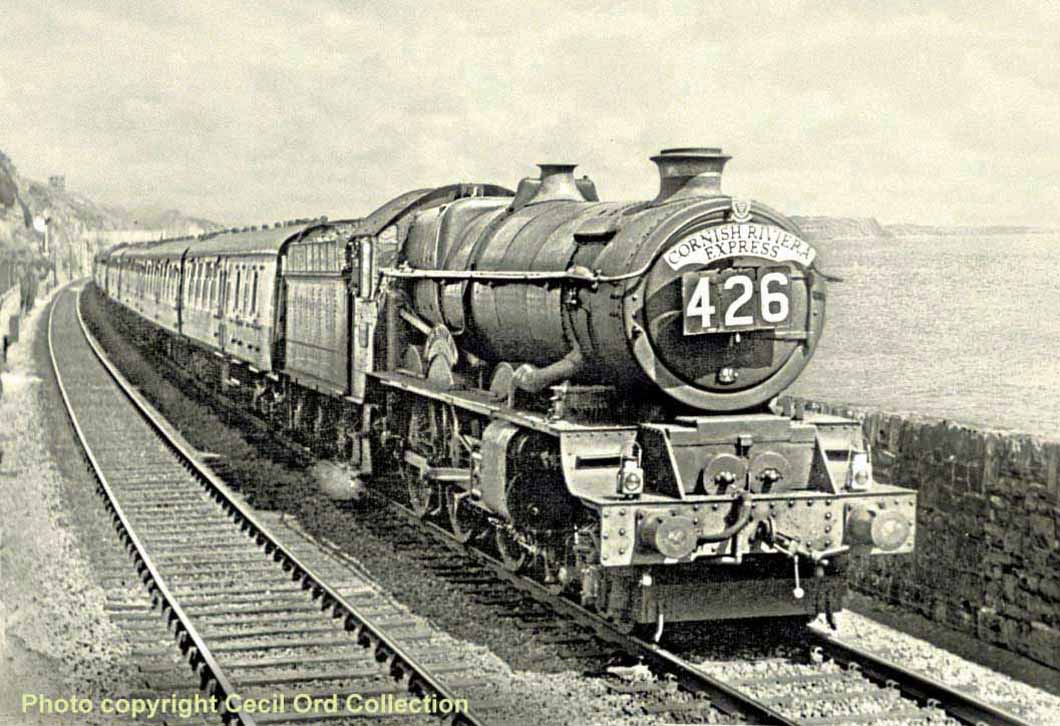
(Above) Ex-GWR 'King' class 4-6-0 No 6018 'King Henry VI' runs along the Dawlish coastline, which, despite being partially sheltered on the fringes of the English Channel, is a vulnerable stretch of line suffering many instances of structural damage due to severe storms. The pristine keystone-shaped named train headboard is bearing Sans Gill lettering showing 'Express' instead of 'Limited' topped off with the Cornwall County Council's coat of arms, granted in the 1940s and based on the '15 Bezants' (gold coins) ransom paid by the 'Black Prince' for 'King Edward I' who was then the Earl of Cornwall. This wonderful view from 1959 shows a modified engine in its final form, with only the front buffers to be changed from the early tapered variety to the heavier straight barrelled type, albeit somewhat belatedly in 1960. Adjacent to the double chimney is a long narrow cover which protects the superheater pipes and indicates that the newer WB boiler is fitted, replacing the original WA boiler which could be seen on some engines until 1956. In May 1939, a report from Swindon Drawing Office asked for a 50% increase in superheating in order to offset the bad effects of poor quality coal, and this prompted, if somewhat slowly, a start being made on improving the heating surface of the superheater initiated by FW Hawksworth. The rebuilt boiler was fitted to '6022' in March 1948 for test purposes and the success of the project led to the construction of 34 new WB boilers which were fitted to all the 'Kings' from 1951 to 1956.
BR MODIFICATIONS
1. New front frames, indicated by the large support washer on the frame end, not ever seen.
2. Extended covers for inside valves stayed original [short].
3. Modified outside steam pipes [1953].
4. WB boiler [12/53].
5. Cast-iron double chimney now added [fitted 03/58].
6. Mechanical lubrication unit [now in final position].
7. Leading bogie had welded repairs done [02/56].
8. Cab roof vents inserted [1954].
9. BR new emblem added [but facing to the right on offside].
10. Raised step over the inside cylinders, below smokebox.
6019 King Henry V 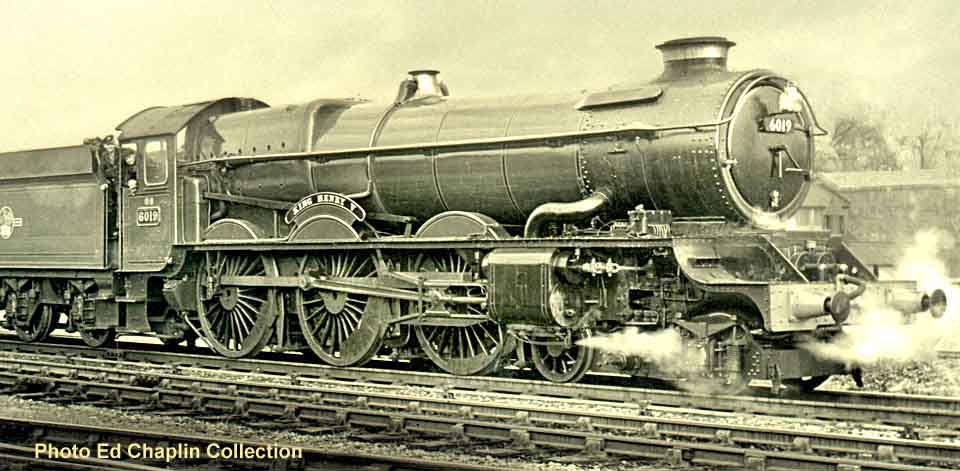
(Above) Another beautifully presented ex-GWR 'King' class locomotive fresh from the workshops at Swindon in April 1957. Here No 6019 'King Henry V is taking the usual running-in turn from Swindon to Chippenham, aided and abetted by an experienced crew in order to assess any possible repairs prior to the locomotive being released back to Old Oak Common shed. No 6019 'King Henry V' was unique in that it was the only 'King' to have the inside valve covers lengthened without the front frames being altered at any time. Of the entire class, Nos 6000-6019 had the short covers from new, but these were later extended on 60% in conjunction with front half frames; whereas Nos 6020-6029 had the extended covers from new, with only two of these receiving the new front frames…thus making '6019' the odd one out. 'King Henry V' was completed in 1928 and worked consistently well until its demise in September 1962. With the exception of Exeter depot, No 6019 had spells at all the sheds allotted the 'King' class engines and it was one of only three to be allocated to Bristol Bath Road (82A) in the BR era. Noteworthy on this particular image is the rodding and leverage on the boiler walkway to operate the sanding equipment; this can be seen adjacent to the first axle wheel splasher, with a further rod passing beneath the boiler to operate the nearside mechanism; this enabled the driver to control both sides in unison.
BR MODIFICATIONS
1. New front frames, indicated by the large support washer on the frame end, not ever seen.
2. Extended covers for inside valves now applied.
3. Modified outside steam pipes [1953]
4. WB boiler [09/55].
5. Cast-iron double chimney [04/57].
6. Mechanical lubrication unit [now in final position].
7. Leading bogie has welded repairs done [03/56].
8. Cab roof vents inserted [1954].
9. BR new emblem added [facing wrong way] 28/04/1957.
10. Raised step now over the inside cylinders, below smokebox. 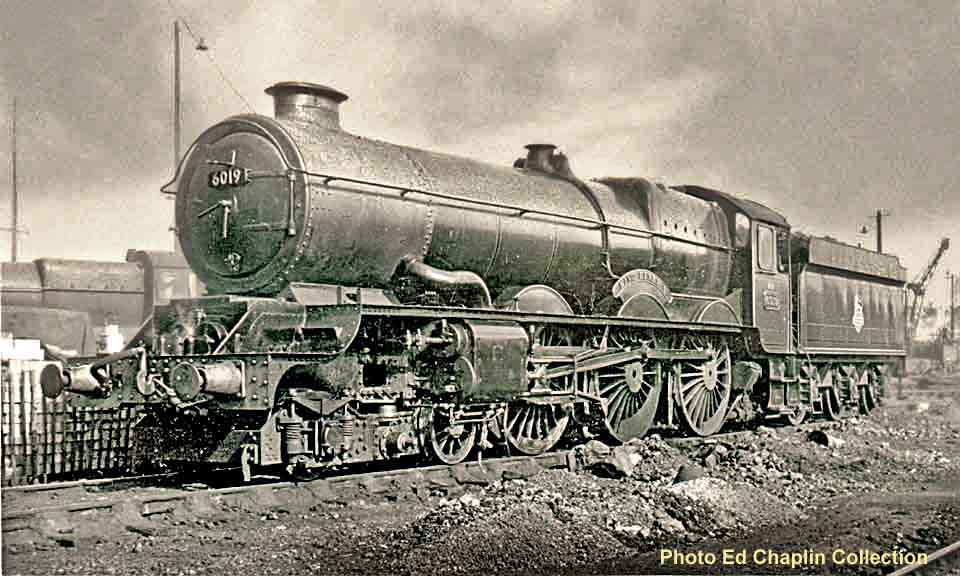
(Above) Ex-GWR 'King' class 4-6-0 No 6019 'King Henry V' stands amidst the spent ash alongside the enormous coaling stage at Old Oak Common. The old emblem on the tender suggests the photo was taken in 1957, but pinning down the actual date is unfathomable since 6019's tender was changed no less than 6 times from June 1956 to November 1957 (a period of 18 months) with four of the interchanges taking place at shed locations, hence it is perfectly feasible that a new emblem was seen after April 1957, only for it to revert back to the early emblem within four months, or vice versa. From this low angle the cast-iron double chimney appears to be overly tall, almost to the point of equalling those added to many 'Castle' class engines. The viewer should be able to pick out the extra fillet of steel welded to the inclined top edge of the leading bogie frame, just behind the front wheel and immediately next to the second coil spring of the first axle. From this half-angle shot we are treated to a close look at the detail of the leading bogie, a uniquely designed, complex unit that caused much chagrin from its early days until well into the later 1950s. The heavy duty coiled springs are self-evident, being added very early to the ends of the 15-plate semi-elliptical leaf springs to rectify a suspension that was found to be 'too soft'; the springs were also fitted to the bogie's second axle, which is not visible unless the unit is removed. Side stresses are borne by the large centrally positioned bosses which are in constant contact with the frame brackets that have two integral webs for extra strength. The large housings beneath the bosses contain compressed springs which help to lock the whole unit in place, but still allow lateral movements which are crucial to the locomotive's ability to negotiate curved sections of track at speed. Also of note from this view are the taper buffers still being used and the 'SC' plate below the shed code, indicating that self-cleaning equipment was fitted, generally in use from the time of fitting of a double chimney. Plymouth Laira (LA) was the main shed allocation for this engine (13 years) but it also served well for Old Oak Common (81A) and was one of eight class members to serve at Cardiff Canton (88A) depot from September 1960.
BR MODIFICATIONS.
1. New front frames, indicated by the large support washer on the frame end, not ever seen.
2. Extended covers for inside valves applied from 1957.
3. Modified outside steam pipes [1953].
4. WB boiler [09/55].
5. Double chimney [04/57].
6. Mechanical lubrication unit [now in final position].
7. Leading bogie has welded repairs done [03/56].
8. Cab roof vents inserted [1954].
9. BR new emblem added [most likely] 08/1957.
10. Raised step over the inside cylinders, below smokebox can be seen. 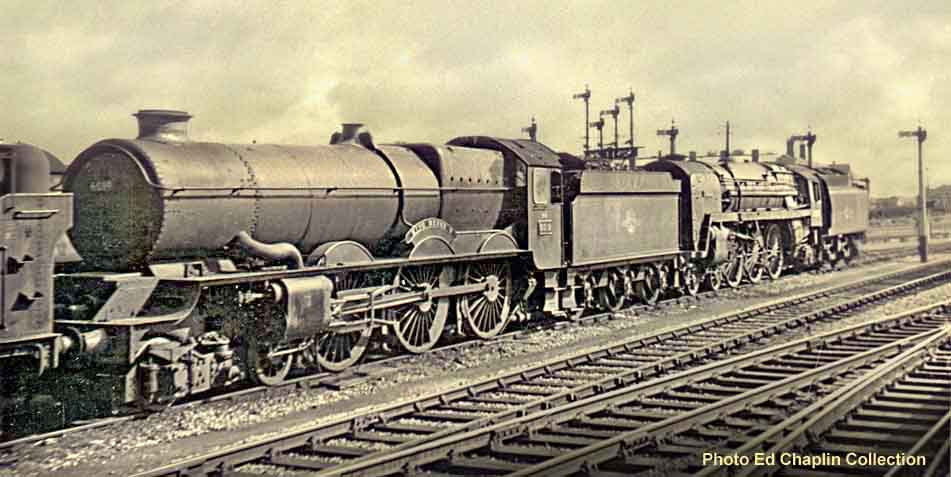
(Above) Ex-GWR 'King' class 4-6-0 No 6019 'King Henry V' stands at Swindon in the company of a slightly larger BR Standard Class 7MT 'Britannia' Pacific No 70022 'Tornado' of Cardiff Canton depot; both engines awaiting entry into the nearby Works in the Summer of 1959. When the BR Standard classes were introduced to traffic, comparisons were bound to be made with the former 'Big Four' railway company's engines; this was particularly the case for the GWR's exceptionally devoted enginemen who preferred their Swindon-built locomotive over any competition, but the 'Britannia' Pacifics did prove their worth in the right hands. In this 1959 picture all the relevant modifications have been completed, and as can be seen there was no mechanical lubrication unit on this nearside, only a small relay, receiving oil from the main feed on the offside, which supplied the required increments to the superheater, valves and cylinders. The wheelbase of the leading bogie was lengthened 8 inches on the instructions of Collett from the normal size of 7 foot, to help to accommodate the larger boiler, while the wheels were reduced from 3ft 2in to 3ft in order to increase the clearance below the inside cylinders. Repairs have been carried out on the bogie to help rectify the stress cracking that was so prevalent from the early 1950s and it is a fact that the design was not a roaring success from the outset; indeed even following modification of the 'too soft' springing, many incidents of broken leaf springs were being discovered, necessitating more work to eliminate the problem. The cure came by way of changing the third drive axle road springs from a thicker to a thinner leaf dimension, then increasing the numbers from 21 to 35 creating a far softer suspension and preventing the issue from reoccurring. No 6019 is displaying the elliptically shaped cast-iron double chimney, fitted April 1957, but did not receive the new front half-frames that usually complemented the extended inside valve covers. Allocation of 6019 'King Henry V' included two short spells at Bristol Bath Road depot and two spells at Old Oak (81A) either side of 18 months spent at Cardiff Canton shed (88A) in South Wales from October 1960.
BR MODIFICATIONS
1. New front frames not ever seen.
2. Covers for inside cylinders now extended [04/57].
3. Modified outside steam pipes [1953].
4. WB boiler [09/55].
5. Cast-iron double chimney now added [04/57].
6. Mechanical lubrication unit [now in final position].
7. Leading bogie had welded repairs done [02/56].
8. Cab roof vents inserted [1954].
9. BR new emblem [added on 28/04/57].
10. Raised step over the inside cylinders, below smokebox, now fitted.
6020 King Henry IV 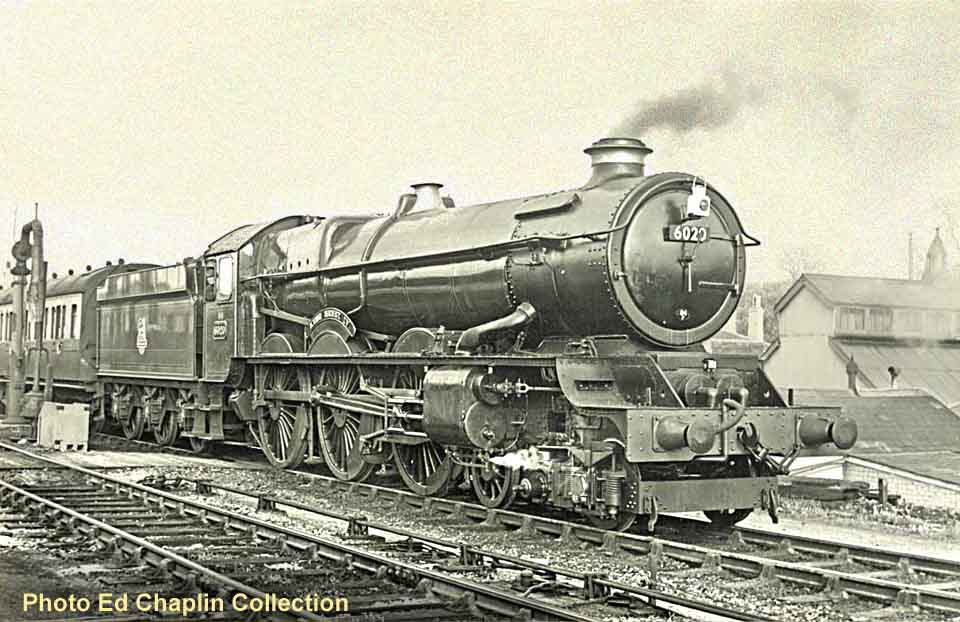
(Above) A superb study of an ex-works 'King' class 4-6-0 No 6020 'King Henry IV' on a running-in turn at Chippenham during April 1952. As mentioned earlier, 1952 was not a good year for the class as most were receiving attention of one sort or another; No 6020 entered Old Oak Common Shops for 4 weeks, Swindon Works twice for a duration of 9 weeks and Stafford Road Works on two occasions (another 9 weeks), representing a grand total of 22 weeks out of action, but one must bear in mind that by 1952 the 25 year-old 'King' class engines had been gainfully employed hauling heavy express trains throughout their working lives. Although the outside steam pipes are still original, a new superheated WB boiler has now been fitted. This was developed in March 1948 under the command of FW Hawksworth, then chief assistant to CB Collett before taking over as Chief Mechanical Engineer of the GWR when the 70-year old Collett retired in 1941. A sleeved single chimney is now fitted, having replaced the early capuchon type, with its integral lip; this would be replaced by the fabricated straight-sided double chimney that was added to 50% of the class and then in October 1957, the final development; a cast-iron elliptically shaped double version was utilised. I must admit that I was expecting the GWR Automatic Train Control to be visible on an image such as this one, given that the lower front of the locomotive is clearly visible, but the equipment is fitted below the cab floor on all 'King' class engines, usually before entering service. Power classification was set as Double Red (7P) by GWR, but BR thought otherwise and designated the engines as '8P' from 1 January 1951.
BR MODIFICATIONS
1. No new front frames were ever fitted.
2. Extended covers for inside valves from new.
3. Original outside steam pipes [ changed 1953].
4. WB boiler [04/52].
5. Single chimney still [ fabricated from 08/56].
6. Mechanical lubrication unit [now in initial position].
7. Leading bogie had welded repairs done later [02/56].
8. Cab roof vents not yet seen [inserted 1954].
9. BR early emblem added.
10. Raised step over the inside cylinders, below smokebox not yet seen [first stage only]. 
(Above) The driver of ex-GWR 'King' class 4-6-0 No 6020 'King Henry IV' awaits clear signals during the short trip from Paddington to Ranelagh Bridge service yard where the engine will be prepared for its return to Wolverhampton (Low Level) via the Birmingham Line in 1956. This side-on view allows the onlooker to pick out the position of the valve regulator control rod lever (between the first and second wheel splasher) which is hard to the left, showing the engine is in reverse gear; also the unusual position of the coupling rods provides a good view of the centre drive wheel balance weight, covering 7 spokes as opposed to 5 on the other two axles. Plus we have an excellent view of the cab roof vent, introduced in 1954 to give the footplate crew some cooling relief on the warmest days. The engine was a mainstay of Plymouth Laira (LA) depot for over 18 years, and during the British Railways era it became a constant Wolverhampton Stafford Road favourite right through to its early demise in July 1962. The 'Kings' limited shed allocations was due to their size and their restrictive, accumulated weights which were, in fact, six or seven tons over their original tonnage. We have another good view of the position of one of the welded strips applied to the upper section of the leading bogie, seen immediately above the 8 large bolt-heads, adjacent to the first axle laminated spring. Also we should note the initial position (in most cases) of the mechanical lubrication unit, between the first axle splasher and the outside steam pipe; this was moved to the front of the steam pipe following complaints by shed staff.
BR MODIFICATIONS.
1. New front frames, indicated by the large support washer on the frame end, not seen.
2. Extended covers for inside valves from new.
3. Modified outside steam pipes [1953).
4. WB boiler [04/52].
5. Fabricated sheet steel double chimney now fitted [from 04/56].
6. Mechanical lubrication unit [now in first position].
7. Leading bogie has welded repairs done [02/56].
8. Cab roof vents inserted [1954].
9. BR old emblem extant [new seen 10/1957].
10. Raised step over the inside cylinders, below smokebox, can be seen. 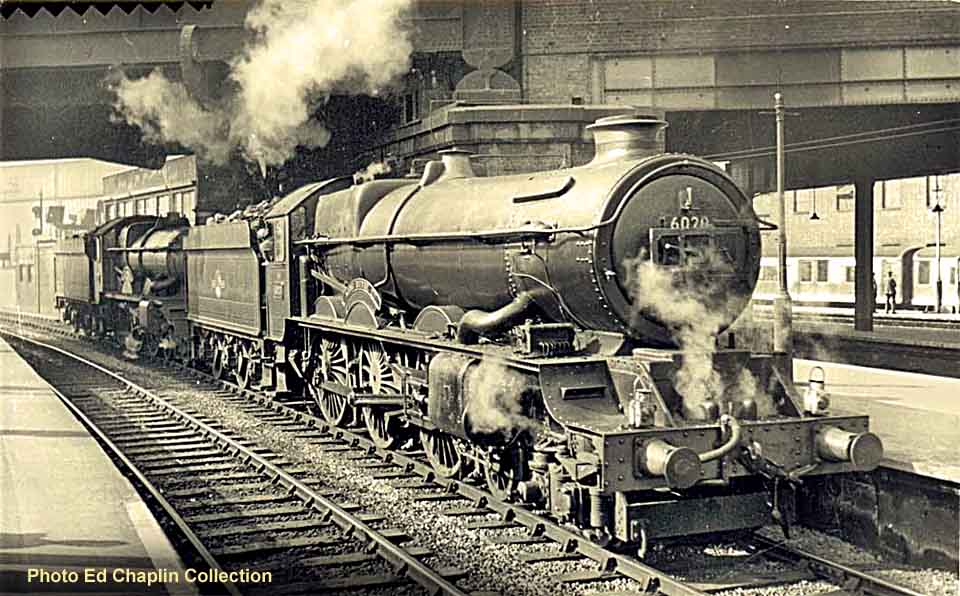
(Above) Two classic Collett 4-6-0 locomotives; ex-GWR 'King' class 4-6-0 No 6020 'King Henry IV' and an unidentified 'Castle' class engine make a very powerful pairing as they back away from platform 10 at London Paddington Station. This emotive image is dated October 1957, just after 6020's release from the Swindon 'Factory' where the engine received a Heavy General service and its last boiler change, plus an elliptically shaped double chimney was added to replace the fabricated, straight-sided type fitted earlier in August 1956; at the same time the mechanical lubrication unit was repositioned further forward on the offside of the boiler. The inside valve covers were extended from new and appear to be leaking some steam, but no support washers were ever seen on the frame ends, suggesting that the frames remained as original. Still extant are the original taper buffers secured by 4 bolts as opposed to the straight versions which were retained with 8 bolts. The new British Railways emblem can be seen on the tender, but this early sighting shows the 'lion' is facing to the right, which was allowed on the first BR emblem, but not so with the second version; this irregularity was frowned upon by the Heraldry Society and by late 1959 most right-facing emblems had been removed and locomotives were sporting the correct version (with the lion facing to the left). The engine spent many years at Plymouth Laira (LA) depot prior to it becoming a Stafford Road (84A) resident from early in 1949 until its demise in July 1962. No 6020 was built 22 months after No 6019 'King Henry V' and was the first of the class to have fitted independent springing on the drive axles as the first 20 built had balance beam suspension, which was designed to allow for faulty track and to compensate for that. It is quite evident from this angle that the wheel splashers did not align for a variety of reasons, including the space provided to fit the nameplate and room for fitting the gear operating lever mechanism behind the centre splasher. Also worthy of note is the position of the outside cylinders, which appeared to be further back than was necessary, but this was to shorten the outer connecting rods to then match the inner rods, which of course powered the first axle, thereby creating an operating balance that was critical to the fast running of these locomotives.
BR MODIFICATIONS
1. New front frames, indicated by the large support washer on the frame end, not seen.
2. Extended covers for inside valves applied from new.
3. Modified outside steam pipes [1953].
4. WB boiler [04/52].
5. Fabricated double chimney [08/56].
6. Mechanical lubrication unit [now in final position].
7. Leading bogie had welded repairs done [02/56].
8. Cab roof vents inserted [1954].
9. BR new emblem added [offside facing wrong way] 04/10/1957.
10. Raised step over the inside cylinders, below smokebox can be seen. 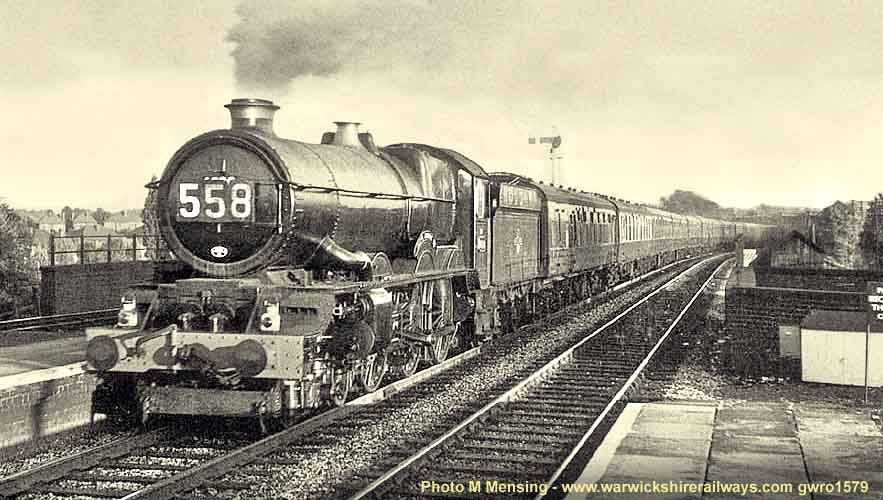
(Above) Just one week after returning from Swindon Works, this splendid vista of 'King' class 4-6-0 No 6020 'King Henry IV' striding majestically through Olton Station, six miles from Birmingham Snow Hill en route from London Paddington to Birkenhead in late August 1959, is captured on film by the redoubtable Michael Mensing. The engine resided at Wolverhampton Stafford Road from January 1949, one of six 'Kings' at (84A) in 1952 to become the subject of complaints from the general public raising strong concerns about the generally poor appearance of the locomotives used on the London services and the way in which they were driven. In 1952 the ailing class members were in poor condition, the rigours of the War period, compounded by a backlog of repairs and shortage of staff led to much disarray. Many engines were 25 years old and in need of maintenance, while records show that the period between August and October that year, no less than 23 'King' class members were either waiting to enter a workshop, or were actually under repair at one of the many Great Western Railway facilities. 1952 was also the year the Swindon Factory set out to repaint the whole class from the Caledonian Blue livery to the preferred BR Brunswick Green, a task which took the most part of two years to accomplish. 'King Henry IV' was built a little over 22 months after '6019' suggesting the decision to construct more class members was not straightforward and maybe based on financial constraints. The last 10 engines were slightly different to those already in service, having independently suspended road springs on the drive axles and extended covers for the inside valve assemblies.
BR MODIFICATIONS
1. New front frames, indicated by the large support washer on the frame end, were not fitted.
2. Extended covers for inside valves added from new [first of class].
3. Modified outside steam pipes [late 1954].
4. WB boiler [04/52].
5. Elliptically shaped cast-iron chimney fitted [10/57].
6. Mechanical lubrication unit [now in final position].
7. Leading bogie has welded repairs done [02/56].
8. Cab roof vents inserted [later in 1954].
9. BR new emblem on added 04/10/57.
10. Raised step over the inside cylinders, below smokebox, fitted.
6021 King Richard II 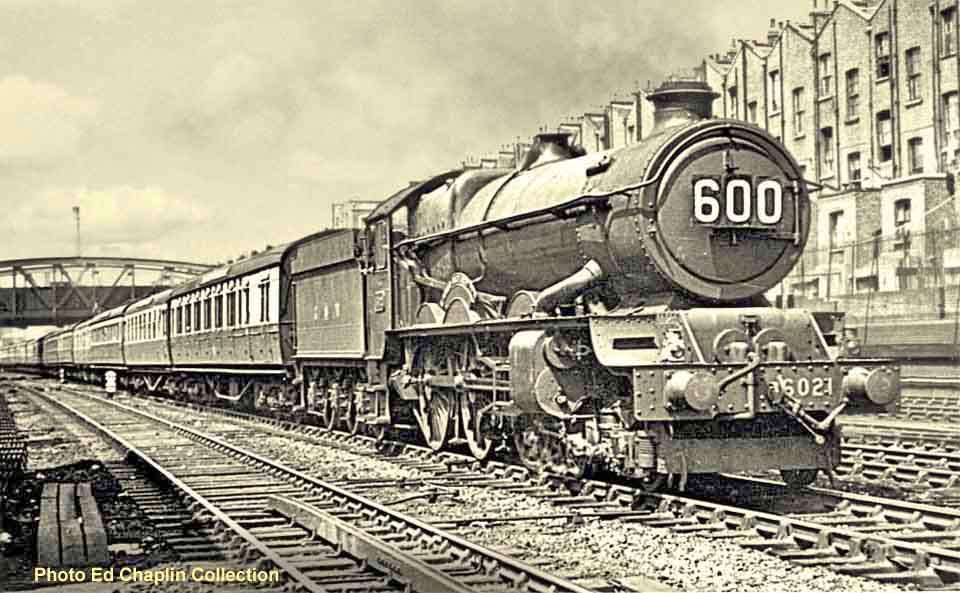
(Above) Ex-GWR 'King' class 4-6-0 No 6021 'King Richard II' eases an express from Plymouth past the tenement buildings at Westbourne Park on the approach to London Paddington Station in 1948. This early British Railways scene allows us to compare No 6021's present condition to its original construction in 1930; three minor alterations from new can be viewed at the front end; the top lamp iron was originally situated atop of the smokebox with an accompanying small footstep welded to the lower offside section of the smokebox door to help the fireman reach up there; the lamp iron was soon repositioned to the upper section of the smokebox door and the footstep dispensed with. The front angle sections of the frames were always clear from new until the lifting eyelets were added (ie holes were made) from around 1946, to provide a more secure method of raising the front of the locomotive instead of using the lower edge of the buffer beam, as previously. The step in front of the smokebox is the original design, but this was improved later with diamond treadplate to square off the edges and provide better footing for crew members; also the extended covers for the inside valve assemblies were fitted from new, being introduced into the construction programme for the final ten 'King' locomotives. By this time the train identification numbering scheme had been in use for some considerable time on the Western Region, however the fitting of the train reporting number frame on the smokebox door obscured the engines BR numberplate, whereas the old GWR-style stencilled number on the buffer beam helped enormously to distinguish one 'King' from another. We are just able to identify the lip on the single chimney from this low position, which was termed a capuchon and said to prevent a downdraught into the chimney in service.
BR MODIFICATIONS
1. New front frames, indicated by the large support washer on the frame end, not ever seen.
2. Extended covers for inside valves added from new.
3. Original outside steam pipes [modified 1953].
4. WA boiler [WB boiler 03/56].
5. Single chimney added with capuchon (lip).
6. Mechanical lubrication unit not fitted until 03/56.
7. Leading bogie had welded repairs done later.
8. Cab roof vents not inserted yet.
9. GW original emblem added [early BR emblem 1951].
10. Original step over the inside cylinders, below smokebox, fitted. 
(Above) Prior to its release back to Plymouth Laira (83D) depot, an ex-Works 'King' class 4-6-0 No 6021 'King Richard II' waits at Chippenham station during a running-in turn from Swindon under the supervision of an experienced crew. No details came with this image, but the fact that the leading bogie is modified coupled with the engine's single chimney indicates a day in March 1956, by which time the running department at 83D will be only too happy to have another member of its flock available again. Alas 1956 was a bad year for the Western Region involving the withdrawal of no fewer than twenty seven 'King' class members. The 'King crisis', as it was dubbed at the time, began when evidence of hairline cracks appeared in the leading bogie which ultimately led to the complete failure of the bogies on two locomotives. And to make matters a worse, the bogie issue coincided with a rising number of frame fractures, a direct result of the continual hard work carried out by the class over the previous 25 years; some fractures were repaired by welding, but almost half the class required further 'surgery' and a need for the replacement of the front half frames with some urgency. Although the modifications added extra weight to an already heavy machine, the 'Kings' continued to produce very good work throughout until 1962, at which point the demise of the class was swiftly reached due to their inability to be diverted to other routes, in the same way as the lighter 'Castle', 'Hall' and 'Grange' classes.
BR MODIFICATIONS
1. New front frames, indicated by the large support washer on the frame end, not ever seen.
2. Extended covers for inside valves from new.
3. Modified outside steam pipes [1953].
4. WB boiler [03/56].
5. Single chimney still [double version fitted 03/57].
6. Mechanical lubrication unit [now in final position].
7. Leading bogie has welded repairs done [03/56].
8. Cab roof vents inserted [1954].
9. BR early emblem added [new version 02/58].
10. Raised step over the inside cylinders, below smokebox. 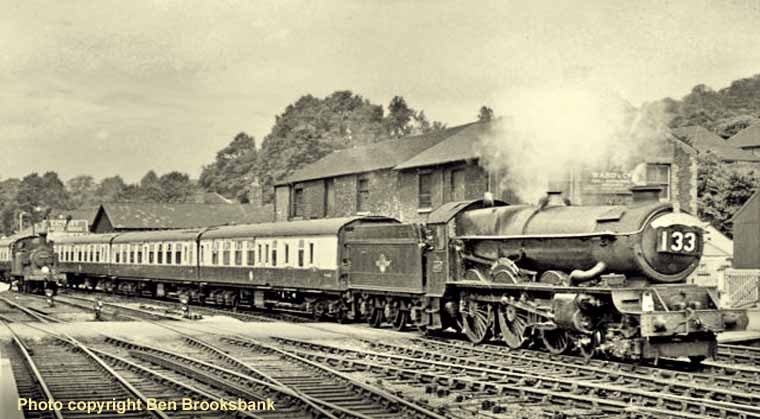
(Above) Highlight of the day at Exeter St David's Station was surely the arrival of the 'Cornish Riviera Express'. The early sighting of the impressive keystone-shaped headboard heralded the arrival of the Western Region's premier long-term train, hauled this day in July 1958 by ex-GWR 'King' class 4-6-0 No 6021 'King Richard II'. The front frames remained the same throughout its career and the extended valve covers, seen below the smokebox remained in their original form. Brunswick Green livery was seen from May 1953, nearly three years prior to the fitment of a WB boiler, in conjunction with the mechanical lubrication unit, supplying exact increments to the cylinders, valves and superheater, thereby absolving full responsibility of the driver. When the so-called 'King Crisis' was in its infancy, No 6021 was undergoing a Heavy General repair at Swindon and in due course received a modified leading bogie assembly. A small moment of fame was heaped on the loco during a running-in turn from Swindon in March 1958 when the 'King' was and commandeered to haul a 'dead' gas turbine loco, No 18100, having failed for a second consecutive day on the 'Bristolian'. Unusually for an Old Oak engine, the 'King' was observed with a Plymouth to Liverpool train on the West to North route in October 1960, completing the section between Bristol and Shrewsbury, then returning with a Liverpool to Bristol train. The engine entered Swindon Works as late as July 1961 for a Heavy General repair and emerged with a reconditioned boiler amongst other things, yet was withdrawn from service less than twelve months later, which surely represented an expensive loss.
BR MODIFICATIONS
1. New front frames not ever seen.
2. Extended covers for inside valves added from new.
3. Modified outside steam pipes [1953].
4. WB boiler [03/56].
5. Cast-iron double chimney now added [03/57].
6. Mechanical lubrication unit [now in first position].
7. Leading bogie has welded repairs done [02/56].
8. Cab roof vents inserted [1954].
9. BR new emblem added [10/57].
10. Raised step over the inside cylinders, below smokebox, now fitted.
6022 King Edward III 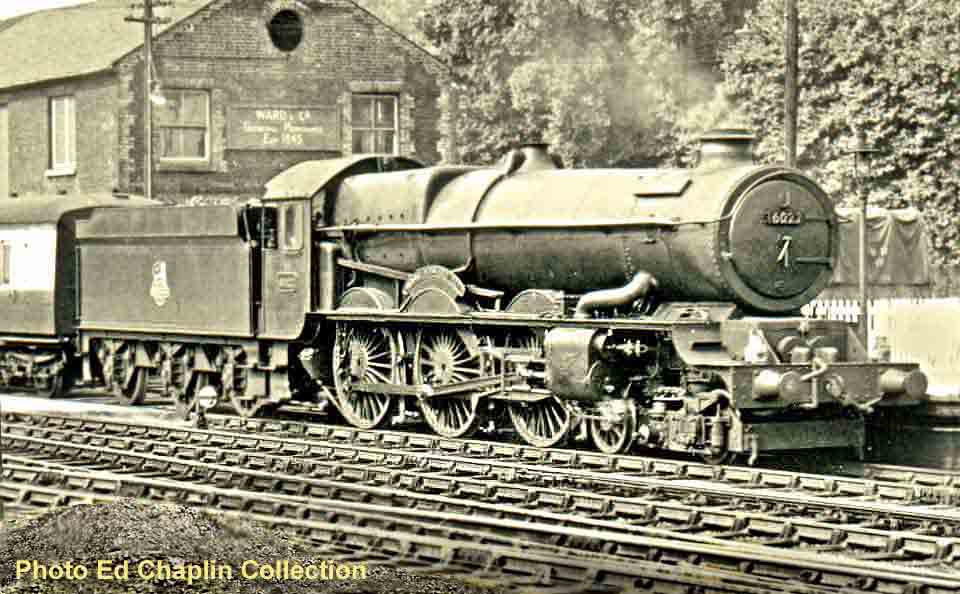
(Above) Ex-GWR 'King' class 4-6-0 No 6022 'King Edward III' arrives at Exeter St David's Station with a Paddington to Plymouth express; a roster the engine will have covered many times before during its 25 years of service based at Laira (LA and 83D). Although the records state that the WB boiler was fitted in June 1951, the engine received a 24-element superheated boiler at Swindon Works between January 1948 and early March. This development was cultivated by the successor to the Chief Mechanical Engineer CB Collett, namely FW Hawksworth, who was instructed to improve the steaming of the class to offset the poor quality of coal then available. At about the same time the running department was calling for longer trains to be supplied to facilitate a significant increase in the WR's passenger numbers. The much larger heating surface of the prototype reconditioned boiler was found to produce a 56% increase in the steaming capabilities of the engine than the previous type with 16 elements. Designated 'WB', thirty four new boilers were subsequently constructed between 1951 and 1955 to satisfy all of the class and by October 1956 all were suited. The engine's livery appears to be light blue in this shot, but as the locomotive is very grubby it defies accurate assessment, however I would settle for Brunswick Green, which puts the date at August 1953, even though the outside steam pipes are original at this time and would generally have been modified by now. Also of note is the original cab roof, which was not generally altered until 1954, with possibly just one exception.
BR MODIFICATIONS
1. New front frames, indicated by the large support washer on the frame end, not yet seen.
2. Extended covers for inside valves fitted from new.
3. Original outside steam pipes [modified late 1953].
4. WB boiler [03/48].
5. Fabricated double chimney [05/56].
6. Mechanical lubrication unit [now in first position].
7. Leading bogie had welded repairs done later [02/56].
8. Cab roof vents not yet seen [1954].
9. BR old emblem added [new from 11/1957].
10. Raised step over the inside cylinders, below smokebox not added.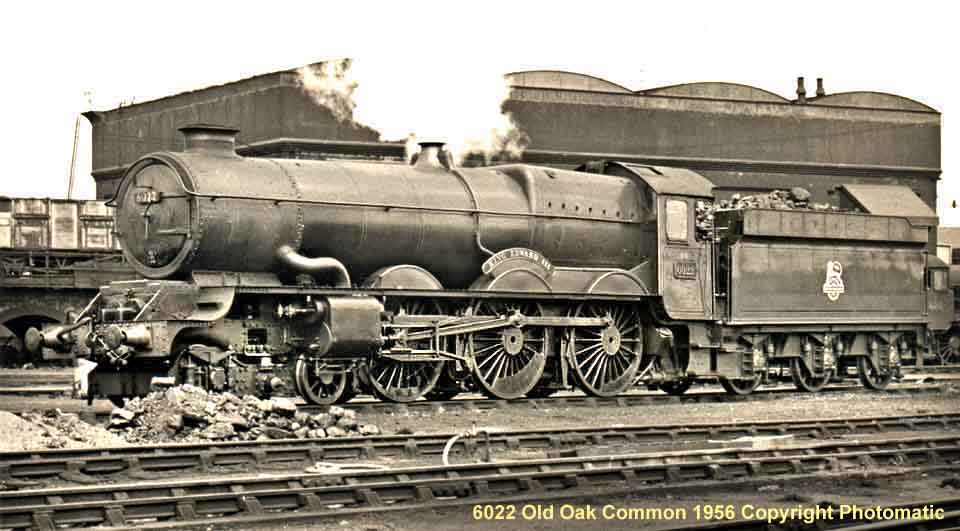
(Above) Ex-GWR 'King' class 4-6-0 No 6022 'King Edward III' waits in the sprawling yard at Old Oak Common (81A) depot during the summer of 1956, turned and coaled in readiness for its next duty (facing West). The engine appears in good order and so it should, as many repairs have been completed in recent visits to Swindon Works, including front half-frames (November 1954), reconditioned leading bogie and a fabricated double chimney, completed just two months prior to this image. From the point of entry to Swindon Works in July 1954, the locomotive was under repair for a total of 9 months during the next two years and this included visits to Taunton Repair Shops, three to Laira and three more to Swindon. All of the class members were allocated to Old Oak Common (PDN and 81A) depot at some stage in their careers, with some spending the majority of their service days working from the Harlesden depot; however Nos 6006, 6008 and 6020 were only resident at the shed during the 1930s for short spells, and never during the BR era. It is not always easy to distinguish, but the engine has the early fabricated version of the double chimney with straight sides, basically an interim measure before the cast-iron type was readily available, initially from November 1957. When a WB boiler was fitted in March 1948, the engine was still in its original GWR livery, as applied to all class members, and it remained this way for nearly 2 more years until the Caledonian Blue finish was applied in December 1949. As can be seen there are no mechanical lubrication unit fitted to this side, only a small relay unit to cater for the nearside cylinders.
BR MODIFICATIONS
1. New front frames, indicated by the large support washer on the frame end, now seen.
2. Extended covers for inside valves fitted from new.
3. Modified outside steam pipes [1953].
4. WB boiler [03/48].
5. Fabricated double chimney [05/56].
6. Mechanical lubrication unit [now in final position].
7. Leading bogie had welded repairs done [02/56].
8. Cab roof vents inserted [1954].
9. BR first emblem added [new from 11/1957].
10. Raised step over the inside cylinders, below smokebox can be seen.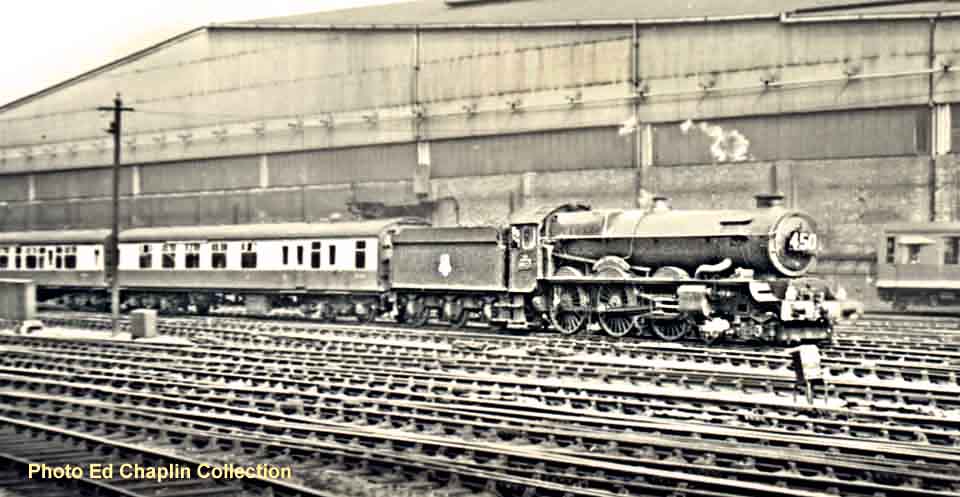
(Above) During the summer of 1957, ex-GWR 'King' class 4-6-0 No 6022 'King Edward III' of Old Oak Common arrives at Paddington with an early morning train from Weston-super-Mare; the ensemble is dwarfed by the mammoth goods depot which dominates the scene. The front half-frames had to be replaced in late 1954, due to fracture, a long pains-taking task that required all components to be removed enabling the frames to be cut through halfway between the first and second axles. No 6022 was the second engine to be found with this problem and I do think that the failure of the frames related to high mileage locomotives; the first 'King' No 6013 to be treated had recorded the highest of the class, but next in line was No 6005 which returned the second lowest figure, although it was, of course three years older than 'King Edward III'. Four engines were discovered with a defective frame in 1954, another 4 in the following year and a further 3 engines in 1956 - the year of the 'King Crisis'. As a result, all but 3 'Kings' were removed from service from January. The prototype WB boiler was fitted to No 6022 as seen from March 1948, with the engine still in Great Western lined green livery and most likely before a smokebox numberplate was added, as British Railways was still very much in its infancy. The leading bogie was a complicated and vital part of a locomotive, enabling the engine to negotiate curves in a safe and stable way and the more weight added to the 'King' meant the harder the bogie had to work, causing more stress cracking of the side plates. Withdrawal came in early September 1962 from Stafford Road depot and was sold to Cox & Danks of Langley Green, West Midlands.
BR MODIFICATIONS
1. New front frames, indicated by the large support washer on the frame end, now seen.
2. Extended covers for inside valves fitted from new.
3. Modified outside steam pipes [1953].
4. WB boiler [03/48].
5. Fabricated double chimney [05/56].
6. Mechanical lubrication unit [now in final position].
7. Leading bogie had welded repairs done [02/56].
8. Cab roof vents inserted [1954].
9. BR first emblem added [new from 11/1957].
10. Raised step over the inside cylinders, below smokebox can be seen.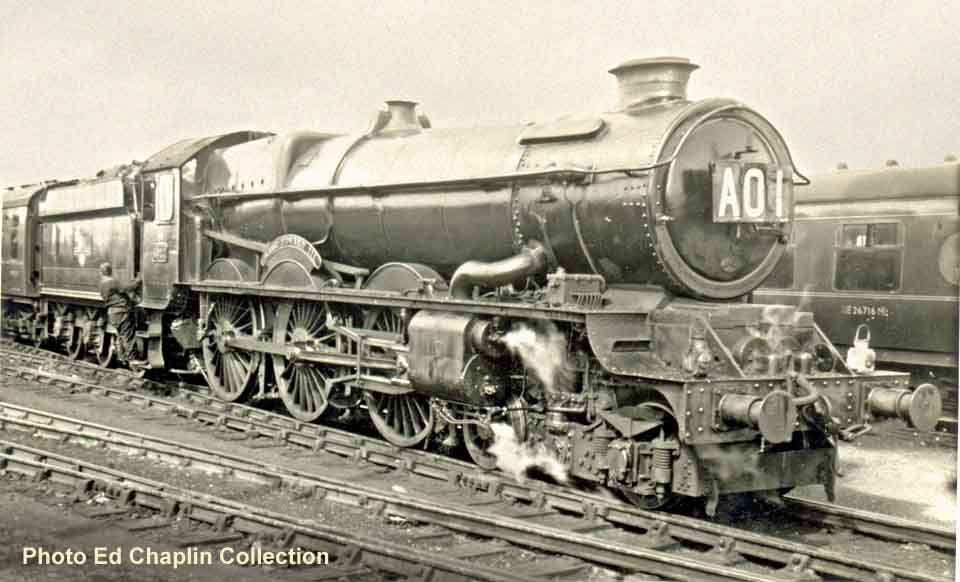
(Above) During the rather wet summer of 1960, ex-GWR 'King' class 4-6-0 No 6022 'King Edward III' is captured at Wolverhampton's Cannock Road sidings, as the crew prepare the engine for its imminent journey to London, as indicated by the 'A01' headcoding. Selected for the fitment of a new prototype boiler, 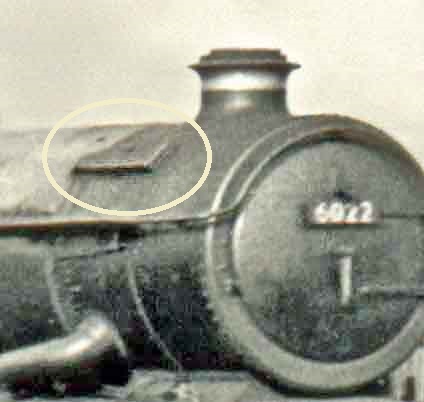 devised by FW Hawksworth, the engine was seen from early 1948 with a slightly different shaped cover for the superheater pipework (see insert right). The subsequent success of the new boiler prompted the construction of a further 34 to accommodate the whole of the class and still have spare units to hand as required by Swindon. Extended valve covers for the inside cylinders were fitted from new in June 1930 and long remained so, while the engine was an early recipient of new half-frames, which had to be welded to the rear sections; this involved a complete strip down enabling access to cut the frame at a point between the second and third driving axles. Also a couple of months before that work, the unlucky locomotive suffered a catastrophic broken drive axle, seemingly caused by overheated bearings and quite possibly the linear stresses from this failure had an adverse affect on the chassis frame. From this low angle the elliptically-shaped cast-iron double chimney (fitted November 1957) appears to be taller than usually seen on the 'King' class, but this is surely an optical illusion. The shed code can be made out as Wolverhampton Stafford Road (84A), one of eleven class members resident there at that time. However the engine was a favourite at Laira (83D) depot for just over 25 years before making its mark at Old Oak Common (81A) for near on 4 years; it finally settled in the West Midlands from June 1959 until its withdrawal in September 1962.
devised by FW Hawksworth, the engine was seen from early 1948 with a slightly different shaped cover for the superheater pipework (see insert right). The subsequent success of the new boiler prompted the construction of a further 34 to accommodate the whole of the class and still have spare units to hand as required by Swindon. Extended valve covers for the inside cylinders were fitted from new in June 1930 and long remained so, while the engine was an early recipient of new half-frames, which had to be welded to the rear sections; this involved a complete strip down enabling access to cut the frame at a point between the second and third driving axles. Also a couple of months before that work, the unlucky locomotive suffered a catastrophic broken drive axle, seemingly caused by overheated bearings and quite possibly the linear stresses from this failure had an adverse affect on the chassis frame. From this low angle the elliptically-shaped cast-iron double chimney (fitted November 1957) appears to be taller than usually seen on the 'King' class, but this is surely an optical illusion. The shed code can be made out as Wolverhampton Stafford Road (84A), one of eleven class members resident there at that time. However the engine was a favourite at Laira (83D) depot for just over 25 years before making its mark at Old Oak Common (81A) for near on 4 years; it finally settled in the West Midlands from June 1959 until its withdrawal in September 1962.
BR MODIFICATIONS
1. New front frames, indicated by the large support washer on the frame end, now seen [added 11/54].
2. Extended covers for inside valves from new.
3. Modified outside steam pipes [changed 1953].
4. WB boiler was the first fitted [03/48].
5. Double chimney now [first type 05/56].
6. Mechanical lubrication unit [now in final position].
7. Leading bogie shows welded repairs done [01/56].
8. Cab roof vents inserted (1954).
9. BR new emblem added [11/57].
10. Raised step over the inside cylinders, below smokebox now seen.
6023 King Edward ll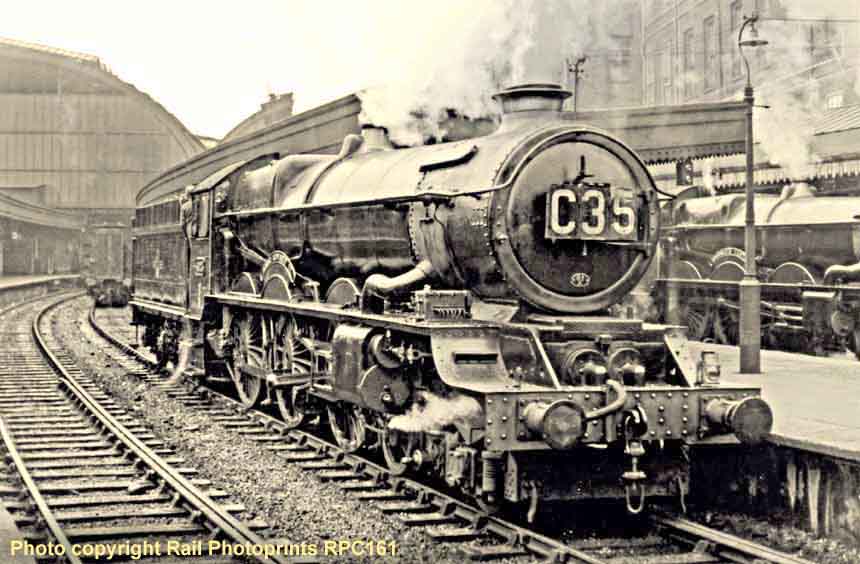
(Above) Despite the recent lack of opportunities due to the insurgence of the Western Region's new diesel-hydraulics, ex-GWR 'King' class 4-6-0 No 6023 'King Edward II' backs down onto its train at platform 3, to form the 11.40 weekday Paddington to Penzance passenger service, as identified by the 'C35' headcode. The WR's new headcodes were introduced in 1960, using a letter in the Reporting Number to comply with the new system of train reprting numbers adopted by BR for use nationwide. From the summer of 1959, the Old Oak Common 'Kings' were far less likely to be rostered to the West Country and more commonly to be found on the Birmingham expresses, augmenting the additional engines already received by Stafford Road depot. When CB Collett was given the task of designing the 'King' class locomotives, he was in direct competition with Henry Fowler (Derby, LMS), Nigel Gresley (Doncaster, LNER) and Richard Maunsell (Eastleigh, SR). At the time, the GWR was keen to build a larger locomotive that would enable the company to reclaim the lofty status it previously held of having the most powerful steam locomotive in the land. Collett's manager, Sir Felix Pole, was adamant that the mantle should be recovered from the Southern Region, which had succeeded in taking top-spot with their recently built 'Lord Nelson' class 4-6-0s. Collett duly obliged; the estimated tractive effort of his proposed new engine was to blow the competition out of the water! Soon after this photograph was taken, No 6023 would shortly be off to Cardiff Canton (88A) depot to upstage the WR 'Britannia' Pacifics on the 'Red Dragon' and 'Capitals United Express' passenger services. However, in November 1959 it was reported that the Old Oak Common's steeds were not up to the task being asked of them and the diagram of early morning newspaper train down to Cardiff - returning with the 'Capitals United' - had to be shelved until the selected 'Kings' had been through Swindon Works for a Heavy General or Intermediate repair. This particular 'King' had recently done just that and received a complete overhaul, including reconditioned boiler and tender.
BR MODIFICATIONS
1. New front frames, indicated by the large support washer on the frame end, not seen.
2. Extended covers for inside valves from new.
3. Modified outside steam pipes [1953].
4. WB boiler [03/52].
5. Cast-iron double chimney [fitted 06/57].
6. Mechanical lubrication unit [now in final position].
7. Leading bogie had welded repairs done [02/56].
8. Cab roof vents inserted [1954].
9. BR new emblem added 06/57.
10. Raised step now fitted over the inside cylinders, below smokebox. 
(Above) Having been well prepared for 'Dragon' duty, a resplendent ex-GWR 'King' class 4-6-0 No 6023 'King Edward II' waits at Cardiff Canton depot in July 1961. The 'King' will haul the 'Red Dragon' restaurant car express from Cardiff General Station with arrival due into London Paddington around lunch-time. The train was titled in June 1950, a splendid name set out on a crescent-shaped cast board, with a rampant red lion representing the spirit of Wales. This colourRail shot highlights the brass and copper fittings used on the majestic 'King' class, including the brass end-caps for the front wheel bearings on the leading bogie, which stand out vividly as does the recent paint on buffer beam, however old paintwork remains on the later type buffers, suggesting a visit to Cardiff shops for some remedial work. The now-preserved locomotive was a long-term resident of Newton Abbot depot (NA) with Nos 6018 and 6024 being the only other 'Kings' to have served any length of time there, all before 1949; this explains why their final mileages were considerably lower than the rest of the class. Beginning in October 1960, Cardiff Canton was allocated six 'Kings', and in spite of a raft of 'Britannias' already in residence there, the 'Kings' managed to take the mantle from the much younger Pacifics for the Cardiff-London restaurant expresses, leaving the 4-6-2s to turn their usefulness towards the West to North trains, although they could still be seen on 'Red Dragon' duty when recently ex-works. Following the transfer of the 'Britannias' to the LMR in September 1961, two more 'Kings were allocated to Cardiff, bringing the stock up to 8 engines. In October 1961, No 6023 was obliged to use the route via Gloucester due to a fire on board a DMU in the Severn Tunnel, quite possibly the only occasion a 'King' class was seen in that area. Withdrawal came in June 1962 from Cardiff and the prized possession was sold to TW Ward of Briton Ferry, but very soon it was resold to Woodham Brothers of Barry, from where the famous engine was bought for restoration.
BR MODIFICATIONS
1. New front frames, indicated by the large support washer on the frame end, not seen.
2. Extended covers for inside valves from new.
3. Modified outside steam pipes [1953].
4. WB boiler [03/52].
5. Cast-iron double chimney [fitted 06/57].
6. Mechanical lubrication unit [now in final position].
7. Leading bogie had welded repairs done [02/56].
8. Cab roof vents inserted [1954].
9. BR new emblem added 06/57.
10. Raised step fitted over the inside cylinders, below smokebox.
6024 King Edward I 
(Above) After bringing in the ex-Weston-super-Mare, early morning express from Bristol Temple Meads in the summer of 1959, ex-GWR 'King' class 4-6-0 No 6024 'King Edward I' awaits clearance from platform 10 at Paddington before reversing out to Ranelagh Bridge for turning. Today the evocative Train Reporting number '007' conveys an instant association with James Bond, but back in 1959 it will have had little significance as the first Bond film 'Doctor No' wasn't released until 1962. No 6024 was allocated to Newton Abbot for fifteen years, one of only four 'Kings' to work from there for any length of time; it also saw service at Laira (LA and 83D), Old Oak Common (81A) and in September 1961 it joined seven other class members at Cardiff Canton (88A) for employment on the Cardiff-London expresses, but not before authorisation was given for regular 'King' haulage on the scheduled 'Red Dragon' and 'Capitals United Express' restaurant trains; authorisation was finally granted following clearance tests carried out in the Severn Tunnel and at Newport Station.The external diameter of the Kings' WB boiler across the front end was slightly more than 5'6" which was just about 4" larger than the 'Castle' class engines, and being 1ft 2in longer it gave the 'Kings' a more impressive, bolder look than Collett's earlier design. In September 1957, the unique slotted bogie found its way onto No 6024, having taken possession of it from No 6000, but the bogie was soon given up to No 6005; this shows that the 'King' bogies were repaired as a separate job, hence the units were frequently transferred from one engine to another, more especially in the latter years of the class to guard against further failures which were rife from 1950 onwards. Six other engines were noted as being paired with the 1927-built slotted bogie: Nos 6004, 6014, 6018, 6021, 6023 and 6028...No 6021 being the last in line to receive the unit.
BR MODIFICATIONS
1. New front frames, indicated by the large support washer on the frame end, not seen.
2. Extended covers for inside valves from new.
3. Modified outside steam pipes [1953].
4. WB boiler [09/53]
5. Cast-iron double chimney [fitted 03/57].
6. Mechanical lubrication unit [now in final position].
7. Leading bogie had welded repairs done [02/56].
8. Cab roof vents inserted [1954].
9. BR new emblem added 03/57 [facing wrong way].
10. Raised step over the inside cylinders, below smokebox.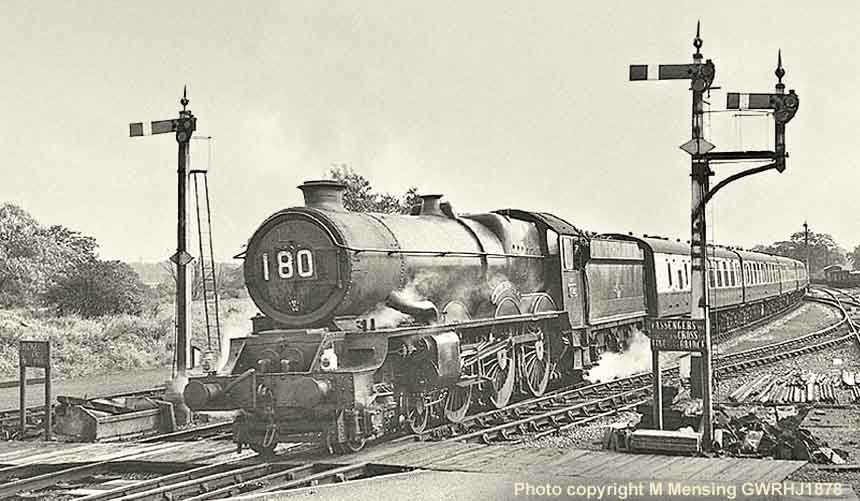
(Above) After surmounting the stiff climb from Warwick, the now preserved 'King' class 4-6-0 No 6024 'King Edward I' takes a breather from its exertions on Hatton Bank, a five-mile long slog that tested the ability of any locomotive to the full, none more so than the majestic 'Kings' which regularly hauled the heaviest expresses of the day. An accurate date of 23rd September 1957 is provided by the photographer, Michael Mensing, which, with the aid of service records, indicates that the latest version of the double chimney was fitted in March 1957 along with the new style emblem on the tender; No 6024 was in fact the first of the class to receive the new logo. Having spent many years in the south west based at Plymouth Laira and Newton Abbot depots, 6024 was allocated to Old Oak Common (81A) before ending its days at Cardiff Canton (88A) to plug the gap left by the transfer of the 'Britannia' Pacifics to the LMR. However, from 1959 a new fleet of diesel-hydraulics was taking over the 'Kings' stronghold on the London to West of England expresses, and many of the class sought alternative employment, some finding themselves on menial work whilst others made headway into South Wales where they took turns with the Canton 'Britannias' to haul the 'Capitals United Express', a new titled train so named in 1951 because Cardiff had just been nominated as the capital city of Wales. In November 1959, No 6024 was one of the Old Oak 'Kings' utilised on a new diagram taking the early morning Paddington to Cardiff newspaper train, but it proved a major disappointment, losing 25 minutes on the down run and 43 on its return to London with an express passenger. In this photograph, train '180' is nominated as the 09.10 Paddington to Birkenhead, which required a minimum of two locomotive changes, firstly 'King Edward I' will come off at Wolverhampton and a second change will occur at Chester. Items to be picked out on the locomotive are the raised step below the smokebox and the 'SC' plate beneath the shed code denoting a 'self cleaning' firebox complementing the double chimney.
BR MODIFICATIONS
1. New front frames, indicated by the large support washer on the frame end, not ever seen.
2. Extended covers for inside valves from new.
3. Modified outside steam pipes [1953].
4. WB boiler [09/53].
5. Cast-iron double chimney [fitted 03/57].
6. Mechanical lubrication unit [now in final position].
7. Leading bogie had welded repairs done [02/56].
8. Cab roof vents inserted [1954].
9. BR new emblem added [03/57].
10. Raised step over the inside cylinders, below smokebox now added.
6025 King Henry III
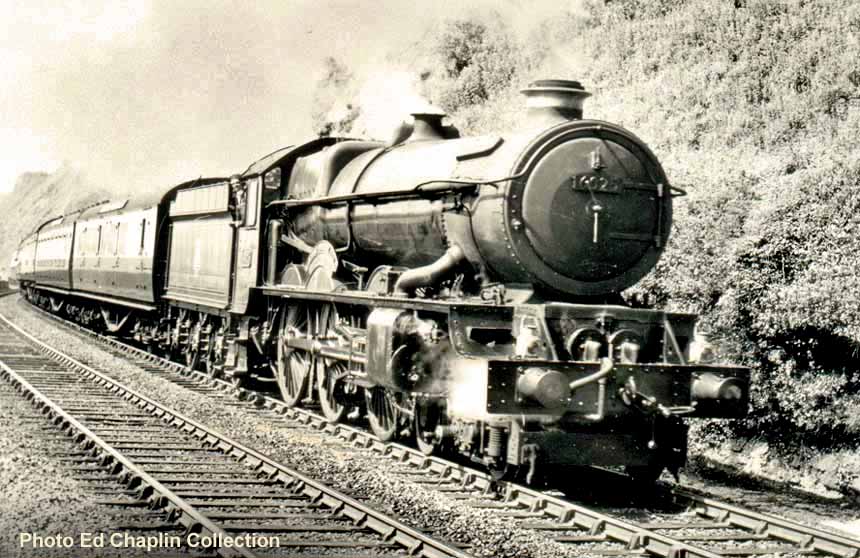
(Above) Ex-GWR 'King' class 4-6-0 No 6025 King Henry III heads a London express along the south Devon coastline at Teignmouth. The total mileage for this engine was a very creditable 1,836,713 which compared favourably with the highest recorded mileage of 1,950,462 attained by No 6013; this is particularly notable when you take into account that No 6025 served two years less in traffic. The engine operated mainly from Old Oak Common (PDN and 81A) interrupted by an 11-year period spent at Plymouth Laira (83D). Generally speaking, it is most unusual to find anything out of place or damaged on any of the 'King' engines, suggesting that both the GWR and BR Western Region had a policy of maintaining the lofty status of their Class 8P express passenger fleet, therefore immediate attention would normally be given to any peripheral damage. However, as can be seen in this photo the handrail running along the boiler has been pulled away from the exhaust ejector on the smokebox side creating a slightly different appearance. The engine's livery of light blue can be confirmed by the black/whitle lining on the tender as opposed to the black/orange that accompanied the engine's later Brunswick Green applied from January 1954. The single chimney remained for almost five more years, being one of 15 'Kings' not fitted with the fabricated form of double chimney, however No 6025 was benefiting from the WB boiler with its improved steaming capabilities. It should also be noted that the first stage of the diamond treadplate is fitted over the inside cylinders in front of the smokebox to aid the crew's safety when removing ash deposits.
BR MODIFICATIONS
1. New front frames, indicated by the large support washer on the frame end, not seen.
2. Extended covers for inside valves from new.
3. Original outside steam pipes [modified 1953].
4. WB boiler [03/52].
5. Original single chimney [double chimney fitted 03/57].
6. Mechanical lubrication unit [now in first position].
7. Leading bogie had welded repairs done later [02/56].
8. Cab roof vents inserted later [1954].
9. BR early emblem added [new emblem added 03/57].
10. Raised step over the inside cylinders, below smokebox still to be added. 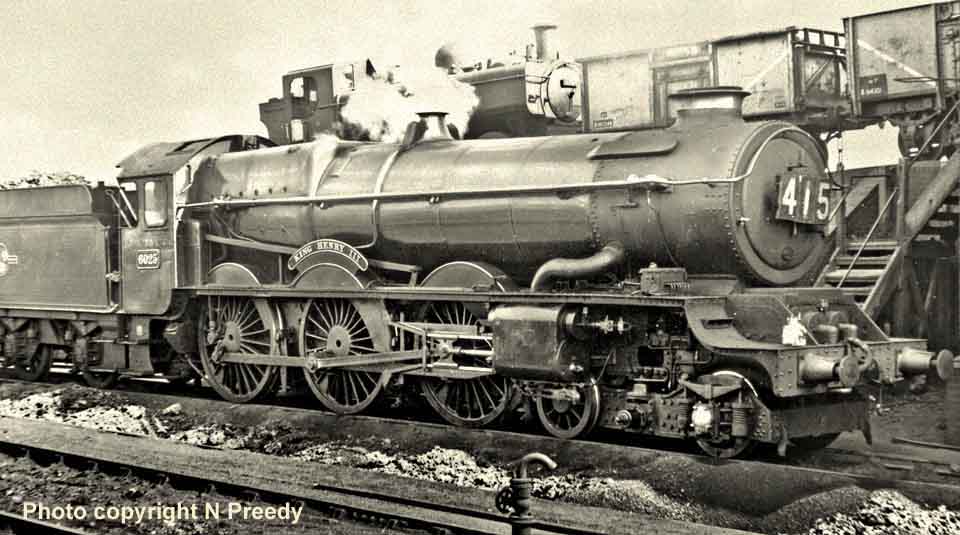
(Above) During the late summer of 1958, ex-GWR 'King' class 4-6-0 No 6025 'King Henry III' stands alongside the coaling stage at the Plymouth Laira (83D) while a local 'matchbox' tank engine shunts more coal supplies up the ramp. No 6025 had recently returned from Swindon Works where the engine spent the 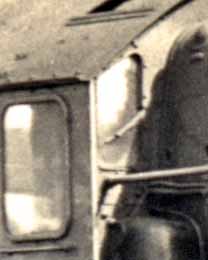 best part of three months under repair, including another change of tender; this was normal practice especially in the latter years, as running sheds often exchanged a defective unit for a good spare, then attach the faulty tender to an engine heading off to Swindon for maintenance. Completed in July 1930, the 'King' was allocated to Old Oak Common (PDN) for 18 years, before spending 11 years working from Plymouth Laira (83D), but then returning to Old Oak for its final 3 years of service. The Train
best part of three months under repair, including another change of tender; this was normal practice especially in the latter years, as running sheds often exchanged a defective unit for a good spare, then attach the faulty tender to an engine heading off to Swindon for maintenance. Completed in July 1930, the 'King' was allocated to Old Oak Common (PDN) for 18 years, before spending 11 years working from Plymouth Laira (83D), but then returning to Old Oak for its final 3 years of service. The Train  Reporting Number '415' refers to a Falmouth and Newquay express from Paddington, which the engine had hauled as far as Plymouth North Road station; the heavy 'King' class locomotives were banned from traversing the Royal Albert Bridge at Saltash due to weight restrictions. This lovely image shows an unusually clear view of the driver's front window wiper (inset left) and the operating rodding for the steam sanders over the first drive axle (inset right). Also the engine appears to have had the outer cylinder assembly changed, as it looks remarkably clean and unblemished. Picture is dated September 1958, and affords us a detailed view of the leading bogie assembly.
Reporting Number '415' refers to a Falmouth and Newquay express from Paddington, which the engine had hauled as far as Plymouth North Road station; the heavy 'King' class locomotives were banned from traversing the Royal Albert Bridge at Saltash due to weight restrictions. This lovely image shows an unusually clear view of the driver's front window wiper (inset left) and the operating rodding for the steam sanders over the first drive axle (inset right). Also the engine appears to have had the outer cylinder assembly changed, as it looks remarkably clean and unblemished. Picture is dated September 1958, and affords us a detailed view of the leading bogie assembly.
BR MODIFICATIONS
1. New front frames, indicated by the large support washer on the frame end, not ever seen.
2. Extended covers for inside valves from new.
3. Modified outside steam pipes [1953].
4. WB boiler [03/52].
5. Cast-iron double chimney [fitted 03/57].
6. Mechanical lubrication unit [now in final position].
7. Leading bogie has welded repairs done [02/56].
8. Cab roof vents inserted [1954].
9. BR new emblem added 03/57 [facing wrong way].
10. Raised step over the inside cylinders, below smokebox [added 03/57].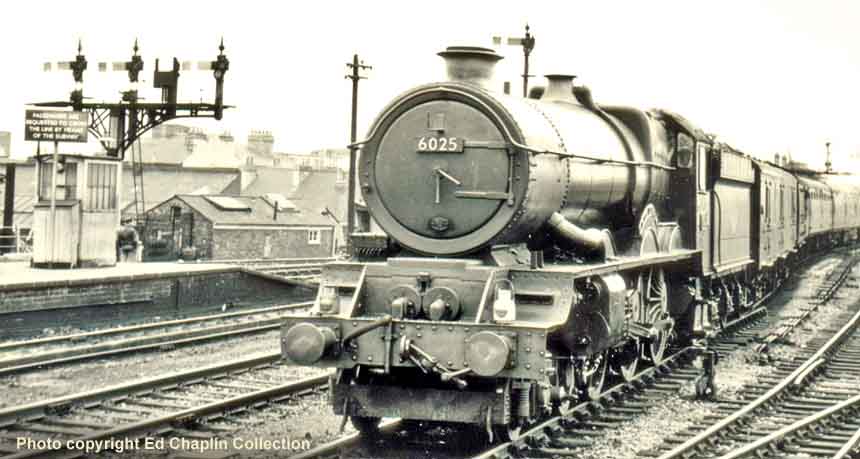
(Above) Ex-GWR 'King' class 4-6-0 No 6025 'King Henry III' enters the up relief platform at Reading General station with a London train. This Old Oak Common stalwart was one of 4 'Kings' seen sporting four different liveries; beginning with the GWR's Middle-Chrome Green, followed by the short-lived dark ultramarine blue, but this soon gave way to the lighter Caledonian Blue. Then from 1954 onwards, a Brunswick Green with orange/black lining was the final choice of livery decided upon by the British Railways Executive Committee for its express passenger engines. The rather damp weather has taken the shine off the engine's paintwork, but the loco is now in its final condition, including the replacement of the earlier tapered buffers by the heavier straight types, secured by 8 bolts. From this angle the front axle wheel splasher is almost out of view, accentuating its recessed position compared to the second and third axles. The engine spent its first 18 years based at Old Oak Common before moving to Laira (83D) in August 1950. Then in March 1959 it returned to 81A from where it was withdrawn in December 1962, one of four 'Kings' to survive into the last month of the year. It is recorded that the engine was still finished in blue livery when it received its first WB boiler and remained so for close on two years. Also No 6025 became the penultimate 'King' to benefit from a Heavy General repair at Swindon Works, receiving a fresh boiler and tender before returning to Old Oak Common on 9th February 1962 - only to find itself being put into store just six months later! Disposal came at Swindon, one of ten class members to be dismantled there, all of which had the distinction of being designed, constructed, repaired, tested and disposed of at Swindon, though never actually allocated there.
BR MODIFICATIONS
1. New front frames, indicated by the large support washer on the frame end, not ever seen.
2. Extended covers for inside valves from new.
3. Modified outside steam pipes [1953].
4. WB boiler [03/52].
5. Cast-iron double chimney [fitted 03/57].
6. Mechanical lubrication unit [now in final position].
7. Leading bogie has had welded repairs done [02/56].
8. Cab roof vents inserted [1954].
9. BR new emblem added 03/57.
10. Raised step over the inside cylinders, below smokebox [added 03/57].
6026 King John 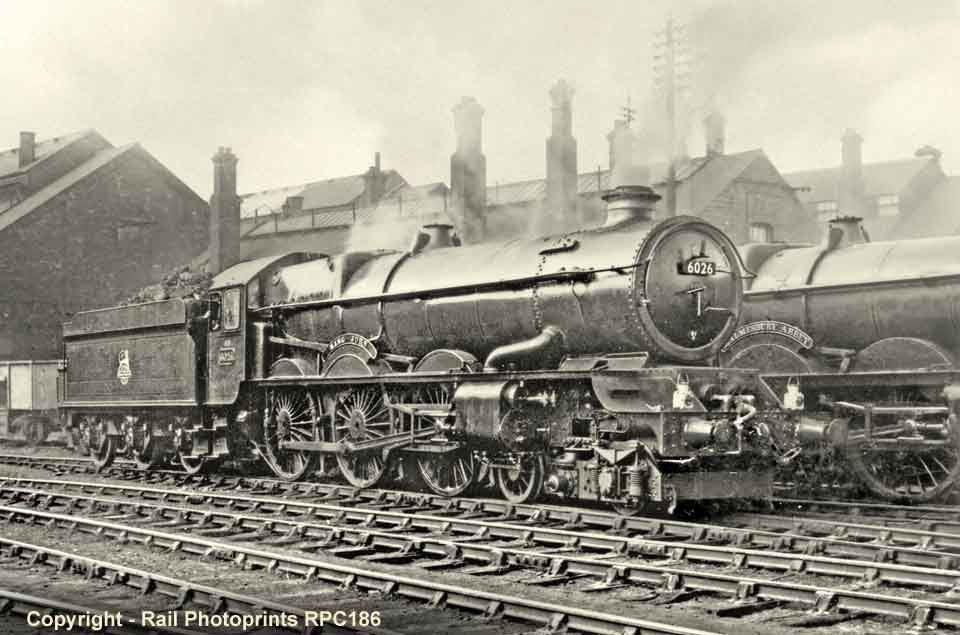
(Above) A fittingly pristine 'King' class 4-6-0 No 6026 'King John' awaits its next express passenger working at Swindon shed in June 1952. The image reflects the engine's early British Railways Brunswick Green livery, which replaced the earlier Caledonian Blue finish, plus the single chimney has a capuchon lip (half-ring) to prevent downward draughts when the locomotive was in motion. The engine's original outside steam pipe design will soon be upgraded to an improved dimension and shape to counteract the flexing movement of the cylinder assembly relative to the boiler which caused many failures in service. The steam exhaust pipe is not actually visible; it is covered by a protective casing to shield crews and fitters from burn injury. Seen immediately above the outside steam pipe connection to the smokebox is a small tapered cover for the early type superheater of the WA boiler; No 6026 had to wait another four years before benefitting from FW Hawksworth's improved WB boiler. The extended covers for the inside valves were added from new in July 1930, but the engine was seen in service without the offside cover in 1957. Following withdrawal of 6026 from Old Oak Common the unique and very singular nameplates were removed for safekeeping and sold to separate bidders; No 6026 was dismantled at Swindon Works, one of ten 'Kings' to be cut up at the 'Factory'.
BR MODIFICATIONS
1. New front frames, indicated by the large support washer on the frame end, not ever seen.
2. Extended covers for inside valves, were fitted from new.
3. Original outside steam pipes [modified late 1953].
4. WB boiler [10/56].
5. Single chimney still [double chimney fitted 03/58].
6. Mechanical lubrication unit not yet seen.
7. Leading bogie had welded repairs done later [02/56].
8. Cab roof vents not yet appeared [inserted 1954].
9. BR early emblem added [new 03/58].
10. Raised step over the inside cylinders, below smokebox not yet seen [first stage only].
(Above) As it will have done countless times before, thirty year-old 'King' class 4-6-0 No 6026 'King John' awaits its next duty at Plymouth North Road Station. Once a long-term resident of Plymouth Laira depot, No 6026 had moved to Old Oak Common when this photo was taken therefore it could still be seen on the same running diagrams. T
he origin of the 'King' class locomotives came about when the marvellous engineer, GJ Churchward, planned to construct an enlarged version of the 'Star' 4-6-0 locomotive using the same Standard No 7 boiler that he had designed for his 1919-built '4700' class 2-8-0s, but he was prevented from doing so by their resultant axle-weights. CB Collett continued the idea for his proposed 'Castle' class 4-6-0, but was likewise thwarted by the ongoing weight problem, therefore a new Standard No 8 boiler was constructed for his 'Castle' class. Some three years later a Bridge Committee was formulated to upgrade just 4 bridges that were the weak links in the route to the West Country and Collett was instructed to design a larger engine to a new limitation of 22.5 tons for which he produced an enlarged boiler that was tapered and domeless and nominated as Standard No 12, coded 'WA'. With an enlarged smokebox and a 16 ft long boiler, the wheelbase dimensions (of the current 'Castle') had to be extended, while the newly-designed boiler was set to operate at 250lbs. However, further consternation for Collett came about because his proposed tractive effort of 39,100lbs fell a little short of the expectations of his manager, Sir Felix Pole, and he was obliged to stage a rethink, decreasing the dimensions of the drive wheels by two inches to produce an estimated effort of 40,285lbs. The locomotive that eventually evolved from Collett's efforts was the marvellous, majestic 'King' class, which was released to the general public with much pomp and ceremony being drummed up by the Great Western Railway's publicity department.
BR MODIFICATIONS
1. New front frames, indicated by the large support washer on the frame end, not ever seen.
2. Extended covers for inside valves from new.
3. Modified outside steam pipes [1953].
4. WB boiler [10/56].
5. Cast-iron double chimney [fitted 03/58].
6. Mechanical lubrication unit [now in final position].
7. Leading bogie had welded repairs done [02/56].
8. Cab roof vents inserted [1954].
9. BR new emblem added [03/58].
10. Raised step over the inside cylinders, below smokebox added 03/55.
(Above) 'King' class 4-6-0 No 6026 'King John' is surrounded by jettisoned coal, ash deposits and general debris in the less than salubrious setting of Shrewsbury shed yard in 1962; an altogether unbefitting scene for such a noble visitor. The locomotive began the year with a reconditioned boiler and a fresh coat of paint during its 99-day Heavy General repair at Swindon Works ending in January 1962. However, with very little cleaning being carried out on steam locomotives, except by enthusiasts, the engine is looking somewhat 'down at heel' by this date in June. No 6026 was a rare visitor to Birmingham Snow Hill Station and this led to it being nicknamed the 'elusive one' by spotters. However in 1959 the 'King' was moved from its usual route between Paddington and the West Country and began to materialise occasionally on the Wolverhampton turns. The engine spent three years working from Bristol Bath Road followed by a sixteen year spell at Plymouth Laira (LA and 83D) before ending its days at Old Oak Common. The 'King' was one of a number of the class seen hauling the Saturday 'Bristolian' in the Summer of 1962, even though steam had been ousted from this weekday turn in June 1959.
BR MODIFICATIONS
1. New front frames, indicated by the large support washer on the frame end, not ever seen.
2. Extended covers for inside valves from new.
3. Modified outside steam pipes [1953].
4. WB boiler [10/56].
5. Cast-iron double chimney [fitted 03/58].
6. Mechanical lubrication unit [now in final position].
7. Leading bogie had welded repairs done [02/56].
8. Cab roof vents inserted [1954].
9. BR new emblem added [03/58].
10. Raised step over the inside cylinders, below smokebox added 03/55.
6027 King Richard 1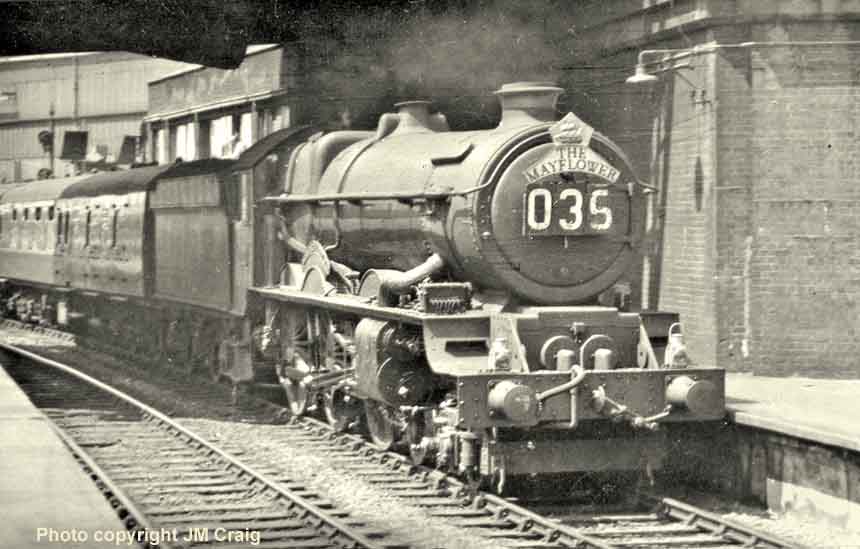
(Above) During 1959, ex-GWR 'King' class 4-6-0 No 6027 'King Richard I' arrives at Paddington Station with the Plymouth-London restaurant car express, nominated 'The Mayflower' from 1957, and now with its new evocative headboard and revised train reporting number '035' for the summer timetable from the '605' previously used. Still a Laira (83D) engine at this time, during its career No 6027 spent 11 years working from Plymouth, over 4 years at Newton Abbot (NA) and 16 at Old Oak Common (PDN and 81A) mostly from new. The front frames were changed on this engine in 1956, one of 14 engines so treated in total; this work involved a complete strip down of all components in order to cut through the frames on both sides at a point halfway between the first and second drive axles. The new half-frames, as they were termed, had to be optically aligned with the remaining rear sections before the two divisions were reset by welding. Some engines were recorded as being in Swindon Works for 4 or 5 months whilst the work was completed, as the boiler and axles had to be removed, all components checked for serviceability and reconditioned boilers fitted in all cases. The result of this extra work could only be verified by the change at the front of the engine; the lifting eyelets were reinforced with large flat washers and in almost all cases (except for No 6019) the originally short covers for the inside valves were extended in unison. Following withdrawal in September 1962, the engine was sold to Cox & Danks of Langley Green in the West Midlands, having achieved a splendid recorded figure of 1,836,535 miles.
BR MODIFICATIONS
1. New front frames, indicated by the large support washer on the frame end, now seen.
2. Extended covers for inside valves from new.
3. Modified outside steam pipes [1953].
4. WB boiler [06/53].
5. Fabricated double chimney 08/56 [later form fitted 03/58].
6. Mechanical lubrication unit [now in final position].
7. Leading bogie had welded repairs done [02/56].
8. Cab roof vents inserted [1954].
9. BR new emblem added [facing wrong way].
10. Raised step over the inside cylinders, below smokebox now added [08/56]. 
(Above) Ex-GWR 'King' class 4-6-0 No 6027 'King Richard I' is seen near the top of Hatton Bank, at John's Bridge, hauling the 1.10 pm from Paddington to Birkenhead on a bright Spring day in March 1962, the last year of operations for the mighty and magnificent 'King' class. It was not unusual to see steam billowing from the inner cylinders of these locomotives, as can be seen here, but records suggest that no Heavy General repairs were received since September 1959, only Light Casual maintenance being carried out at that time. However, from early in 1956 No 6027 was under repair at Plymouth Laira workshops during which the leading bogie was removed for major rectification work or renewal. The heavy workloads put on the 'King' class led to stress cracks of the bogie sideplates, which ultimately developed into a major setback for the whole class. The 'King' leading bogie does not have simple movement about a vertical point and must be free to slip sideways to some degree allowing the locomotive to follow curves accurately and some kind of springing mechanism has to be included to control this movement, but ensuring a return to its natural centre. Control of this lateral or sideways movement was paramount to the stability of an express engine moving at speed over curved sections of track and was achieved with the use of helical coiled springs compressed against a journal to a limit of 3.22 inches. A locomotive will always try to go straight ahead, a rigid form cannot adapt to a curve and has to have tolerances in place to allow the engine to successfully negotiate any bend. The sliding bogie of this type was patented by William Adams in 1865.
BR MODIFICATIONS
1. New front frames, indicated by the large support washer on the frame end, now seen.
2. Extended covers for inside valves from new.
3. Modified outside steam pipes [1953].
4. WB boiler [06/53].
5. Fabricated double chimney 08/56 [later form fitted 03/58].
6. Mechanical lubrication unit [now in final position].
7. Leading bogie had welded repairs done [02/56].
8. Cab roof vents inserted [1954].
9. BR new emblem added [facing wrong way].
10. Raised step over the inside cylinders, below smokebox added 08/56.
6028 King George V1 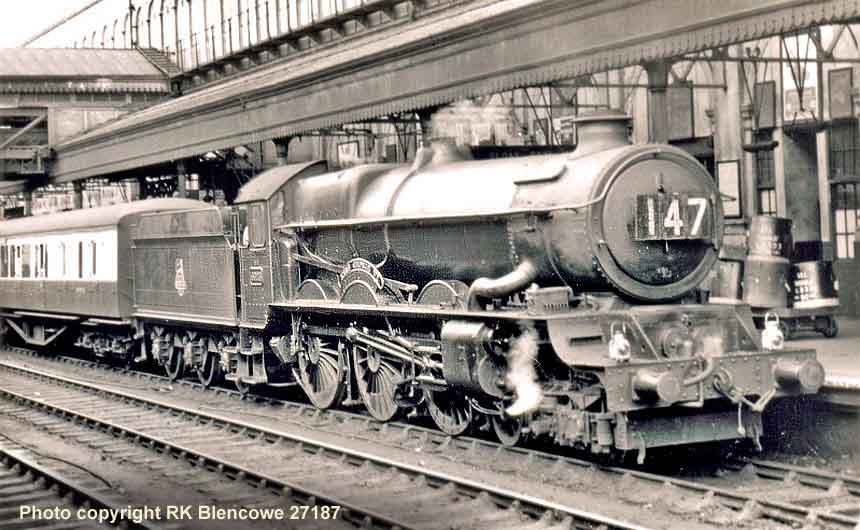
(Above) Ex-GWR 'King' class 4-6-0 No 6028 'King George VI' stands by the extravagant platform canopy at Exeter St. David's Station on a down train, which is to say it was from London Paddington, while the train reporting notation suggests an afternoon express to Plymouth. The locomotive is sporting the Brunswick Green livery, which was the third choice colour selected by BR after the dismal showing of 'Ultramarine' and the relative success of the 'Caledonian Blue', thus the date of this photo is estimated as the early part of 1954. A similar result is achieved if we assess the modified outside steam pipes and the lack of any cab roof vent, strongly indicating a date around the same mark. A single chimney with capuchon (a lip), said to prevent downdraught when in motion, can be seen and this was an original type which seems to have remained in situ until early 1957 with the addition of the cast-iron double chimney. The recorded dates for repairs at Swindon Works do suggest that the cab roof vents were not inserted until early 1955, when also the mechanical lubrication unit was moved to a more convenient position forward of the outside steam pipe. The recent damp weather has taken much of the shine off the paintwork, but the lower half of the boiler casing still shows up well the previous work done by Swindon; also of note is the relative low position of the British Railways legend on the tender emblem when comparing its alignment with the cabside number.
BR MODIFICATIONS
1. New front frames, indicated by the large support washer on the frame end, not ever seen.
2. Extended covers for inside valves from new.
3. Modified outside steam pipes [1953].
4. WB boiler [03/52].
5. Single chimney [double chimney fitted 01/57].
6. Mechanical lubrication unit [now in final position].
7. Leading bogie had welded repairs done later [01/56].
8. Cab roof vents inserted [1955].
9. BR early emblem added [later version from 02/58].
10. Raised step over the inside cylinders, below smokebox, in first stage only. 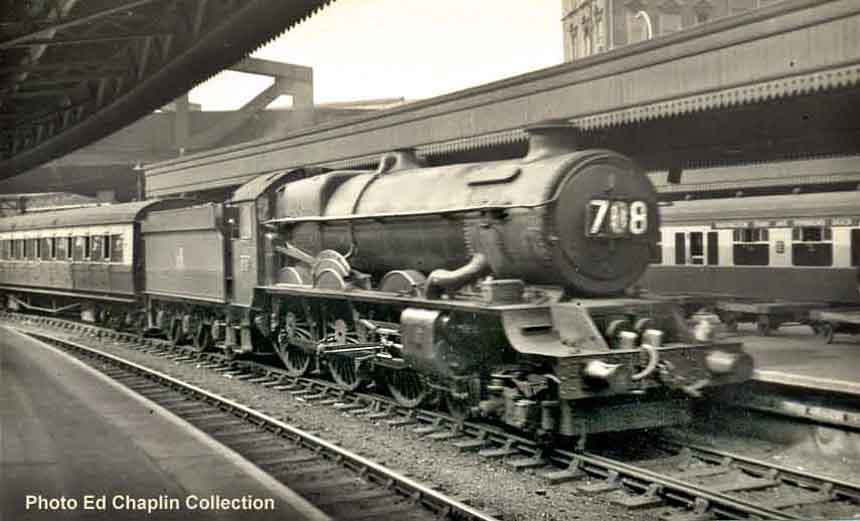
(Above) Reversing out of Paddington in 1955, ex-GWR 'King' class 4-6-0 No 6028 'King George VI' is assisting the shunting engine with the empty coaching stock, before 'dropping off' at Ranelagh Bridge service yard, or possibly it will make its way to Old Oak Common (81A) just over three miles to the West. The train reporting number seems to be a misnomer, for '708' is nominated as the 08.17 Carmarthen to Penance running on Saturdays only (see Ed Chaplin page 23). The leading bogie shows no signs of welding modifications (pre-1956) therefore the date is estimated as the early part of 1955, which indicates the engine was still allocated to Old Oak Common where it accrued 25 years of service. A reconditioned WB type boiler was added in 1952 when the livery was still Caledonian Blue, one of five 'Kings' to have the improved boiler and addition of a mechanical lubrication unit in the livery. The modified shape of the outside steam pipe shows up very well in this picture, although the actual pipework is hidden beneath the clever external casing, cosmetic as well as protective of crews and fitters. Also noteworthy is the diamond treadplate now added over the inside valve assembly; this was the first stage improvement of the original step from around 1950 which was further enhanced at a later date with a raised central section following the upgrading of the exhaust ports for the inside cylinders.
BR MODIFICATIONS.
1. New front frames, indicated by the large support washer on the frame end, not ever seen.
2. Extended covers for inside valves from new.
3. Modified outside steam pipes [1953].
4. WB boiler [03/52].
5. Single chimney still [double chimney fitted 01/57].
6. Mechanical lubrication unit [now in final position].
7. Leading bogie had welded repairs done later [02/56].
8. Cab roof vents inserted [1955].
9. BR early emblem added [later design seen from 02/58].
10. Raised step over the inside cylinders, below smokebox, not yet fitted. 
(Above) Having passed the arrivals signal box, ex-GWR 'King' class 4-6-0 No 6028 'King George VI' moves along platform 10 into London Paddington with a weekday train from Wolverhampton (Low Level) in what appears to be a late summer's day in 1959. The engine is almost in its final condition with BR's new emblem added to the tender (see item 9) and the newer straight buffers are in position, but again confirmation of the locomotive's identity is seriously hampered by the position of the Train Reporting Number frame obscuring the smokebox numberplate.
At this juncture, by way of an exercise in detection, we can see that the third digit of the front number plate is an '0' or a '2', followed by another rounded numeral, suggesting any of the following; another '0' or a '2' - '3' - '6' - '8' - or even a '9'. Thus the eleven 'Kings' that fit the clues are as follows: Nos 6000, 6002-3, 6006, 6008, 6009, 6020, 6022-3, 6028 or 6029. However, we can immediately discount No 6000 due to the absence of a bell. Now if we check the modification changes, we will find that all of the earlier engines had extended valve covers and frame repairs by this time (except for No 6019) and No 6022 also had a front half-frame fitted. This leaves us with Nos 6020, 6023, 6028 or 6029, from which we can only discount No 6020 due to it being a Stafford Road engine. On closer inspection of the original photograph, it is only possible to be certain that the name ends with 'VI' which indicates we are looking at No 6028 'King George VI', but again the exercise vividly illustrates how difficult it is to positively identify one 'King' class engine from another without accurate data - alas, more often than not, this becomes lost or distorted over the intervening years. However, on this occasion we are grateful to the photographer for accurately recording the detail of his shot for our benefit.
It is extremely rare to see, but the offside front corner has suffered a slight skirmish and the fallplate is very slightly turned upwards and maybe the engine was booked for a repair at Old Oak Common Workshops in the next few days. Its allocation at this juncture was still Old Oak Common (81A), but the engine had been elbowed out of its usual haunts by the new fleet of diesel-hydraulics which were hauling almost all expresses to the West Country. In just over 12 months No 6028 was off to Cardiff Canton depot (88A) where it completed its service.
BR MODIFICATIONS
1. New front frames, indicated by the large support washer on the frame end, not ever seen.
2. Extended covers for inside valves stayed original.
3. Modified outside steam pipes [1953].
4. WB boiler [03/52].
5. Cast-iron double chimney now added [fitted 01/57].
6. Mechanical lubrication unit [now in final position].
7. Leading bogie had welded repairs done [02/56].
8. Cab roof vents inserted [1954].
9. BR new emblem added [but facing to the right on offside].
10. Raised step over the inside cylinders, below smokebox. 
(Above) The penultimate class member, ex-GWR 'King' class 4-6-0 No 6028 'King George VI' presents a truly magnificent sight during a running-in turn at Swindon station; not only does the 29-year old engine look brand new, even the pristine headlamp have very likely been especially chosen by the crew to complement the locomotive. By this date, June 1960, all of the BR modifications can now be gleaned, including the new emblem which shows the 'lion' looking to the left and the later heavy duty buffers are in prime position. Throughout its career '6028' served Old Oak Common (PDN and 81A) for 25 years and just four at Newton Abbot depot, plus the engine spent 21 months at Cardiff Canton (88A), one of six 'Kings' to be allocated there from September 1960, the others being Nos 6003-4, 6018-9 and 6023; with Nos 6010 and 6024, joining them twelve months later. No 6028 was one of five 'Kings' sporting the earlier livery of Caledonian Blue when fitted with the new WB type of boiler and it was nearly 20 months before the BR livery choice of Brunswick Green was applied. One oddity of No 6028 is that it was the only 'King' to be scrapped at Birds of Risca, a town in Caerphilly, South Wales.
BR MODIFICATIONS.
1. New front frames, indicated by the large support washer on the frame end, not ever seen.
2. Extended covers for inside valves from new.
3. Modified outside steam pipes [1953].
4. WB boiler [03/52].
5. Cast-iron double chimney now [fitted 01/57].
6. Mechanical lubrication unit [now in final position].
7. Leading bogie had welded repairs done [02/56].
8. Cab roof vents inserted [1955].
9. BR new emblem added from 02/58 [now facing correct way].
10. Raised step over the inside cylinders, below smokebox. 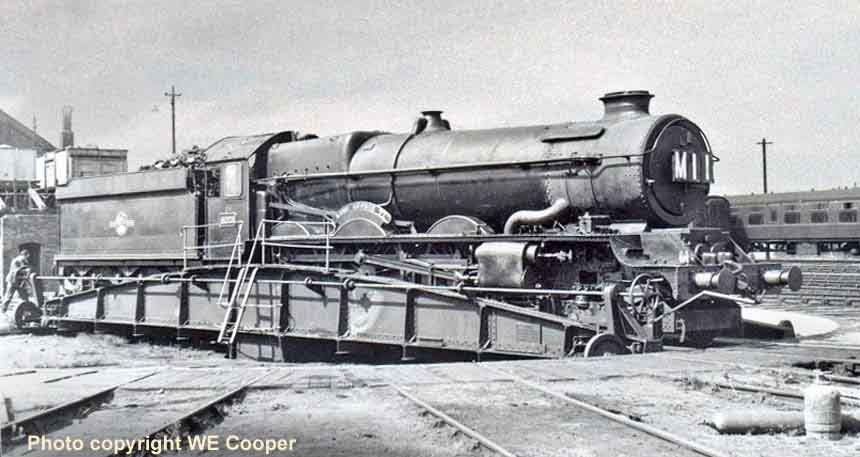
(Above) Ex-GWR 'King' class 4-6-0 No 6028 'King George VI' is being turned at Wolverhampton Stafford Road depot in readiness for a return to London during 1962, this being the very last of thirty five fruitful years for the class. The 'King' was in receipt of a Heavy General during a visit to Swindon Works between November 1961 and the first week of January 1962, before returning to its home shed of Cardiff Canton (88A). The engine entered Swindon Works again as late as April 1962, then returned to Cardiff, but only briefly before its transfer to Old Oak Common to be put into store. Throughout their distinguished careers, ten titled trains were regularly rostered for 'King' haulage and it is most likely that No 6028 will have powered at least nine of them, possibly missing out on the 'Devonian' on the section between Bristol and Paignton, as the locomotive spent only a relatively short time based at Newton Abbot shed. Rarely seen on any duty but top-link express passenger work, the 'King' class locomotives could be found hauling overnight newspaper trains, TPO Services and occasional milk trains, but often only prior to a visit to Swindon Works for scheduled maintenance. No 6028 was allocated to Old Oak Common (PDN and 81A) for a total of 26 years, starting out there and completing its service in Harlesden, although possibly it was in store for the last 3 months of its career. Infamously and unfortunately it was the engine involved in the fatal crash at Norton Fitzwilliam in November 1940, a derailment which resulted in the deaths of 25 passengers and the fireman.
BR MODIFICATIONS
1. New front frames, indicated by the large support washer on the frame end, not ever seen.
2. Extended covers for inside valves stayed original.
3. Modified outside steam pipes [1953].
4. WB boiler [03/52].
5. Cast-iron double chimney now added [fitted 01/57].
6. Mechanical lubrication unit [now in final position].
7. Leading bogie had welded repairs done [02/56].
8. Cab roof vents inserted [1954].
9. BR new emblem added [12/02/58].
10. Raised step over the inside cylinders, below smokebox [fitted 1956].
6029 King Edward VIII 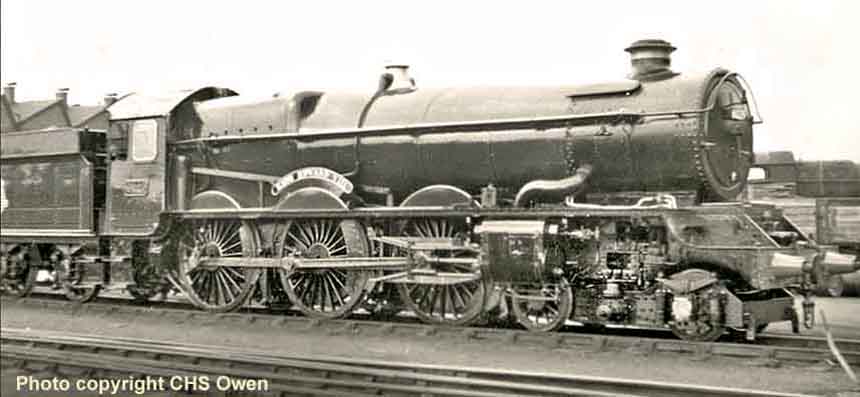
(Above) Smartly turned out, ex-GWR 'King' class 4-6-0 No 6029 'King Edward VIII' stands freshly 'shopped' at Swindon Works in October 1956; the locomotive is being prepared for running-in and final testing before its release back to Plymouth Laira (83D) depot where it was based for close on 20 years. When first built the engine was named 'King Stephen' and within the first few weeks of service it was displayed at Wavertree Park for the Liverpool and Manchester Railway centenary celebrations in September 1930, during which time the engine was serviced at the ex-Lancashire and Yorkshire depot at Agecroft in Manchester. The image gives the strong impression of an engine without any coal or water on board and it is sitting high on new (reconditioned) road springs, which would normally be changed when undergoing a Heavy General overhaul at the 'Factory'. It is very surprising that the engine emerged from Swindon with the single chimney still in situ, given that by this time twelve engines had already been upgraded to a fabricated type of double chimney and the new cast-iron version was available the following month The recorded accumulative mileage for No 6029 was 1,859,278, which was on a par with some of the class built three years earlier and much greater than No 6005 which had a longer life. The locomotive ended its service life at Old Oak Common (81A) following the arrival of the new diesel-hydraulic fleet which took charge of the West of England services from the Summer of 1959.
BR MODIFICATIONS
1. New front frames not ever seen.
2. Extended covers for inside valves added from new.
3. Modified outside steam pipes [1953].
4. WB boiler [10/53].
5. Single chimney still [fabricated double chimney 12/57].
6. Mechanical lubrication unit [now in first position].
7. Leading bogie has welded repairs done [02/56].
8. Cab roof vents inserted [1954].
9. BR original emblem added [new emblem on 18/12/57].
10. Raised step over the inside cylinders, below smokebox, now fitted. 
(Above) This fine elevated view of ex-GWR 'King' class 4-6-0 No 6029 'King Edward VIII', reveals that the offside nameplate is not attached, which, in view of the BR Western Region's policy of maintaining its 'King' class locomotives to a very high standard, is most unusual indeed. The perceived train reporting number '636' indicates a Cornish Riviera relief express that normally ran 10 minutes prior to the actual publicised express service, and although the location and date are a mystery, I would plump for Twyford, during early Summer 1957. We also have a good view of cab vent in use and the sleeved single chimney, which was replaced with a fabricated double chimney in December 1957; this is very odd because 22 engines had already received the new type cast-iron double chimney starting from November 1956. The quite unusual position of the outside cylinders was really governed by the fixed position of the inner cylinder block and the resulting length of the inner connecting rods (driving the first axle) dictated the dimensions of the outer rods and thereby fixed the placement of these outer cylinder assemblies. Also the length of the piston stroke was set by C.B. Collett at 28 inches, as opposed to the 30 inches used by a total of 545 GWR and ex-GWR 4-6-0 locomotives. This decision, in turn, created an urgent need for new crank axles to be made; a 14 inch throw was now the requirement giving 28 inches of travel instead of the usual 15 inches; this resulted in 30 inches of piston displacement, as well as the new patterns to be made for the altered size of drive wheels. Having reset the dimensions at 6ft 6in enabled Collett to attain the required tractive effort of over 40,000 lbs as requested by the General Manager of the Great Western Railway (1921-29) Sir Felix Pole.
BR MODIFICATIONS
1. New front frames, indicated by the large support washer on the frame end, not seen.
2. Extended covers for inside valves seen from new.
3. Modified outside steam pipes [1953].
4. WB boiler [10/53].
5. Single chimney [fabricated from 12/57 and new double chimney fitted 05/59].
6. Mechanical lubrication unit [seen in first position].
7. Leading bogie has had welded repairs done [02/56].
8. Cab roof vents inserted [1954].
9. BR early emblem added [new version from 12/57].
10. Raised step over the inside cylinders, below smokebox.
SUMMARY OF MODIFICATIONS TO KING CLASS LOCOMOTIVES
1. - Fourteen engines had front half-frames fitted from September 1954. These were Nos 6000, 6002, 6004, 6005, 6007, 6008, 6009, 6012, 6013, 6015, 6016, 6017, 6022 & 6027.
2. - Seven engines did not have the inside valve covers changed from their original short form, these were Nos 6001, 6003, 6006, 6010, 6011, 6014 & 6018.
3. - NineKings were seen with extended inside valve covers without having modified front half-frames; these were Nos 6019, 6020, 6021, 6023, 6024, 6025, 6026, 6028 & 6029.
4. - Fifteen Kings were fitted with the early fabricated double chimney from 1955 onwards, these were Nos 6001, 6002, 6005, 6006, 6007, 6009, 6010, 6011, 6013, 6015, 6017, 6020, 6022, 6027 & 6029.
5. - No 6015 was first to have a fabricated double chimney and last but one to receive the cast-iron version.
6. - No 6004 was the first King to have an elliptically shaped cast-iron double chimney fitted and seen from November 1956.
7. - No 6013 was first to undergo replacement of front half-frames.
8. - Nine engines had a fabricated double chimney applied seen with new front half-frames whereas only 4 Kings were seen without new frames or extended valve covers when so fitted. These were Nos 6002, 6005, 6007, 6009, 6013, 6015, 6017, 6022 & 6027 and 6001, 6006, 6010 & 6011, respectively.
9. - Of those nine engines, six were modified at the same time as the front half-frames, with the remainder having the early type double chimney added later. These were Nos 6002, 6007, 6009, 6015, 6017 & 6027 and 6005, 6013 & 6022, respectively.
10. - No 6019 was the exception to the general rule that half-frames were fitted along with extended valve covers.
11. - No 6029 was the exception to the general rule that the fabricated double chimney was only fitted between September 1955 and September 1956.
12. - No King had replacement front half-frames without also having the extended valve covers.
13. - The mechanical lubrication unit was always fitted in addition to the change to a WB boiler.
14. - Four different liveries were used by the class, though only 4 engines displayed all of them. These were Nos 6001, 6009, 6025 & 6026.
15. - Eighteen Kings had the new BR emblem applied after their double chimney was fitted. These were Nos 6000, 6001, 6002, 6004, 6005, 6006, 6007, 6009. 6010, 6011, 6013, 6015, 6017, 6020, 6021, 6022, 6027 & 6028.
16. - The remaining twelve class members had the two jobs carried out in unison. These were Nos 6003, 6008, 6012, 6014, 6016, 6018, 6019, 6023, 6024, 6025, 6026 & 6029.
KING TENDER No 2815 SEARCH
It would be easy to believe that an engine remained coupled to a particular tender for many years, but as the table below shows 8 different Kings were given unit No 2815 for much shorter durations.
6003 : 12.41 to 03.44...........Swindon Works. 
6027 : 03.44 to 05.45...........Swindon Works.
6015 : 05.45 to 10.52...........Swindon Works.
6007 : 10.52 to 04.54...........Swindon Works.
6011 : 03.55 to 03.57...........Swindon Works.
6019 : 04.57 to 08.57...........Swindon Works.
6011 : 08.57 to 09.57...........Stafford Road.
6020 : 10.57 to 08.59...........Swindon Works.
6027 : 09.59 to 03.61...........Swindon Works.
6016 : 11.61 to 09.62...........Swindon Works.
(Right) A rear view of No 6011 King James I at Chippenham following a studious overhaul at the Swindon 'Factory'; this included a change of tender to another 4,000 gallon capacity Collett type and thus it received the new version of BR's Corporate emblem dated from June 1957. The tender was further changed early in August and also in the middle of September, suggesting that Wolverhampton Stafford Road shed was experiencing difficulties with its fleet and resorted to swapping tenders with others heading off to Swindon Works (quite normal practice). Official records show that No 6019 'King Henry V' had received a Heavy General in April 1957 and was coupled to a different tender - No 2815, but this was given up in August that year and in return gained tender No 2922 from '6011', an example of how unexpected problems were overcome in order to keep the trains running.
A GALLERY OF KINGS 
(Above-Below) In 1928 the Great Western Railway placed an order for seven Pullman cars - four Kitchen Cars and three Parlour Cars - for use on a new train called the 'Torquay Pullman Limited' which made its inaugural run on 8 July 1929. The train ran two days a week between London Paddington and Paignton, stopping at Newton Abbot and Torquay only, however due to a lack of commercial success the full Pullman train was reduced to a 3-car service in the 1930 summer timetable while the remainder of the train was made up of ordinary coaching stock. The decision was finally taken to terminate the service altogether and the Pullman cars were sold to the Southern Railway the following year. The Pullman train is captured here in the capable hands of a nearly new 'King' No 6010 King Charles I of Laira depot. The early date is confirmed by the original higher position of the top lamp iron and the intermediate footstep on the smokebox. (Below) Much of the hard work has been done by the crew of King class No 6021 King Richard II as it makes its way through Witham in Somerset with a Plymouth-Paddington express. The early 'British Railways' logo is prominent on the tender and serves to remind us that the date is 1949, eight years before the title 'Mayflower' was applied to this service.
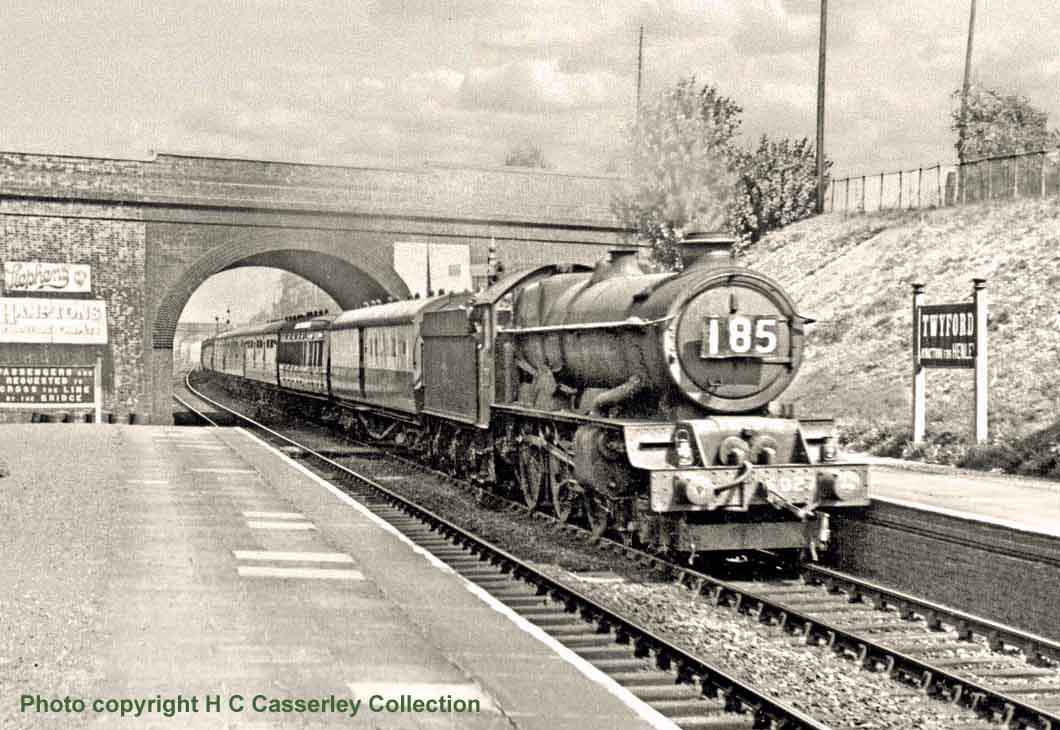
(Above-Below) 6027 King Richard I of Laira speeds through Twyford station with train 185, the 1.30pm Paddington to Penzance in 1950. Twyford is the junction for the Henley branch exactly 31 miles from Paddington and soon the 'King' will have to slow for the stop at Reading before diverging on to the Berks & Hants line to Reading West, Newbury and beyond. The next stop then is Westbury at 3.18pm followed by calls at Taunton, Exeter and Newton Abbot before reaching Plymouth at 6.25pm. No 6027 will then be replaced by another 4-6-0 to take the train on to Penzance for an arrival time of 9.15pm. (Below) Identity of this particular 'King' class was somewhat complex but the morning service from Paddington to Falmouth and Newquay was a regular duty for the powerful Class 8P locomotives. The train is passing Charlton Mackerell behind No 6016 King Edward V in typical post-war era condition. 

(Above-Below) An unusually smoky scene on the coastline at Dawlish is the result of 'King' class No 6001 King Edward VII making haste with an Up service towards London in 1953. The use of carriage roof destination boards in 1929 preceded the introduction of the GWR's train identification numbers giving passengers a visual reminder of the train they are boarding. (Below) 6029 King Edward VIII of Laira heads the Up 'Cornish Riviera' through Savernake (Low Level) station on Bank Holiday Monday 4 August 1952. On arrival at Savernake the engine has reached the top of the 27 mile climb from Westbury and it is now downhill or level running for the remaining 70 miles to Paddington. A lot of signal arms are to be seen controlling both the main line and the start of the Marlborough branch curving away to the right where it joins the M&SWJR line at North Savernake, just a half mile away. Note both arms of the starter signals are centre-pivoted. 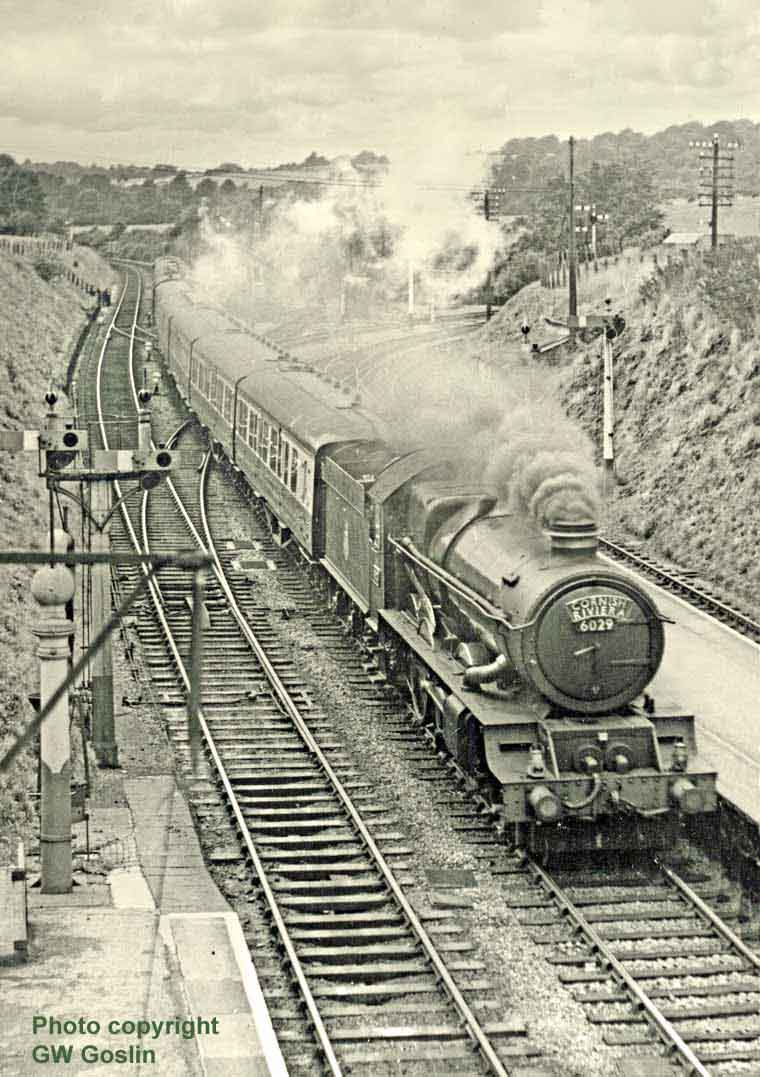

(Above-Below) No 6017 King Edward IV of Laira shed proudly displays the special coronation crown and EIIR fitment above the 'Cornish Riviera' headboard as the locomotive departs Paddington in a stately manner. In the period shortly before the Coronation of HM Queen Elizabeth II, some titled trains carried these fitments in this manner. The 7th Monday after Easter Monday, May 25th 1953, should have been Whit Monday, as per tradition, but as the Coronation Day was set for Tuesday June 2nd, Whit Monday was deferred for one week to June 1st so as to give four consecutive days of bank holidays. It is possible this photograph is dated Monday May 25th 1953 which was the first day these fitments were displayed. (Below) King class 4-6-0 No 6010 King Charles II heads the 11.30am SX Paddington - Penzance between Reading West and Southcote Junction on Monday 2 July 1956. Introduced to traffic in April 1928, 6010's first shed was Laira, followed by Newton Abbot in December 1929, then back to Laira in February 1930 before moving to its final shed at Old Oak Common in April 1959. Withdrawal came in June 1962, with a final mileage of 1,928,258. 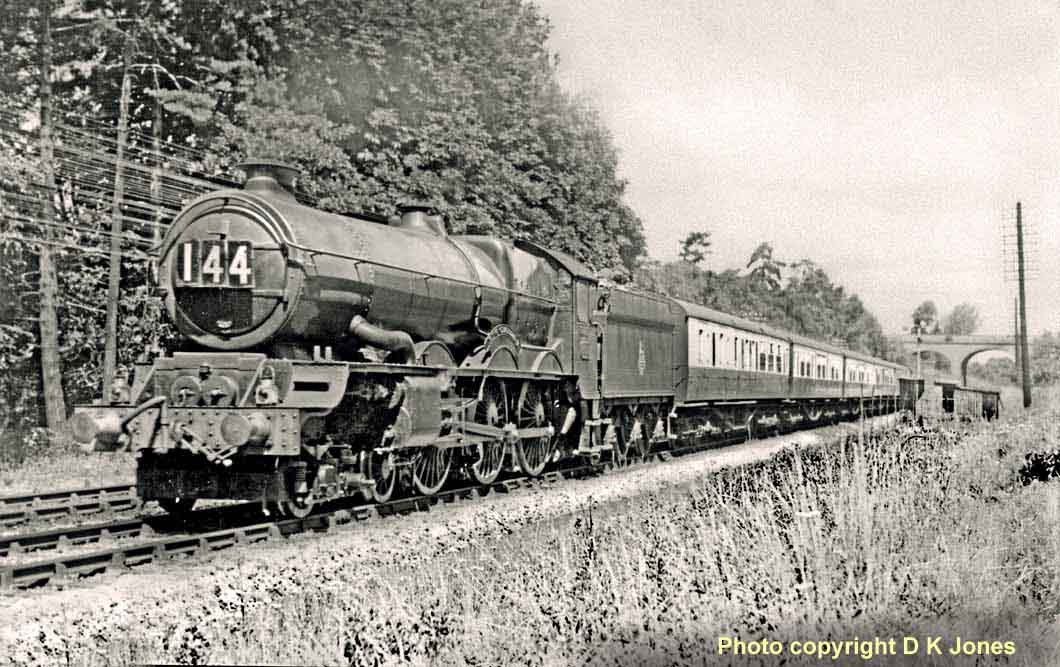
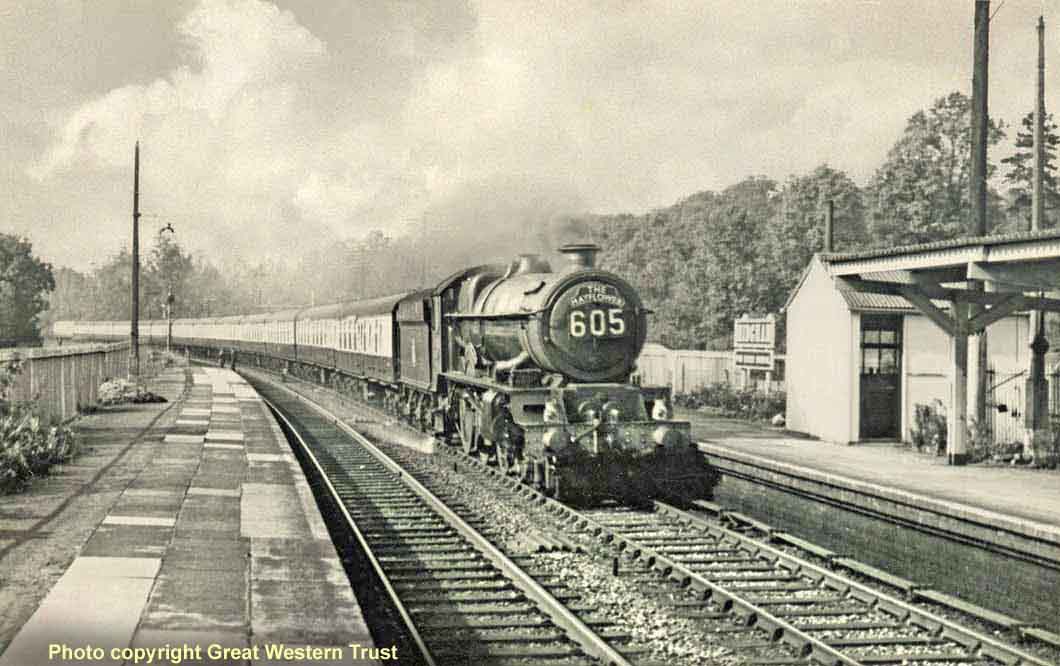
(Above) Shortly after having a double chimney fitted in April 1957, No 6003 King George IV of Old Oak Common is enjoying the gentle down gradient of 24 miles from Savernake as it heads train 605, the 13-coach 8.30am Mondays to Saturdays Plymouth to Paddington 'Mayflower' through Midgham station in Berkshire with some 46¾ miles still to go before arrival at Paddington, due there at 1.25pm. Note the workmen on the Down line despite a train being signalled. Between August and September 1960, No 6003 went with five other Kings to Canton, where it ended its days in June 1962 having clocked up 1,920,479 miles. Photograph is by Great Western Trust. Click HERE to visit the excellent Great Western Trust's website. Didcot Railway Centre is the home of the Great Western Society…a must visit place for all WR fans.
Below) 6026 King John of Laira shed heads the newly-titled 'Cornish Riviera Limited' past the attractive hamlet and lock on the Kennet & Avon Canal at Little Bedwyn, near MP65 on Sunday 24 June 1956. The next stations it will pass on its journey west will be Bedwyn, Great Bedwyn, Grafton East, where there are junctions with the Midland & South West Junction Railway, (M&SWJR) at Wolfhall Junction and Savernake (Low Level), East and West. The nearby station on the M&SWJR line is Savernake (High Level). Photo is in the RK Blencowe archive Ref EFG472. 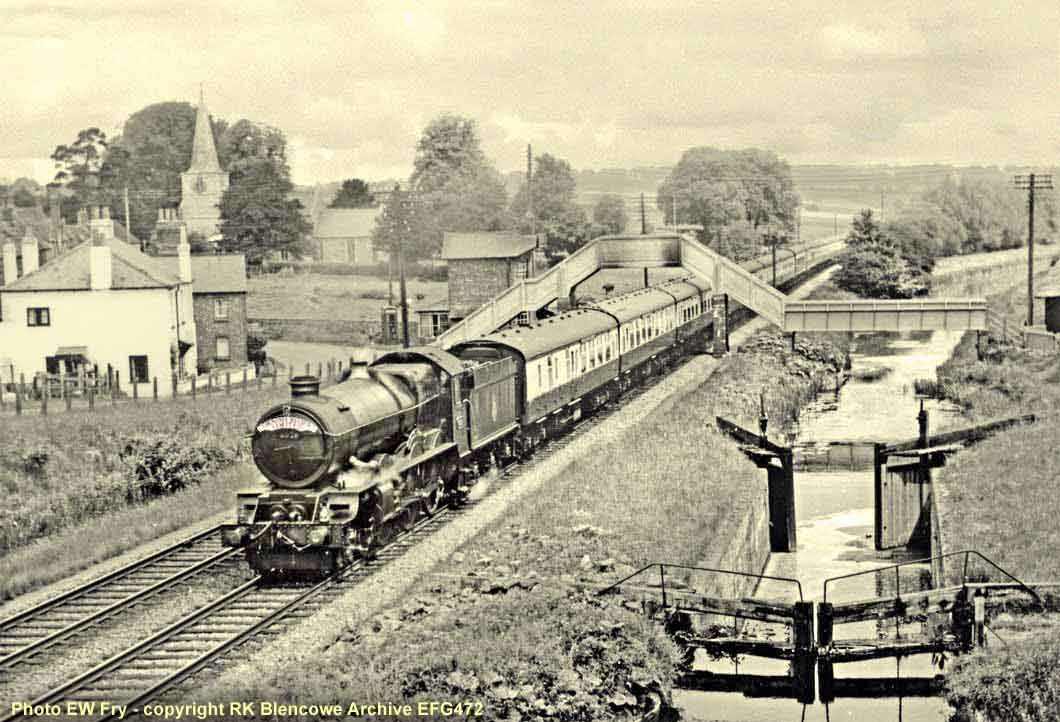
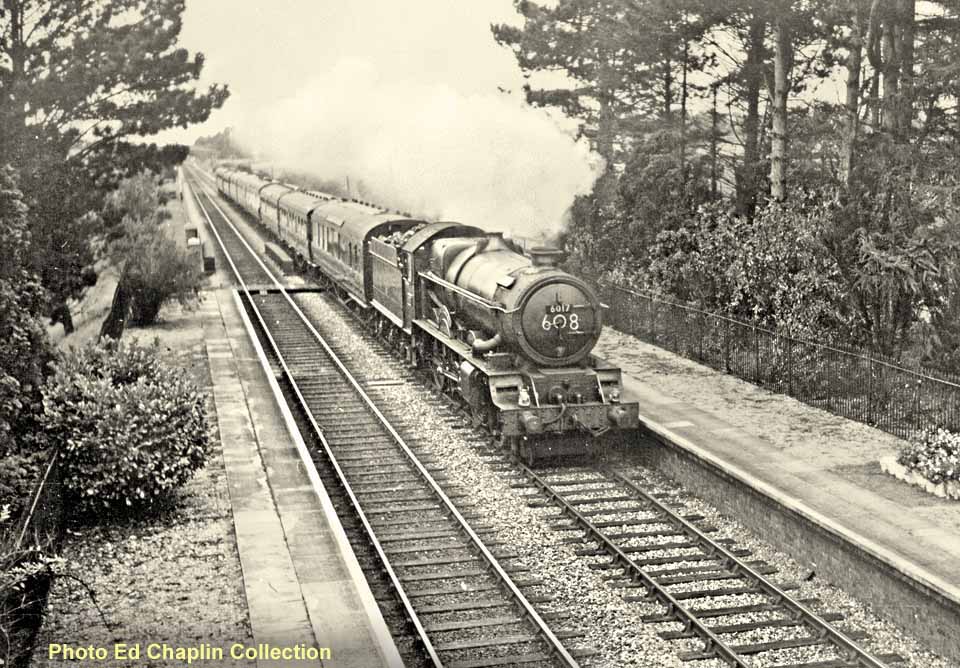
(Above-Below) On a date in the mid-50s No 6017 King Edward IV heads through Keinton Mandeville with train 608, the 6.25am SX Penzance-Paddington, due to pass here at about 12.55pm with arrival at Paddington at 2.50pm. This was the first express train of the day to London out of Penzance, and had extra coaches added at Plymouth including a restaurant car. Many stretches of this route between Taunton and Savernake enabled the 'King' and 'Castle' class locos to show their speed capabilities. OS Nock tabulated many such runs which can be found in his fine book 'Locomotive Practice and Performance'. (Below) 6029 King Edward V111 makes an admirable attempt to conquer the arduous and challenging climb at Grafton Curve on the approach to Savernake. The 'Cornish Riviera Express' was the staple diet of the Kings, but on occasions the express was hauled by a 'Castle' class locomotive, dependent on the loading of the train. 
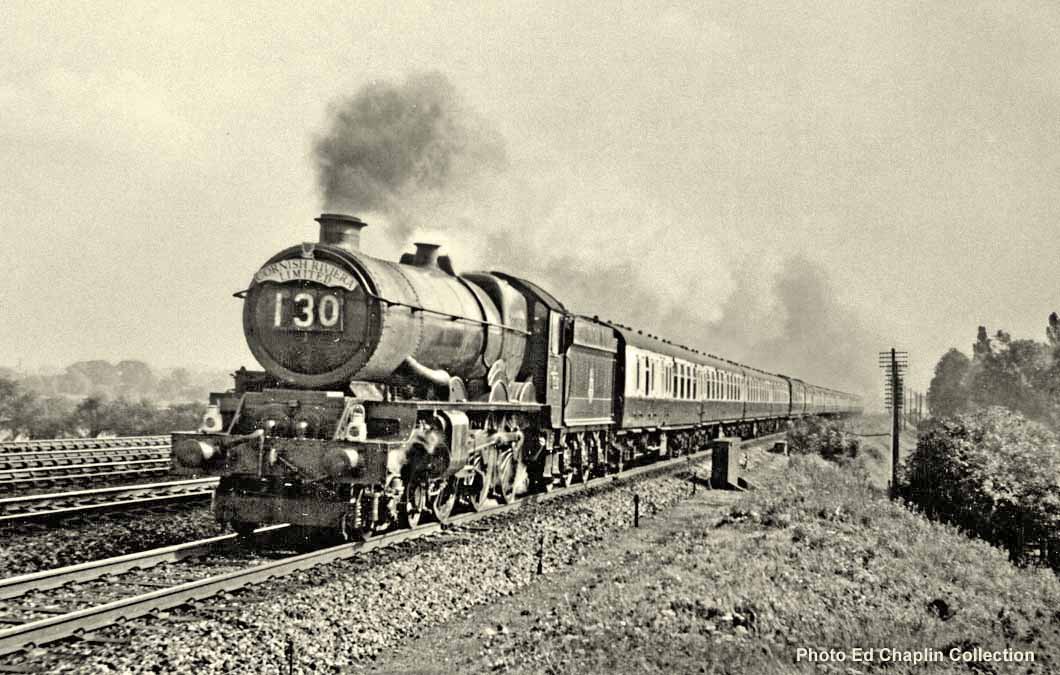
(Above-Below) Newly-fitted with a double chimney in June 1956, 6013 King Henry VIII of Old Oak Common is seen approaching Iver with the Down 'Cornish Riviera Limited' on Saturday 8 September 1956. Although known to Great Western railwaymen as 'The Limited', the train was generally regarded by the public as the Cornish Riviera Express. On 11 June 1956, the Western Region changed its name to Limited, and a set of new headboards were cast, however fifteen months later there was a change back to 'Express' from 10 September 1957 and the previous headboards were resumed. What a strange exercise with, as ever, the cost born by the taxpayer. (Below) 6004 King George III of Laira, now fitted with a double chimney in November 1956, heads the Down 'Cornish Riviera Limited' through Sonning cutting in March 1957. The express has been diverted to the relief line due to engineering works on a Sunday. The Winter timetable allowed 70 extra minutes for this train to reach Plymouth, as there were stops at Exeter St David's and Newton Abbot, notwithstanding the certainty that some form of engineering works will threaten to interfere with time-keeping along the 225½ mile journey. Also there would be a diversion via Bristol if major repair work was in hand between Reading and Taunton. 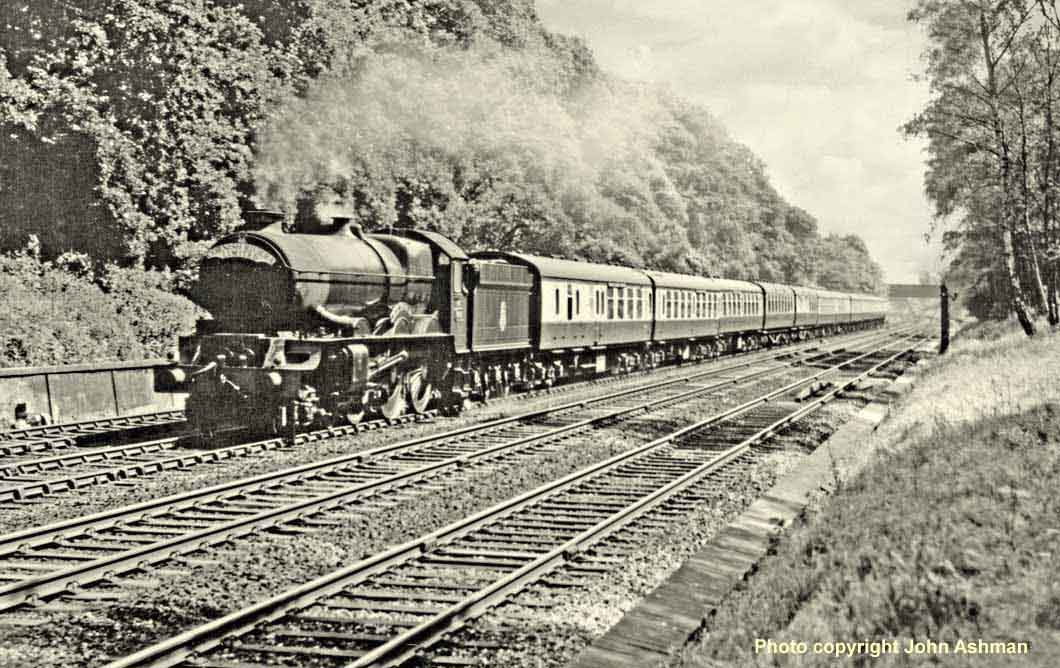

(Above) No 6000 King George V powers away from Kensal Green on its way to Birmingham and Shrewsbury in 1962; it is currently using the main line to the West of England and will have to manoeuvre at some stage to regain the 'Birmingham Line'. Ed Chaplin, who kindly sent me the photo for inclusion in this gallery, accompanied it with his own comments. He wrote - 'This is a more interesting picture than it seems. The photo was taken on Saturday 2 June 1962, and 6000 King George V is passing with the Down Cambrian Coast Express on the Down main (West of England) line. RC Riley writes in Trains Illustrated Summer Annual No.2 'trains from Paddington to the Birmingham line usually cross to the Down Relief line at Subway Junction (0m 76 ch); occasionally they cross at Ladbroke Grove (1 m 65 ch) and sometimes as far as Old Oak Common West (3 m 24 ch) before crossing over...' I have inserted the distances from Paddington in miles & chains...also bear in mind that this photo is taken 2½ miles out, so it will be the third alternative above that applies to this train, assuming it doesn't go as far on the Down Main as the West Ealing Loop line, to about MP6¾ then join the Birmingham line just before Greenford, 7¾ miles out of Paddington, which is feasible if its aim is to avoid a blockage between North Acton and Greenford…' Old Oak Kings played a leading role on this working, but all such engines were barred from going beyond Wolverhampton (Low Level) until April 1959 when bridge strengthening work at Shifnal and improvements to platform clearances at Codsall station had been carried out.
(Below) 6023 King Edward II of Old Oak Common is passing through Patney & Chirton station in April 1958 with the 6.25am SX Penzance to Paddington, due there at 2.50pm. Following arrival in the capital the loco will be turned at Ranelagh Bridge and perhaps returning to Plymouth later in the day, a round trip of 454 miles, including to and from North Road and Laira MPD. On the right is the platform for trains on the old single track line to Devizes. The station was rebuilt in 1900 as part of the building of the Stert Valley line via Lavington. 

(Above-Below) 'King' class 6019 King Henry V departs Weston-super-Mare on Friday 5 July 1957 with train 154, the weekday 4.15pm Paddington-Plymouth express via Bristol. Fifteen minutes past the hour from Paddington was a frequent start time for expresses travelling to Bristol, as against half past the hour for trains taking the direct route to the West. 6019 spent all the Fifties based at Old Oak, and went to Canton in September 1960 when WR policy was that the new D6XX and D8XX diesels were to haul West Country trains. The six Kings moved to Canton (all from 81A) in September 1960, but their arrival didn't immediately cause any of the twelve Canton Britannias to be passed on (yet) to the London Midland Region. Canton simply lost three Castles (4073, 4084 and 5095) in exchange for the six Kings (6003, 6004, 6018, 6019, 6023 and 6028). When 6019 was withdrawn from 81A in September 1962, it had clocked up a mileage of 1,912,309 since new in July 1928. (Below) The picturesque setting at Cowley Bridge Junction was often disturbed by the thunderous roar of steam-hauled express passing by to and from Exeter; on this occasion King class No 6003 King George IV rumbles by with TN 144, a late morning service from Paddington to Penzance. 
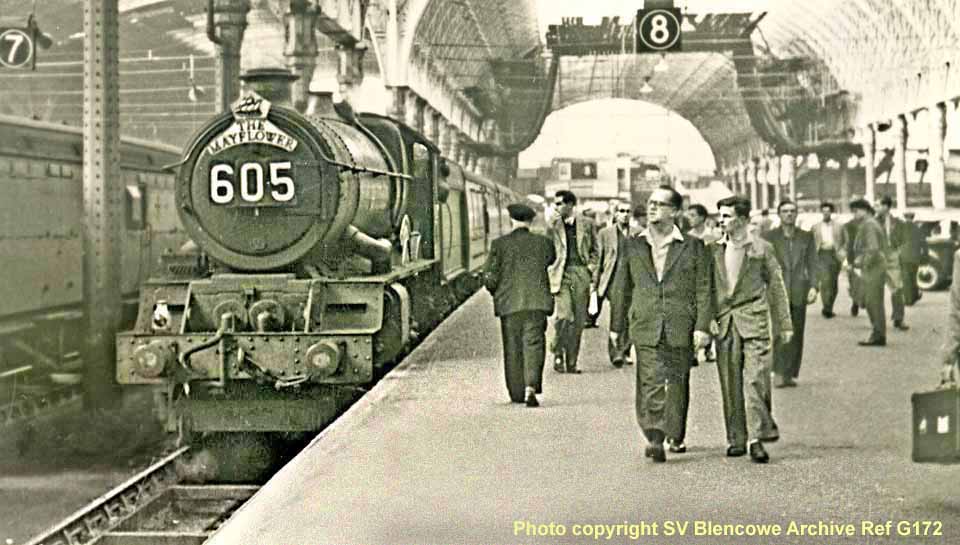
(Above-Below) 6026 King John of Laira shed has arrived at Paddington platform 8 and passengers alight from the newly titled 'Mayflower' restaurant car service (08.30 from Plymouth, due in London at 1.25pm) as seen in July 1957. Paddington's platforms 7 to 12 were the usual arrival platforms but platform 7 seems to be used for something else today. At the far end was a one way road leading to a cab rank between platforms 8 and 9, enabling passengers to get a cab in the dry beneath the station roof. A similar facility was provided between platforms 10 and 11. The locomotive may well return west with the down service departing at 17.30 bearing the train reporting number '157' consisting of coaches for Kingswear which will be removed at Exeter St Davids. (Below) This lovely rear view shot of No 6006 King George I at Banbury station with a London service adequately summarizes the lofty status of these locomotives. The engine was a Stafford Road favourite for almost 32 years and would most certainly have accumulated in excess of 1,250,000 miles on this route between Wolverhampton (Low Level) and Paddington. 
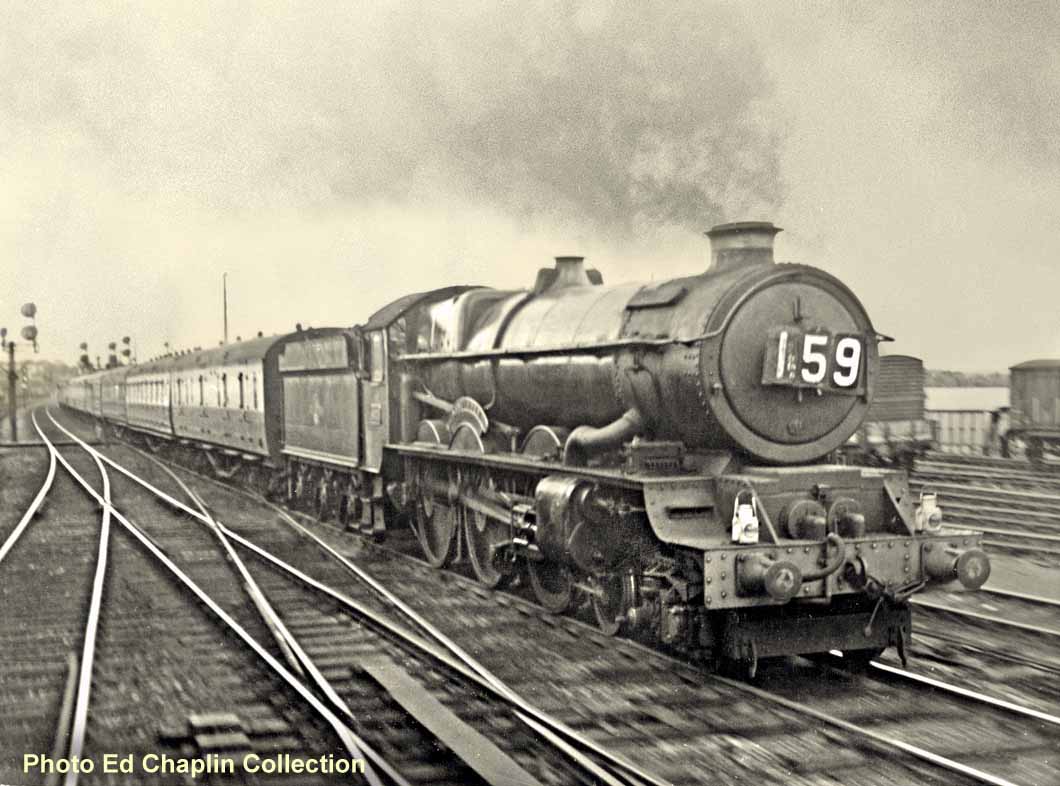
(Above) Ed Chaplin kindly sent me this photo for inclusion in the gallery. He wrote - 'This is another picture from a unique viewpoint that came to me with no details except the loco is 6026 King John. As 6026 had a double chimney fitted in March 1958, the date can only be in mid-1958, and the train is the Weekdays 6.30pm Paddington to Weston-Super-Mare. But where is it? I think it only can be where the Down relief line turns away after Old Oak Common West box, at the start of the line to the Midlands. 6026 was a Laira loco at the time, and was withdrawn from Old Oak in September 1962. The intrepid photographer seems to have been between the Up and Down Birmingham (relief) lines, new in 1903...'
(Below) This truly wonderful picture of a 'King' skimming over Rowington troughs near Lapworth in May 1960 is from the files of Warwickshire Railways.com. Identification of the locomotive and working was not straightforward, but with the aid of digital technology, the engine is seen to be No 6011 King James I of Wolverhampton Stafford Road (84A) depot and the train is the early morning departure from Shrewsbury, destined for Wolverhampton (Low Level), Birmingham Snow Hill and arrival at Paddington at 11.05am, dated May 1960. 

(Above) A splendid view of well kept King, No 6016 King Edward V, having arrived at Leamington Spa on its way north along the 'Birmingham Line' and still creating interest among the spotting fraternity, most likely because the end of the road was nigh and the locomotive will soon be withdrawn from service and no longer gracing the beautiful old station, still displaying its flower tubs and old gas lamps.
(Above) King class No 6014 King Henry VII heads a Down express near Cullompton Devon in 1936. Legend has it that the erudite Chief Mechanical Engineer of the GWR, Charles Benjamin Collett, was not enamoured by the prospect of the company 'streamlining' one of his beloved 'King' class locomotives. The decision was taken by the GWR's Directors' to satisfy their need to be in vogue and to share in the limelight of publicity they believed would ensue. The perceived desecration of No 6014 took place in the early months of 1935, swiftly followed by No 5005 Manorbier Castle which endured a similar fate. Thankfully, the full encumberment of cylinder and steam pipe fairings only lasted five months, while the additional 'bullet nose' remained until the end of 1942, giving rise to two additional fittings being added - an extra grab handle on top of the smokebox and a cleat fitted over and in front of the inside cylinder lubrication container. The supplementary handle aided the crew to release the nose-cone and the cleat gave an alternative fixing for the reporting number frame which came into use in 1935. From a mechanical standpoint the adaptations were only beneficial when moving into a headwind and even then the actual gain was minimal. From the aesthetic catastrophe that was the first seen alteration, the view here reflects a more acceptable appearance, if rather different to the norm, which remained unaltered for a little over seven years. The single section wheel splashers were returned to three conventional covers in 1944, but the distinctive wedge-shaped cab remained to the end of the engine's service life in 1962.
(Below) Plymouth Laira (83D) depot was second only to Old Oak Common (81A) in its importance to GWR operations and this work-stained King No 6017 King Edward IV displays all the poise and power required to move heavy trains between Plymouth and London. 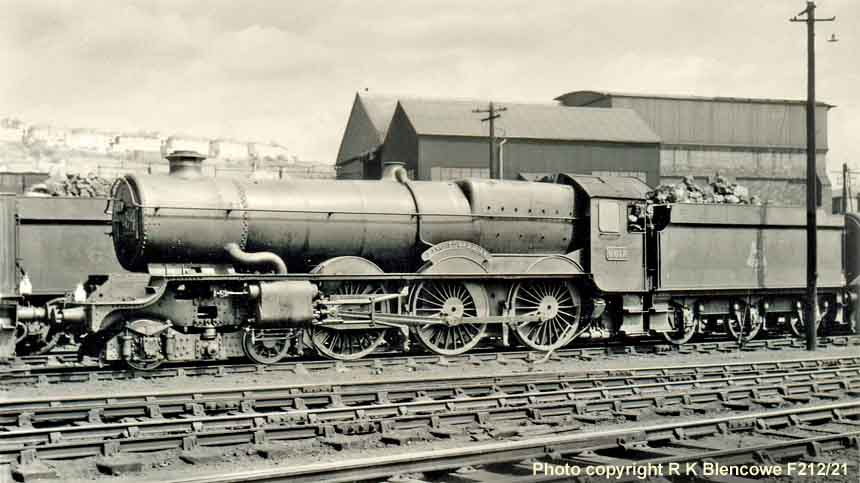

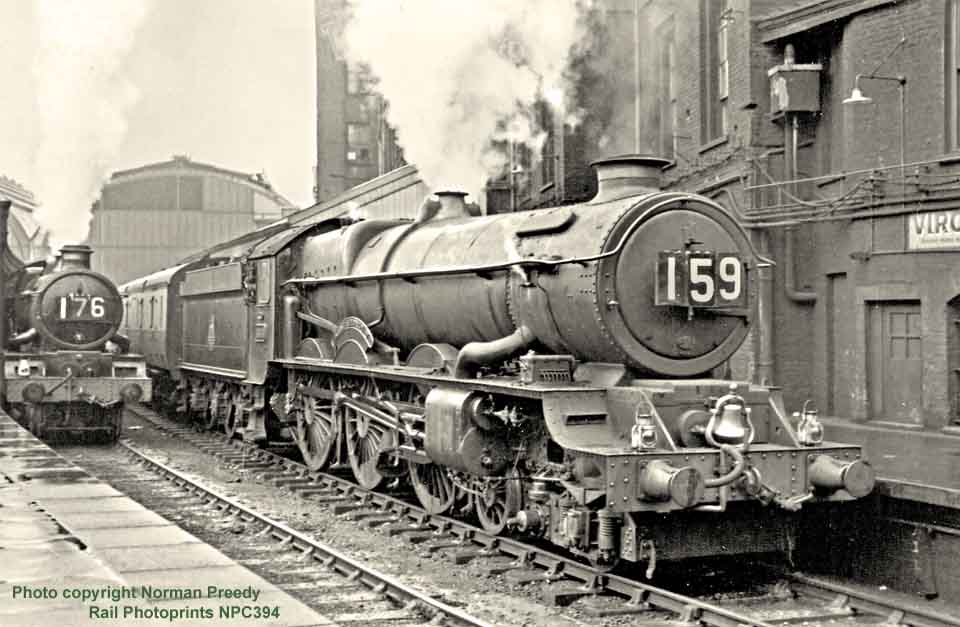
(Above-Below) It seems fitting to end this page as we started by featuring three shots of the doyen of the class No 6000 King George V, now among the lcomotives enjoying celebrity status in preservation. Though we may have wished to think otherwise, No 6000 was not always turned out in sparkling condition and we commend Norman Preedy for capturing the moment for our benefit. The easy grades from Paddington to Bristol will doubtless cause no issue for the engine or crew as they prepare to start the dash to the West. (Below) On Wednesday 12 June 1957, 6000 King George V of Old Oak Common takes the Down Cornish Riviera Express under the double track flyover after Kensal Green gasworks, 2¼ miles out of Paddington. This flyover was used for the movement of light engines and empty stock to and from Old Oak Common and Paddington. 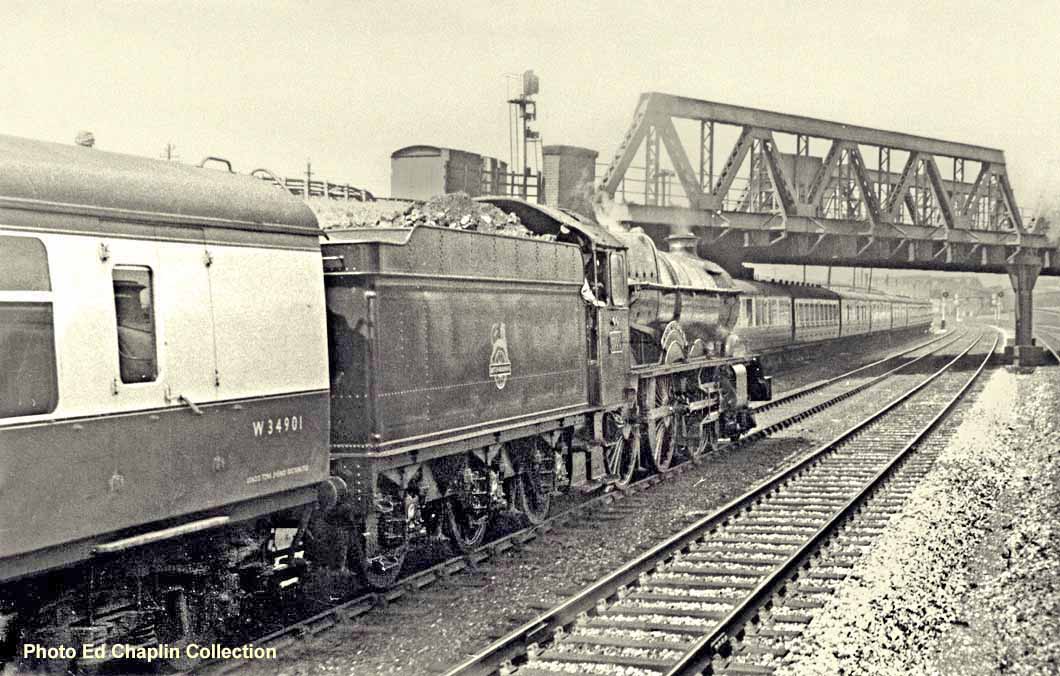
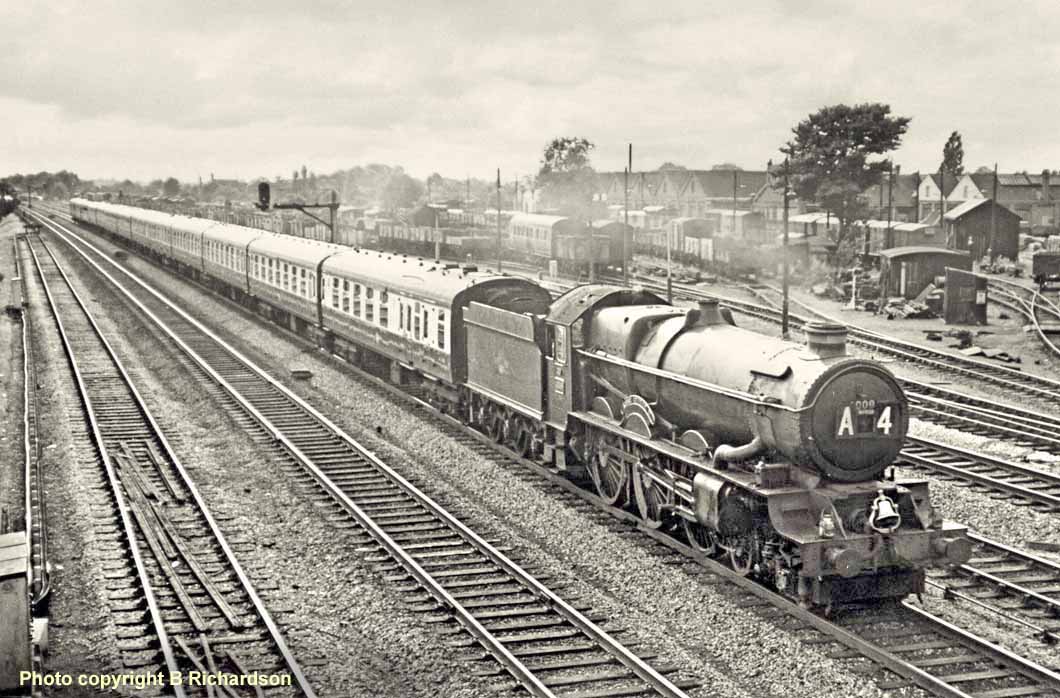
(Above) 6000 King George V approaches West Ealing on Saturday 4 August 1962 with train A74, the 1.50pm SO from Bristol, due Paddington at 4.30pm. The train consists of a uniform rake of Mk1 coaching stock and a very creditably clean locomotive at speed, showing that even at this late hour (for the King class) this ageing engine can still pull some punches and compete with the newer diesels. Rather odd that for once we can easily view the front numberplate, because of the missing number '7' from the reporting number, but the omnipresent bell tells all!
THE RAILWAY PHOTOGRAPHS ON THIS PAGE
RAIL PHOTOPRINTS - The Rail Photoprints collection is a labour of love for John Chalcraft, who has taken many hours producing high quality images from transparencies and negatives that photographers were unable to achieve in the old days of the photographic dark room. However john is constantly seeking new material either to purchase or to work with the photographer on a 'Royalty' basis paying a set fee for sales of any prints produced from his work; in such instances the photographer retains ownership and copyright. For further details e-mail John Chalcraft at john.railphotoprints@googlemail.com or you can write to him at 'Stoneycombe', 8 Paulmont Rise, Temple Cloud, near Bristol, BANES, BS39 5DT. Visit the Rail Photoprints website HERE
RK BLENCOWE - My thanks to Rod Blencowe for his generous help in filling the gaps of my own collection. Over the years, Rod's negative archive has swelled to become one the most important collections in the country; not only is the archive regarded a valuable resource for publishers, railway enthusiasts and historians, his high quality images are readily available to all collectors.
If anyone requires traditional photographic prints or any other photographic services, Rod Blencowe's email address is: r.blencowe@ntlworld.com Please note this is not a 'clickable' link via Outlook Express. You will have to email manually.
SV BLENCOWE - This page also features photographs supplied by Stewart Blencowe, who has a superb archive of black & white postcard-sized photographs of locomotives from both the pre-Grouping and 'Big Four' eras. Many pictures are from his own negative collection and can only be purchased direct from him, either by visiting his website HERE or via selected railway book fairs, auctions and Open Days…the venues are listed on his website. Stewart has more than forty years of successful trading in all manner of railway items from secondhand books, photos and timetables to ephemera and railway minutia, relics, tape recordings models and miscellania. Postcard size prints can be ordered at £1.50 each including packing and postage.
Stewart's email address is - stewart.blencowe@btopenworld.com - Please note this is not a 'clickable' link via Outlook Express...you will have to email manually.
Polite notice: All text and photographs are protected by copyright and reproduction is prohibited without the prior consent of the © owners. If you wish to discuss using the contents of this page the email address is below. Please note - this is not a 'clickable' mail-to link via Outlook Express. You will have to email manually.
dheycollection@ntlworld.com

